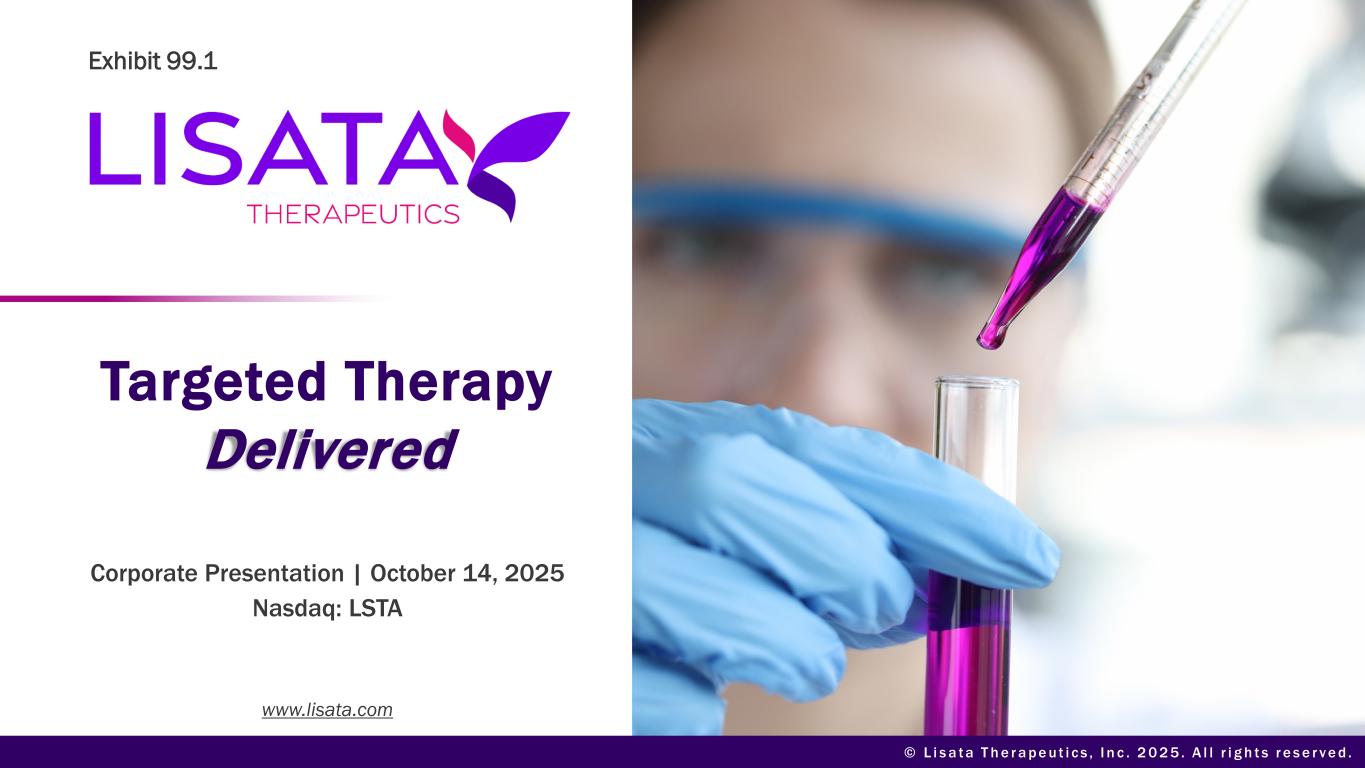
© L i s a t a T h e r a p e u t i c s , I n c . 2 0 2 5 . A l l r i g h t s r e s e r v e d . Targeted Therapy Delivered www.lisata.com Corporate Presentation | October 14, 2025 Nasdaq: LSTA
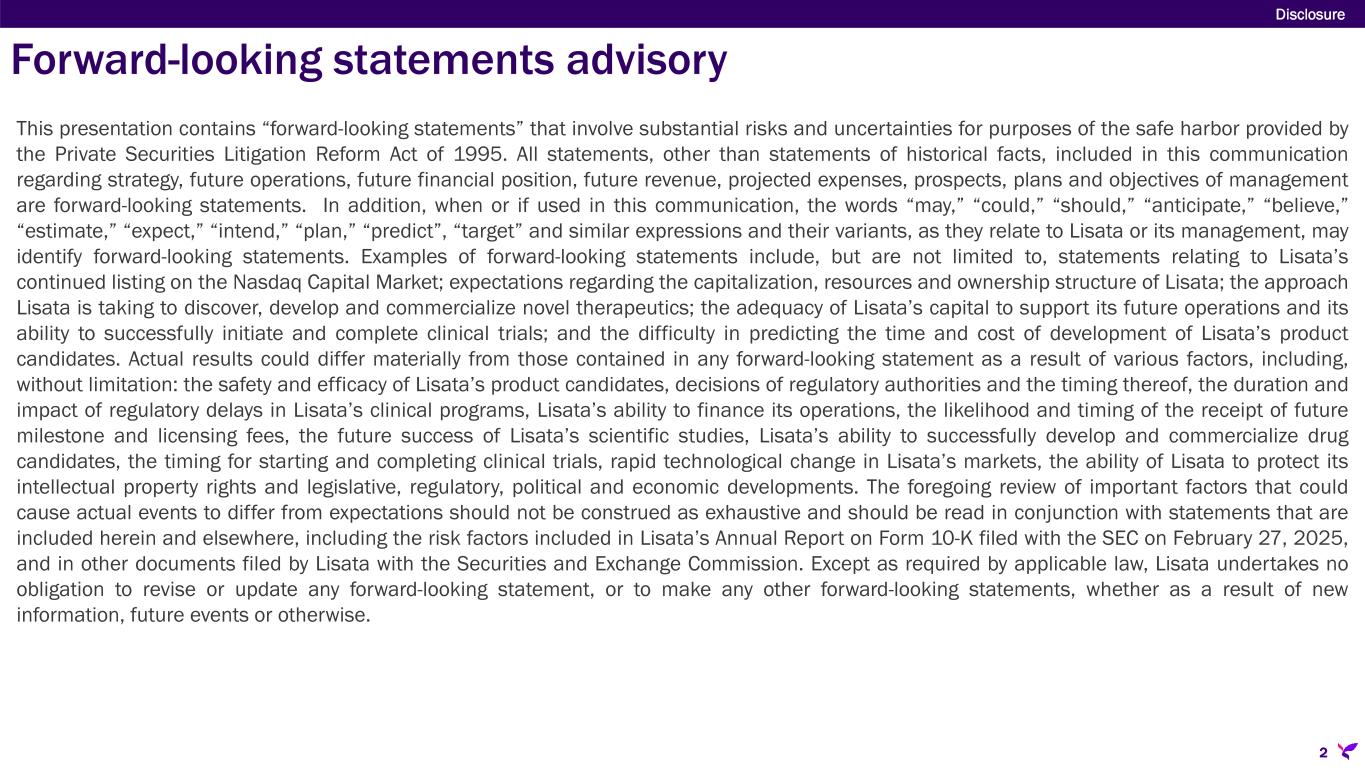
2 Forward-looking statements advisory This presentation contains “forward-looking statements” that involve substantial risks and uncertainties for purposes of the safe harbor provided by the Private Securities Litigation Reform Act of 1995. All statements, other than statements of historical facts, included in this communication regarding strategy, future operations, future financial position, future revenue, projected expenses, prospects, plans and objectives of management are forward-looking statements. In addition, when or if used in this communication, the words “may,” “could,” “should,” “anticipate,” “believe,” “estimate,” “expect,” “intend,” “plan,” “predict”, “target” and similar expressions and their variants, as they relate to Lisata or its management, may identify forward-looking statements. Examples of forward-looking statements include, but are not limited to, statements relating to Lisata’s continued listing on the Nasdaq Capital Market; expectations regarding the capitalization, resources and ownership structure of Lisata; the approach Lisata is taking to discover, develop and commercialize novel therapeutics; the adequacy of Lisata’s capital to support its future operations and its ability to successfully initiate and complete clinical trials; and the difficulty in predicting the time and cost of development of Lisata’s product candidates. Actual results could differ materially from those contained in any forward-looking statement as a result of various factors, including, without limitation: the safety and efficacy of Lisata’s product candidates, decisions of regulatory authorities and the timing thereof, the duration and impact of regulatory delays in Lisata’s clinical programs, Lisata’s ability to finance its operations, the likelihood and timing of the receipt of future milestone and licensing fees, the future success of Lisata’s scientific studies, Lisata’s ability to successfully develop and commercialize drug candidates, the timing for starting and completing clinical trials, rapid technological change in Lisata’s markets, the ability of Lisata to protect its intellectual property rights and legislative, regulatory, political and economic developments. The foregoing review of important factors that could cause actual events to differ from expectations should not be construed as exhaustive and should be read in conjunction with statements that are included herein and elsewhere, including the risk factors included in Lisata’s Annual Report on Form 10-K filed with the SEC on February 27, 2025, and in other documents filed by Lisata with the Securities and Exchange Commission. Except as required by applicable law, Lisata undertakes no obligation to revise or update any forward-looking statement, or to make any other forward-looking statements, whether as a result of new information, future events or otherwise. Disclosure
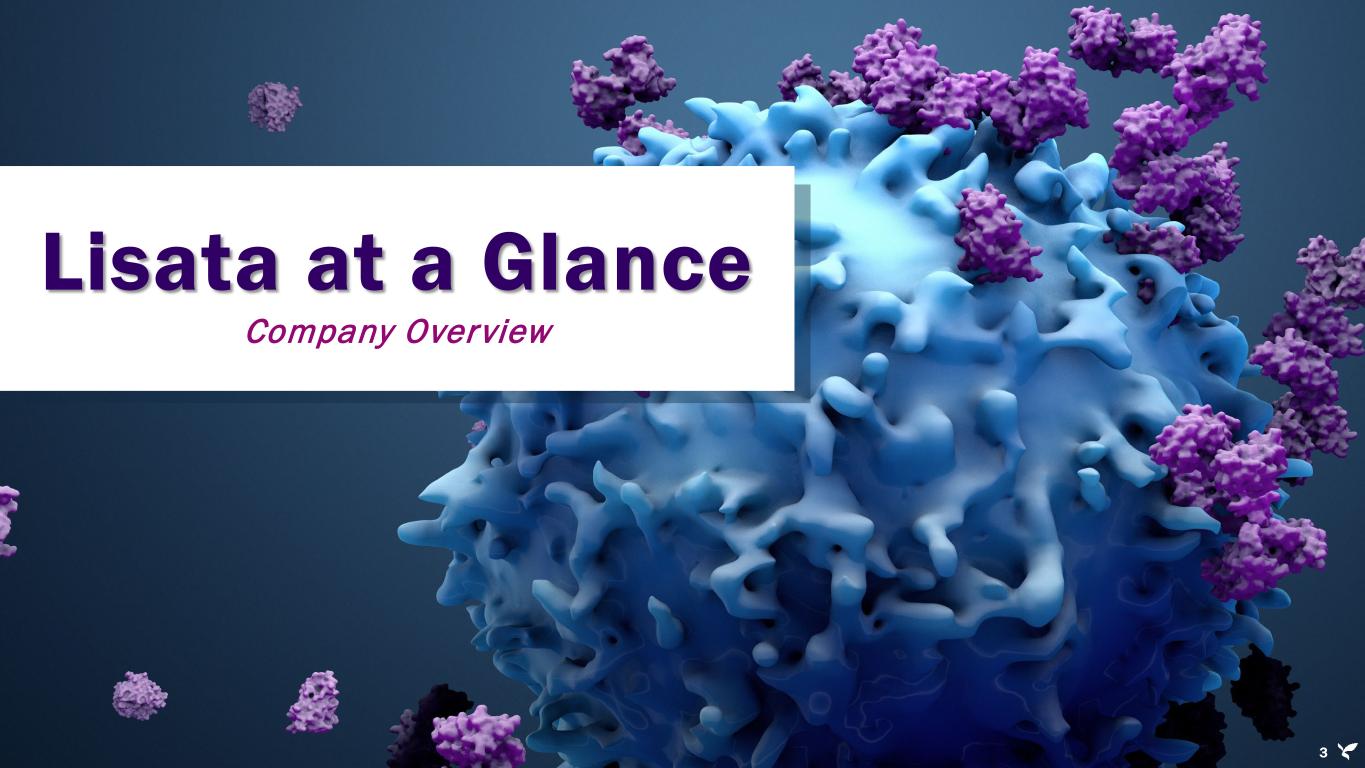
Lisata at a Glance Company Overview 3
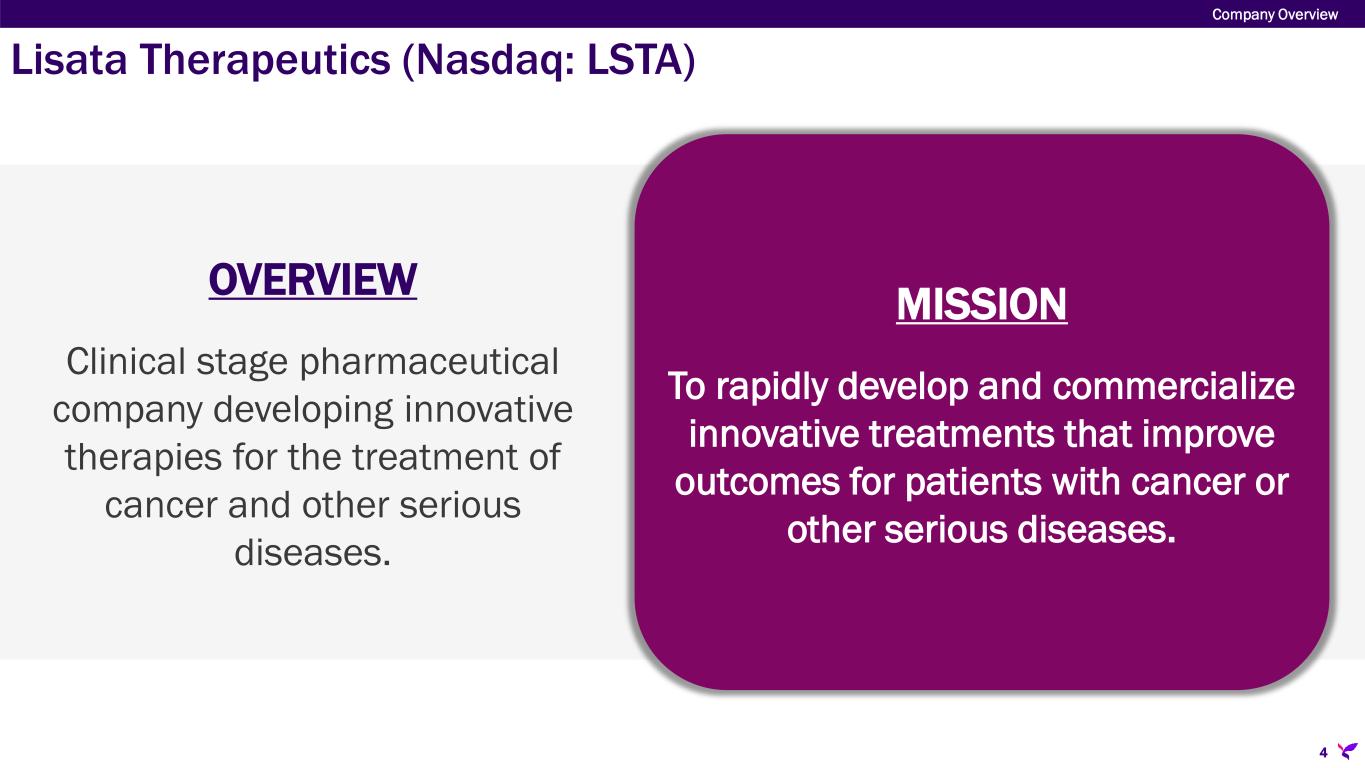
Lisata Therapeutics (Nasdaq: LSTA) Company Overview 4 OVERVIEW Clinical stage pharmaceutical company developing innovative therapies for the treatment of cancer and other serious diseases. MISSION To rapidly develop and commercialize innovative treatments that improve outcomes for patients with cancer or other serious diseases.

Company Overview 5 Lisata Therapeutics (Nasdaq: LSTA): Key attributes Cash runway extending into 1Q 2027 with no debt Seasoned management with successful international drug development experience and expertise Platform technology validated by existing partnerships with potential for many others Multiple product and business milestones projected over the next 12 months Proprietary field- leading technology with global IP protection extending beyond 2040

Seasoned leadership with proven history of drug approvals worldwide 6 Kristen K. Buck, MD Executive Vice President of R&D and Chief Medical Officer Dr. Buck is a board certified and licensed physician with >20 years of strategic global drug development, drug/device safety/epidemiology, FDA, and clinical practice experience. Gregory Berkin Chief Information Officer and Data Protection Officer James Nisco SVP of Finance and Treasury and Chief Accounting Officer Tariq Imam SVP of BD and Operations and General Counsel John Menditto VP of Investor Relations and Corporate Communications Bill Sietsema, PhD VP of Global Regulatory Affairs Ryan Quick VP of Chemistry, Manufacturing and Controls Detailed management bios can be found at www.lisata.com David J. Mazzo, PhD President and Chief Executive Officer, Member of the Board of Directors With >40 years of experience, Dr. Mazzo is a global pharmaceutical executive noted for his strategic prowess and his vast experience developing and launching new products across all therapeutical areas. He recently was recognized as a 2024 PharmaVoice Top 100 Standout Leader. Company Overview

Therapeutic Focus and Rationale 7
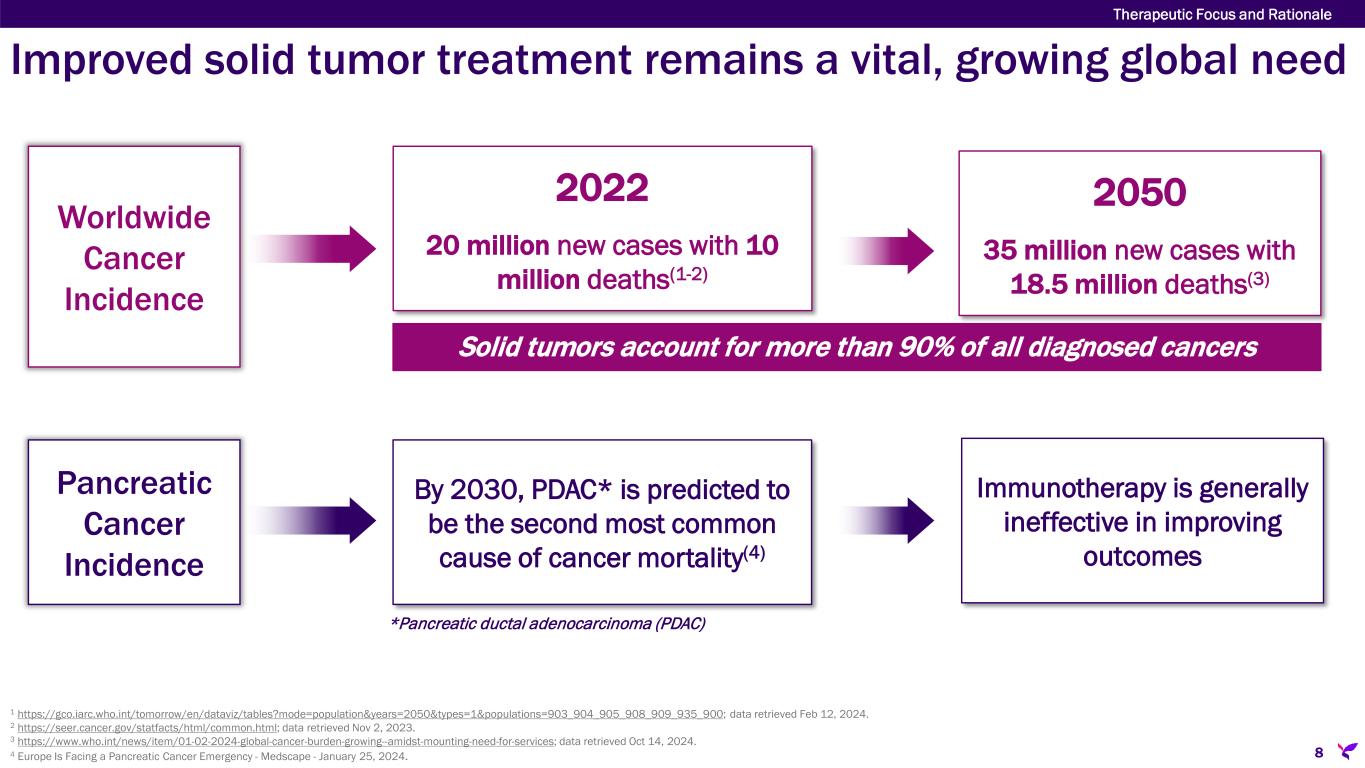
Improved solid tumor treatment remains a vital, growing global need Worldwide Cancer Incidence 2022 20 million new cases with 10 million deaths(1-2) 2050 35 million new cases with 18.5 million deaths(3) Solid tumors account for more than 90% of all diagnosed cancers Pancreatic Cancer Incidence By 2030, PDAC* is predicted to be the second most common cause of cancer mortality(4) Immunotherapy is generally ineffective in improving outcomes *Pancreatic ductal adenocarcinoma (PDAC) 1 https://gco.iarc.who.int/tomorrow/en/dataviz/tables?mode=population&years=2050&types=1&populations=903_904_905_908_909_935_900; data retrieved Feb 12, 2024. 2 https://seer.cancer.gov/statfacts/html/common.html; data retrieved Nov 2, 2023. 3 https://www.who.int/news/item/01-02-2024-global-cancer-burden-growing--amidst-mounting-need-for-services; data retrieved Oct 14, 2024. 4 Europe Is Facing a Pancreatic Cancer Emergency - Medscape - January 25, 2024. 8 Therapeutic Focus and Rationale
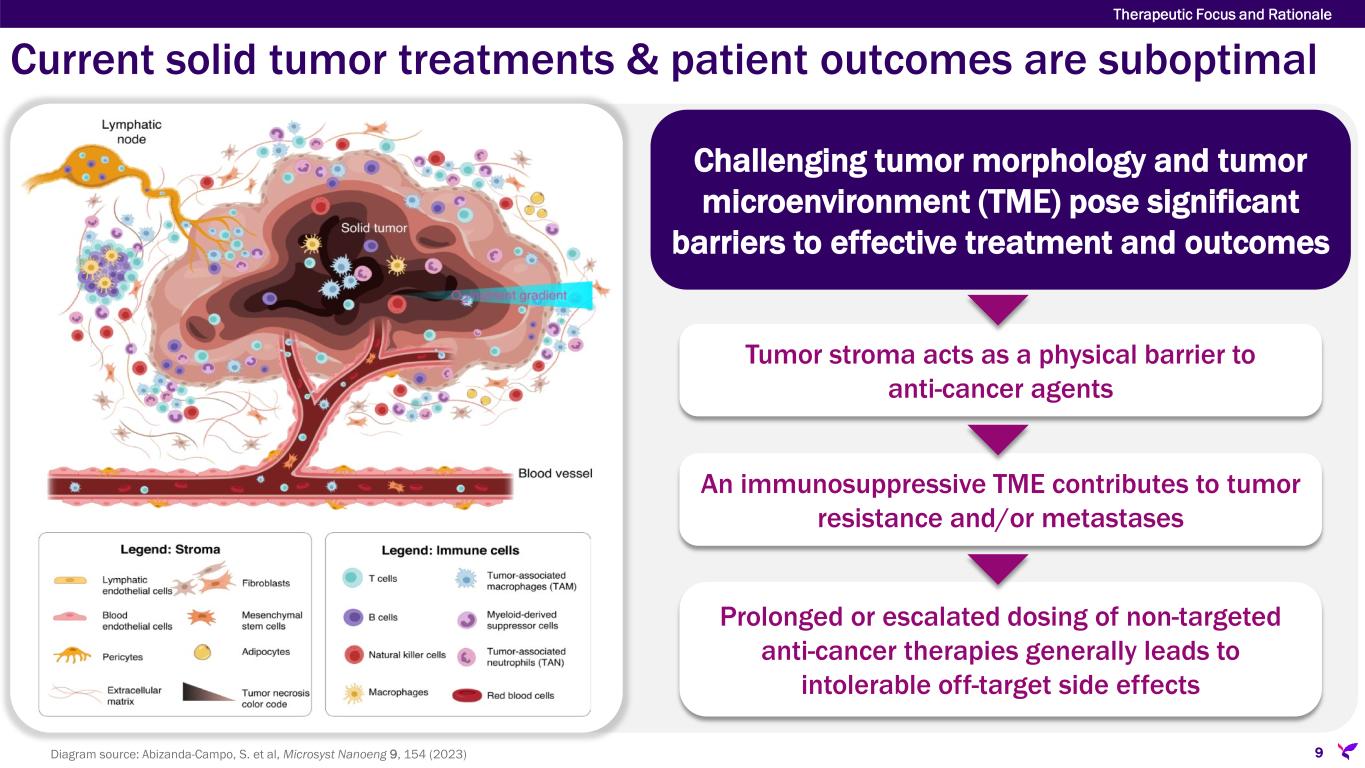
Current solid tumor treatments & patient outcomes are suboptimal 9 Therapeutic Focus and Rationale Diagram source: Abizanda-Campo, S. et al, Microsyst Nanoeng 9, 154 (2023) Challenging tumor morphology and tumor microenvironment (TME) pose significant barriers to effective treatment and outcomes Tumor stroma acts as a physical barrier to anti-cancer agents An immunosuppressive TME contributes to tumor resistance and/or metastases Prolonged or escalated dosing of non-targeted anti-cancer therapies generally leads to intolerable off-target side effects

Certepetide is designed to optimize solid tumor treatment 1 Sugahara, et al. Mol Cancer Ther; 14(1) January 2015; Hamilton, et al., J MolMed. April 2015; and Miyamura, et al., bioRxiv. May 2023. 2 Yuan, D., Duda, D., et al. CCA Foundation Conf. 2024 Poster. Enhancing the efficacy of standard therapy in intrahepatic cholangiocarcinoma using LSTA1, a novel tumor targeting and penetration agent. Converts tumor stroma from a barrier to a conduit for anti-cancer drugs Selectively reduces TME immunosuppressive T cells and recruits cytotoxic T cells(1) Inhibits the metastatic cascade(2) Applicable with any modality of anti-cancer therapeutic Via co-administration or molecular tethering Poised for Phase 3 in mPDAC** In mid-stage clinical development in multiple solid tumors Certepetide: a proprietary internalizing RGD* (iRGD) cyclic peptide adjuvant with tumor specific targeting & penetration activity and tumor microenvironment modifying properties *internalizing RGD: arginyl-glycyl-aspartic acid or iRGD **mPDAC: metastatic pancreatic ductal adenocarcinoma 10 Therapeutic Focus and Rationale
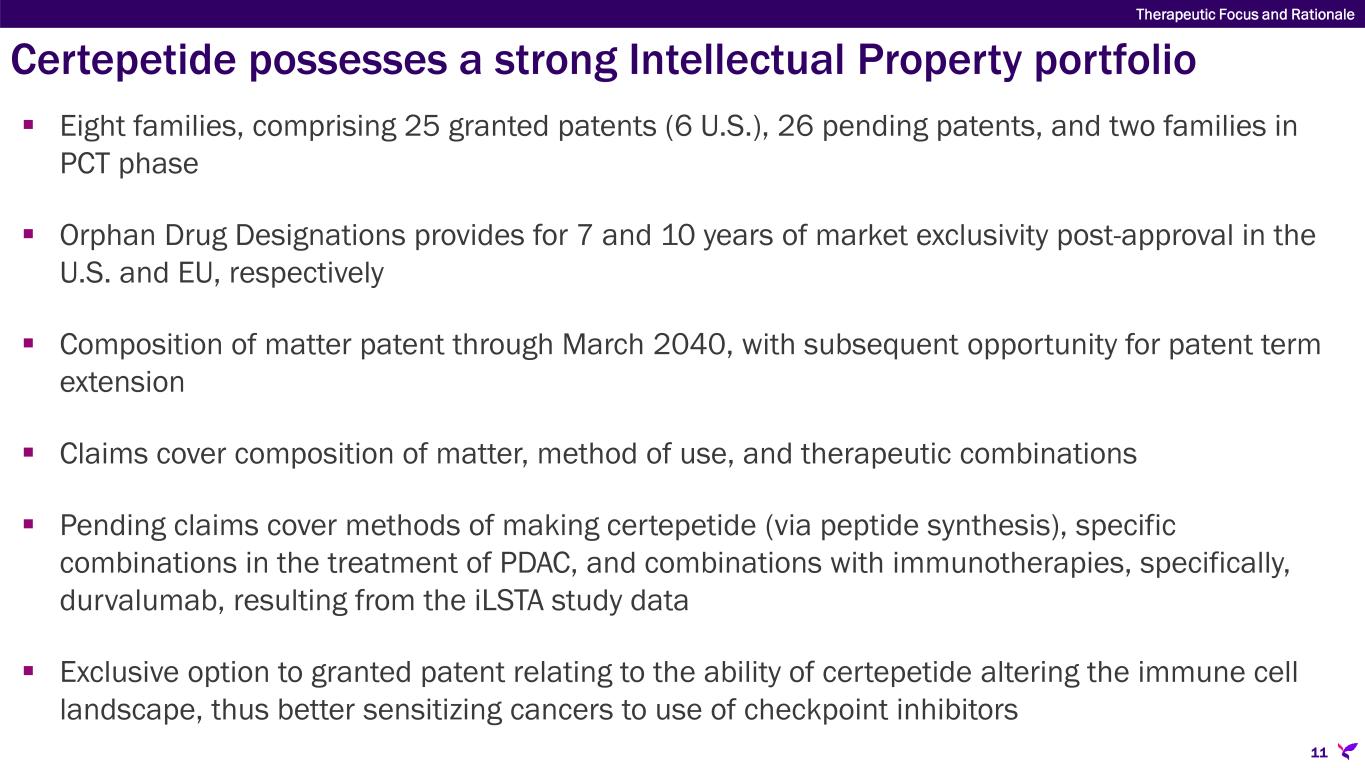
Certepetide possesses a strong Intellectual Property portfolio Eight families, comprising 25 granted patents (6 U.S.), 26 pending patents, and two families in PCT phase Orphan Drug Designations provides for 7 and 10 years of market exclusivity post-approval in the U.S. and EU, respectively Composition of matter patent through March 2040, with subsequent opportunity for patent term extension Claims cover composition of matter, method of use, and therapeutic combinations Pending claims cover methods of making certepetide (via peptide synthesis), specific combinations in the treatment of PDAC, and combinations with immunotherapies, specifically, durvalumab, resulting from the iLSTA study data Exclusive option to granted patent relating to the ability of certepetide altering the immune cell landscape, thus better sensitizing cancers to use of checkpoint inhibitors 11 Therapeutic Focus and Rationale
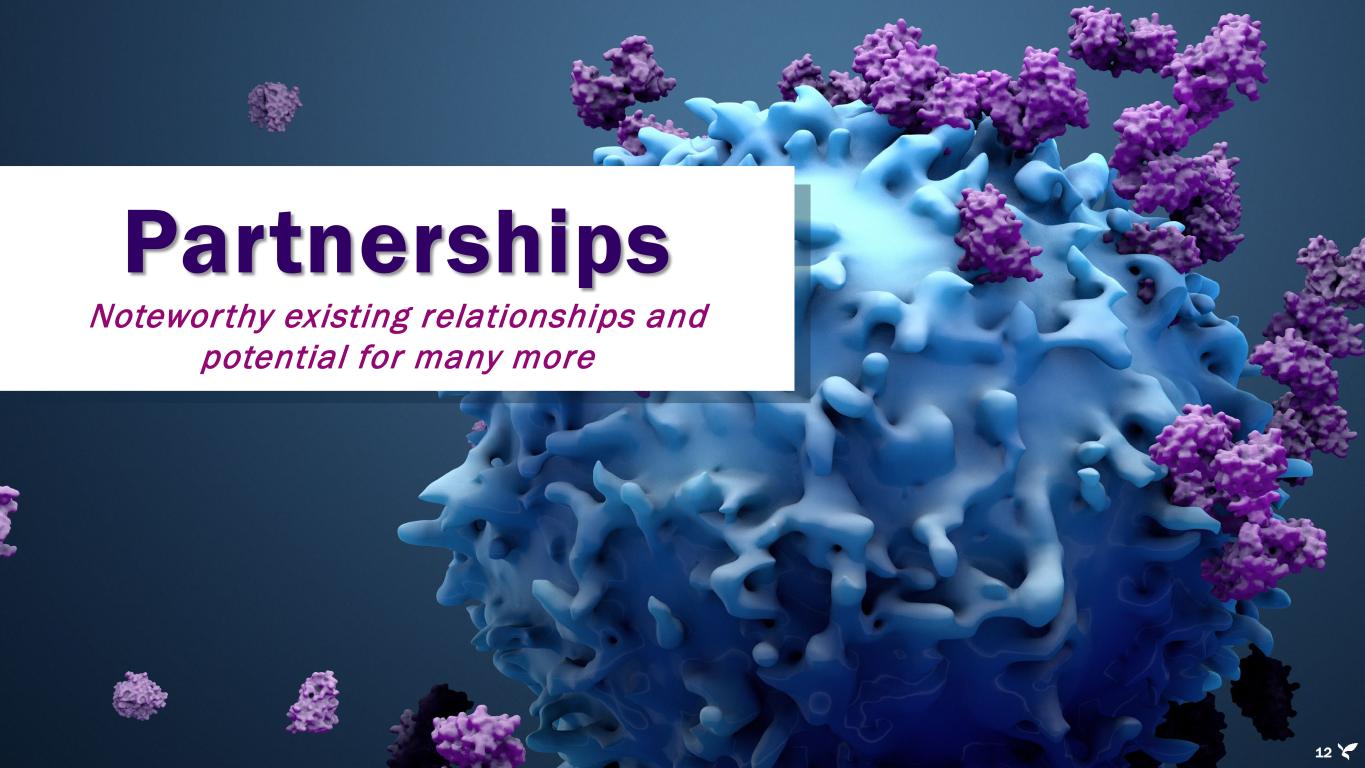
Partnerships Noteworthy existing relationships and potential for many more 12
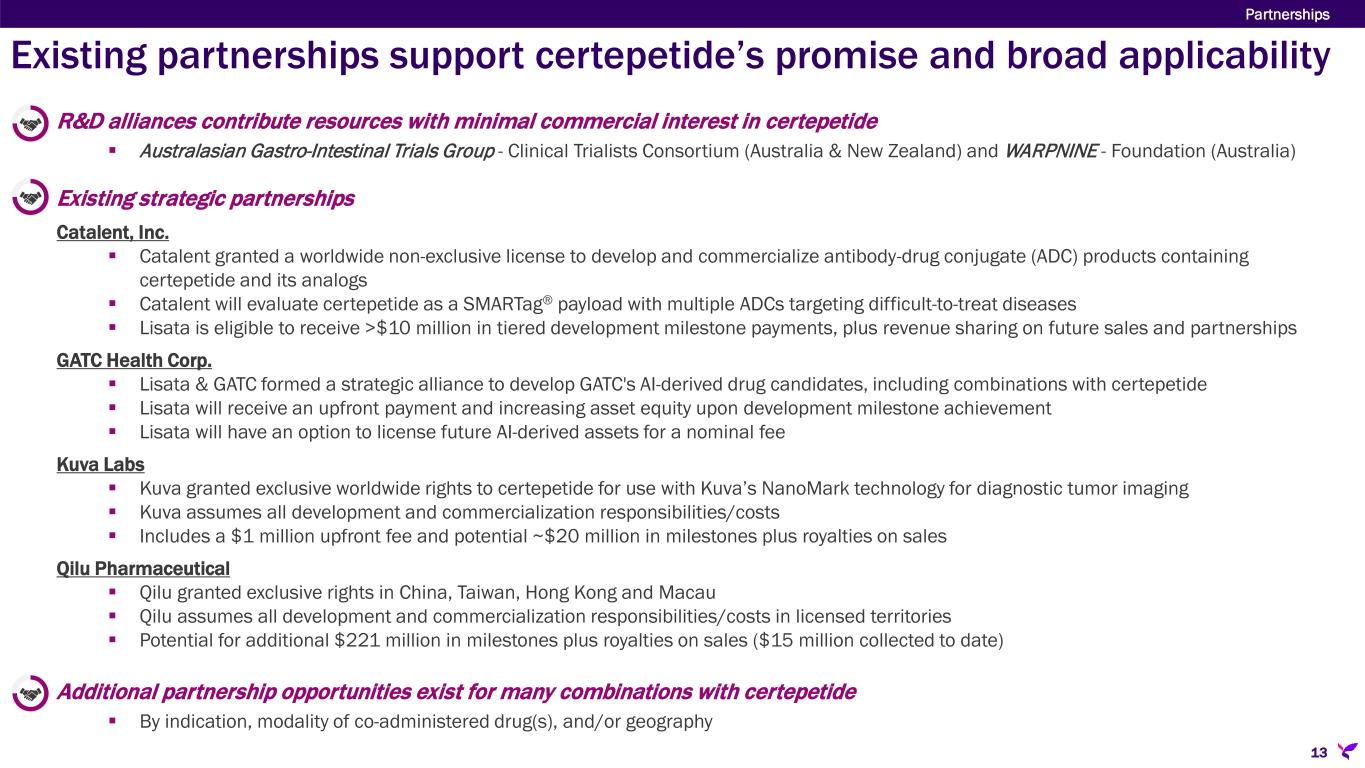
Existing partnerships support certepetide’s promise and broad applicability Partnerships 13 R&D alliances contribute resources with minimal commercial interest in certepetide Australasian Gastro-Intestinal Trials Group - Clinical Trialists Consortium (Australia & New Zealand) and WARPNINE - Foundation (Australia) Existing strategic partnerships Catalent, Inc. Catalent granted a worldwide non-exclusive license to develop and commercialize antibody-drug conjugate (ADC) products containing certepetide and its analogs Catalent will evaluate certepetide as a SMARTag® payload with multiple ADCs targeting difficult-to-treat diseases Lisata is eligible to receive >$10 million in tiered development milestone payments, plus revenue sharing on future sales and partnerships GATC Health Corp. Lisata & GATC formed a strategic alliance to develop GATC's AI-derived drug candidates, including combinations with certepetide Lisata will receive an upfront payment and increasing asset equity upon development milestone achievement Lisata will have an option to license future AI-derived assets for a nominal fee Kuva Labs Kuva granted exclusive worldwide rights to certepetide for use with Kuva’s NanoMark technology for diagnostic tumor imaging Kuva assumes all development and commercialization responsibilities/costs Includes a $1 million upfront fee and potential ~$20 million in milestones plus royalties on sales Qilu Pharmaceutical Qilu granted exclusive rights in China, Taiwan, Hong Kong and Macau Qilu assumes all development and commercialization responsibilities/costs in licensed territories Potential for additional $221 million in milestones plus royalties on sales ($15 million collected to date) Additional partnership opportunities exist for many combinations with certepetide By indication, modality of co-administered drug(s), and/or geography

14 Certepetide Strong Scientific Foundation and Rationale
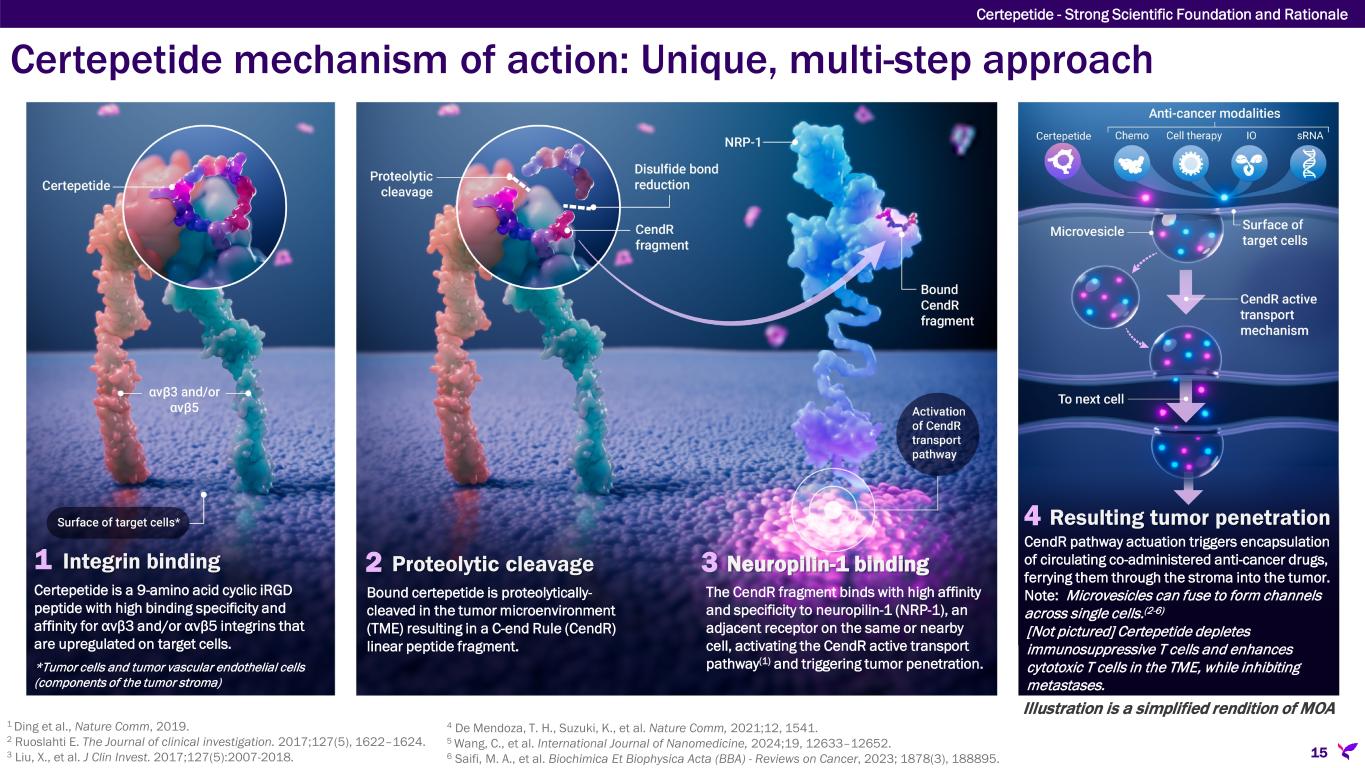
Certepetide mechanism of action: Unique, multi-step approach Certepetide - Strong Scientific Foundation and Rationale 15 1 Integrin binding 2 Proteolytic cleavage 3 Neuropilin-1 binding 4 Resulting tumor penetration Bound certepetide is proteolytically- cleaved in the tumor microenvironment (TME) resulting in a C-end Rule (CendR) linear peptide fragment. The CendR fragment binds with high affinity and specificity to neuropilin-1 (NRP-1), an adjacent receptor on the same or nearby cell, activating the CendR active transport pathway(1) and triggering tumor penetration. Certepetide is a 9-amino acid cyclic iRGD peptide with high binding specificity and affinity for αvβ3 and/or αvβ5 integrins that are upregulated on target cells. *Tumor cells and tumor vascular endothelial cells (components of the tumor stroma) CendR pathway actuation triggers encapsulation of circulating co-administered anti-cancer drugs, ferrying them through the stroma into the tumor. Note: Microvesicles can fuse to form channels across single cells.(2-6) [Not pictured] Certepetide depletes immunosuppressive T cells and enhances cytotoxic T cells in the TME, while inhibiting metastases. Illustration is a simplified rendition of MOA 1 Ding et al., Nature Comm, 2019. 2 Ruoslahti E. The Journal of clinical investigation. 2017;127(5), 1622–1624. 3 Liu, X., et al. J Clin Invest. 2017;127(5):2007-2018. 4 De Mendoza, T. H., Suzuki, K., et al. Nature Comm, 2021;12, 1541. 5 Wang, C., et al. International Journal of Nanomedicine, 2024;19, 12633–12652. 6 Saifi, M. A., et al. Biochimica Et Biophysica Acta (BBA) - Reviews on Cancer, 2023; 1878(3), 188895.
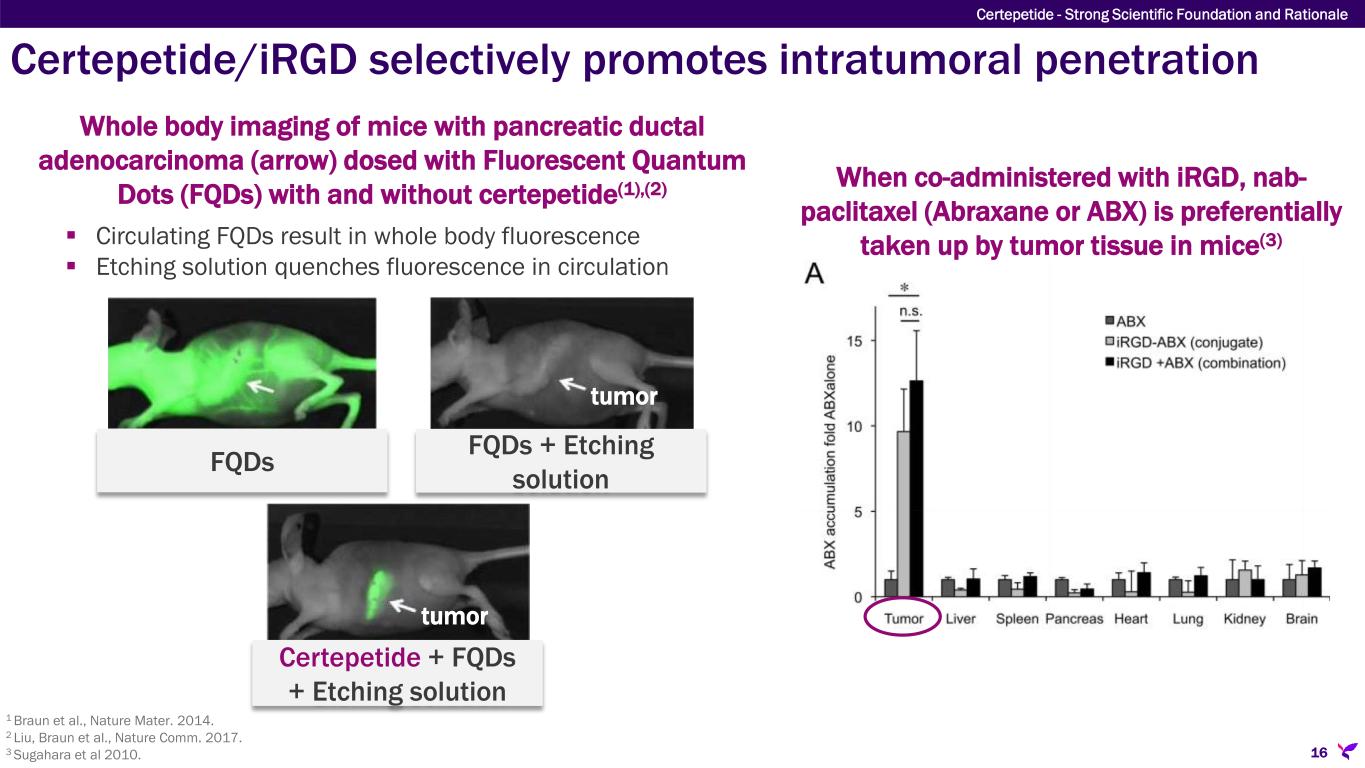
Certepetide/iRGD selectively promotes intratumoral penetration 1 Braun et al., Nature Mater. 2014. 2 Liu, Braun et al., Nature Comm. 2017. 3 Sugahara et al 2010. 16 Certepetide - Strong Scientific Foundation and Rationale Whole body imaging of mice with pancreatic ductal adenocarcinoma (arrow) dosed with Fluorescent Quantum Dots (FQDs) with and without certepetide(1),(2) Circulating FQDs result in whole body fluorescence Etching solution quenches fluorescence in circulation tumor FQDs + Etching solution tumor Certepetide + FQDs + Etching solution When co-administered with iRGD, nab- paclitaxel (Abraxane or ABX) is preferentially taken up by tumor tissue in mice(3) FQDs
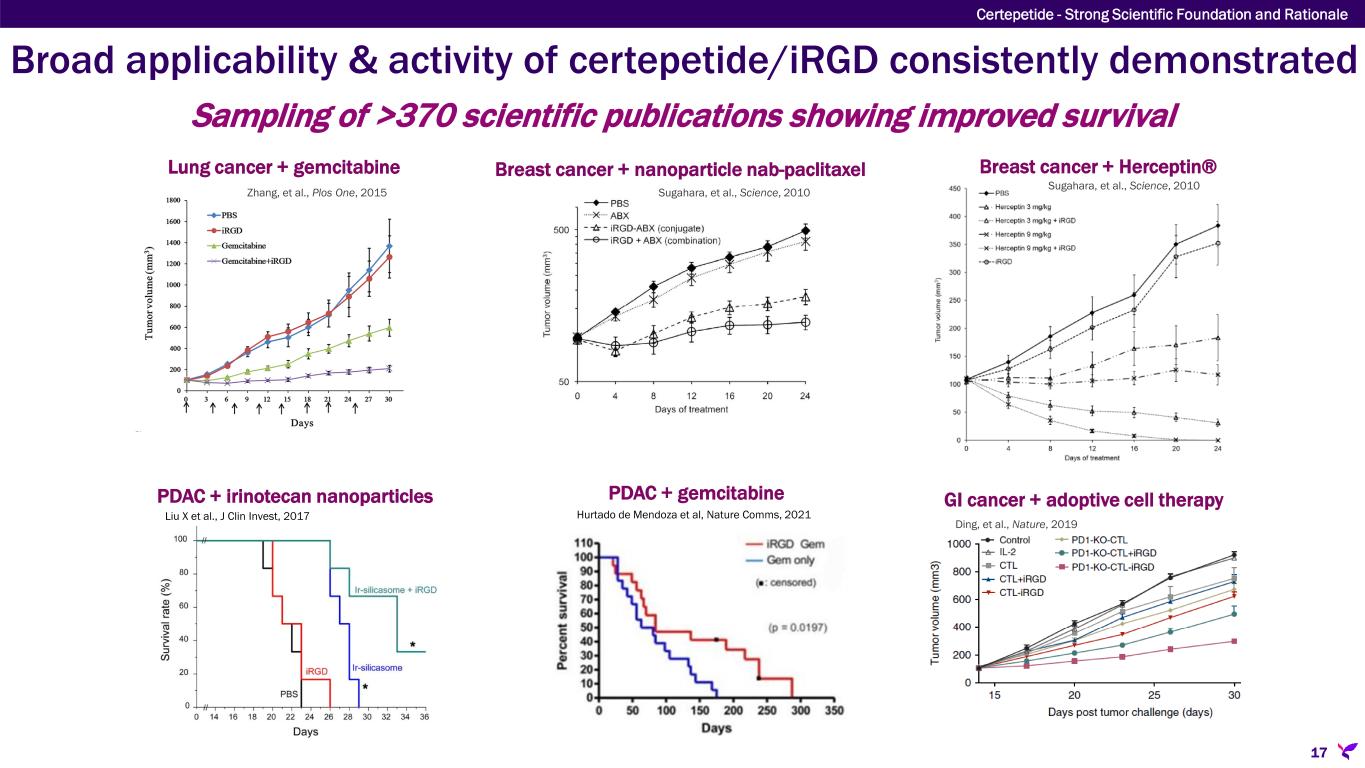
Broad applicability & activity of certepetide/iRGD consistently demonstrated Sampling of >370 scientific publications showing improved survival 17 Certepetide - Strong Scientific Foundation and Rationale Breast cancer + Herceptin®Lung cancer + gemcitabine Zhang, et al., Plos One, 2015 Breast cancer + nanoparticle nab-paclitaxel GI cancer + adoptive cell therapy Ding, et al., Nature, 2019 PDAC + irinotecan nanoparticles Liu X et al., J Clin Invest, 2017 PDAC + gemcitabine Hurtado de Mendoza et al, Nature Comms, 2021 Sugahara, et al., Science, 2010Sugahara, et al., Science, 2010
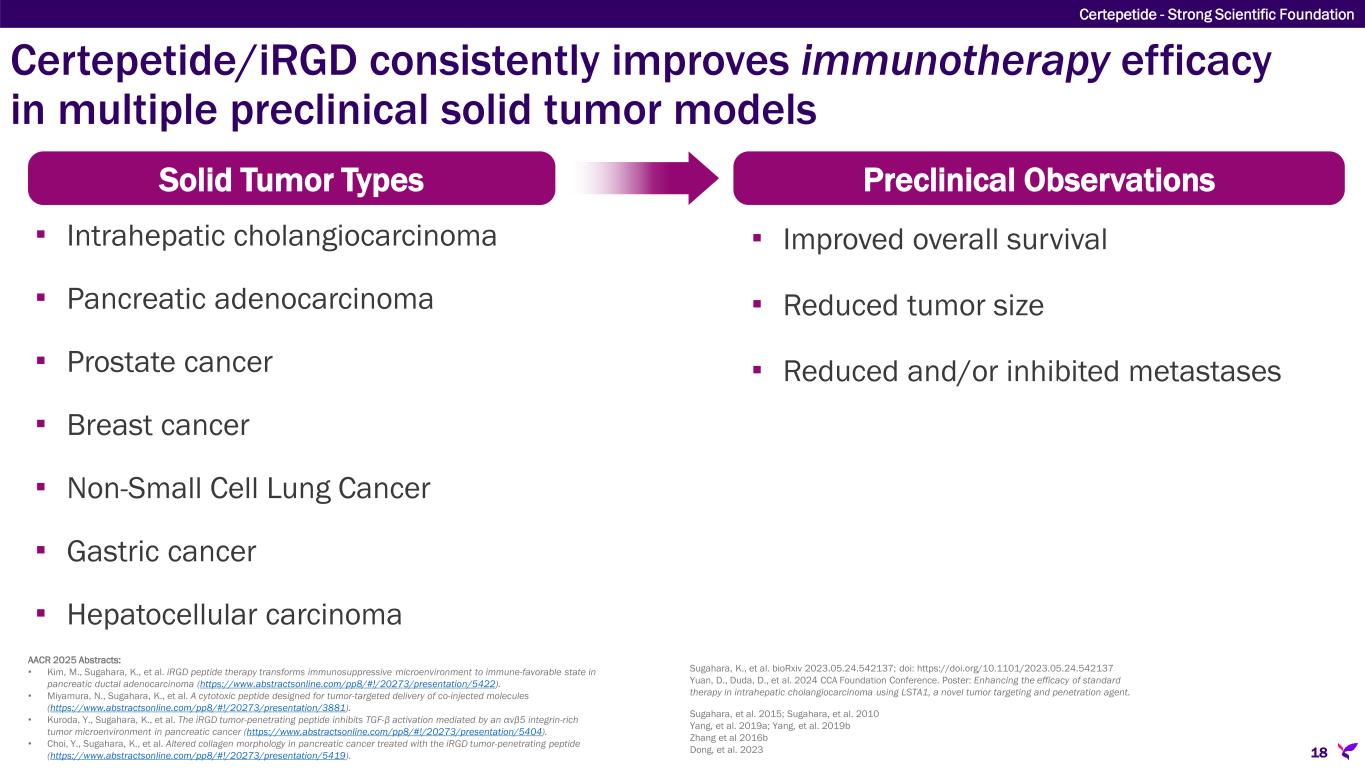
Certepetide/iRGD consistently improves immunotherapy efficacy in multiple preclinical solid tumor models 18 Solid Tumor Types Intrahepatic cholangiocarcinoma Pancreatic adenocarcinoma Prostate cancer Breast cancer Non-Small Cell Lung Cancer Gastric cancer Hepatocellular carcinoma Preclinical Observations Improved overall survival Reduced tumor size Reduced and/or inhibited metastases Certepetide - Strong Scientific Foundation Sugahara, K., et al. bioRxiv 2023.05.24.542137; doi: https://doi.org/10.1101/2023.05.24.542137 Yuan, D., Duda, D., et al. 2024 CCA Foundation Conference. Poster: Enhancing the efficacy of standard therapy in intrahepatic cholangiocarcinoma using LSTA1, a novel tumor targeting and penetration agent. Sugahara, et al. 2015; Sugahara, et al. 2010 Yang, et al. 2019a; Yang, et al. 2019b Zhang et al 2016b Dong, et al. 2023 AACR 2025 Abstracts: • Kim, M., Sugahara, K., et al. iRGD peptide therapy transforms immunosuppressive microenvironment to immune-favorable state in pancreatic ductal adenocarcinoma (https://www.abstractsonline.com/pp8/#!/20273/presentation/5422). • Miyamura, N., Sugahara, K., et al. A cytotoxic peptide designed for tumor-targeted delivery of co-injected molecules (https://www.abstractsonline.com/pp8/#!/20273/presentation/3881). • Kuroda, Y., Sugahara, K., et al. The iRGD tumor-penetrating peptide inhibits TGF-β activation mediated by an αvβ5 integrin-rich tumor microenvironment in pancreatic cancer (https://www.abstractsonline.com/pp8/#!/20273/presentation/5404). • Choi, Y., Sugahara, K., et al. Altered collagen morphology in pancreatic cancer treated with the iRGD tumor-penetrating peptide (https://www.abstractsonline.com/pp8/#!/20273/presentation/5419).

Certepetide improves immunotherapy impact in cholangiocarcinoma 19 Certepetide - Strong Scientific Foundation and Rationale Intrahepatic cholangiocarcinoma (ICC) has an immunosuppressive TME and a dense desmoplastic stroma with abnormal vasculature which together impede anti-cancer agent efficacy Lung metastases often lead to a significant decline in survival Human ICC SoC (gemcitabine/cisplatin/durvalumab) efficacy improved with certepetide in murine model Yuan, D., Duda, D., et al. CCA Foundation Conf. (2024) Poster. Enhancing the efficacy of standard therapy in intrahepatic cholangiocarcinoma using LSTA1, a novel tumor targeting and penetration agent Certepetide combined with chemo- and immunotherapy improves survival, reduces morbidity and inhibits metastasis in cholangiocarcinoma mouse model ICC mouse model *Certepetide was formerly known as LSTA1
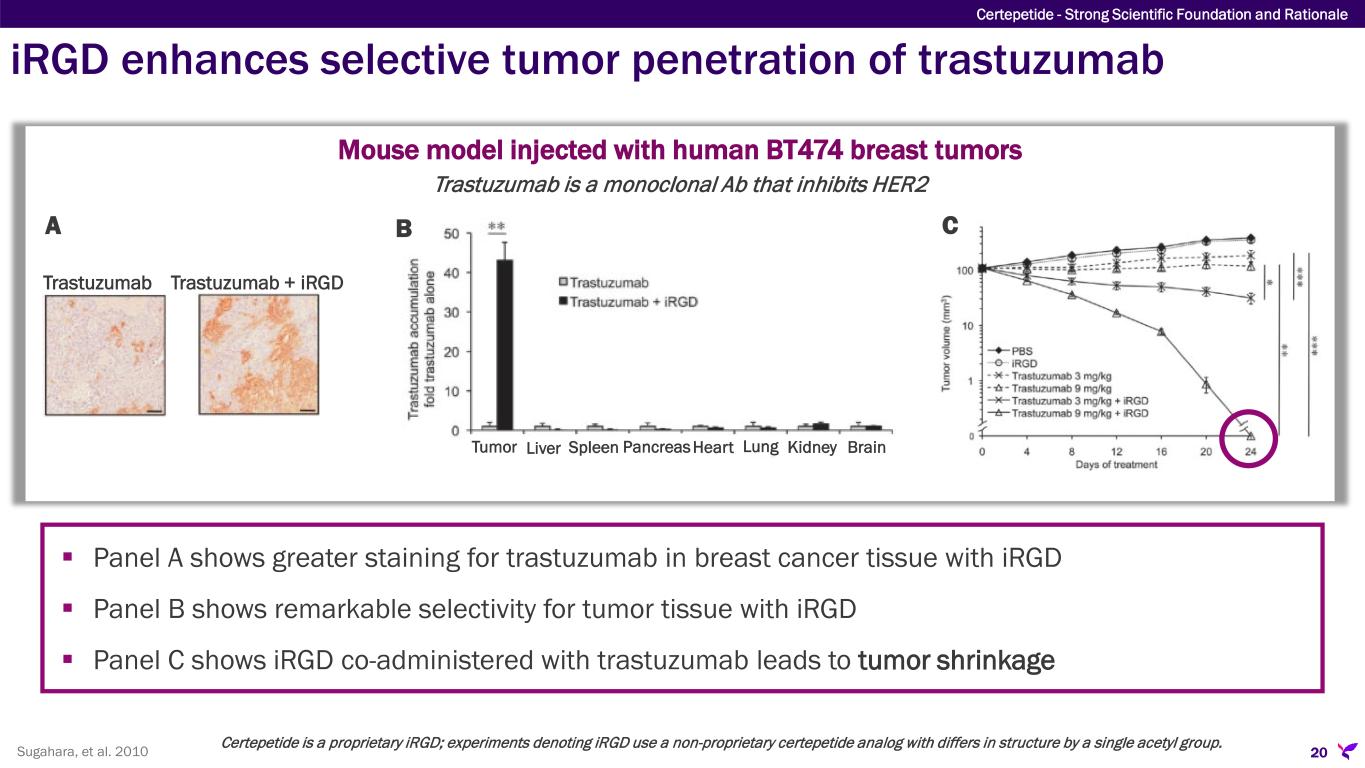
iRGD enhances selective tumor penetration of trastuzumab Mouse model injected with human BT474 breast tumors Panel A shows greater staining for trastuzumab in breast cancer tissue with iRGD Panel B shows remarkable selectivity for tumor tissue with iRGD Panel C shows iRGD co-administered with trastuzumab leads to tumor shrinkage Sugahara, et al. 2010 Certepetide - Strong Scientific Foundation and Rationale 20 Trastuzumab + iRGDTrastuzumab A CB Tumor Liver Spleen HeartPancreas Lung Kidney Brain Certepetide is a proprietary iRGD; experiments denoting iRGD use a non-proprietary certepetide analog with differs in structure by a single acetyl group. Trastuzumab is a monoclonal Ab that inhibits HER2

Certepetide development strategy: A two-pillar approach 21 Certepetide - Strong Scientific Foundation and Rationale Pursue rapid global registration in mPDAC, initially combined with gemcitabine/nab-paclitaxel standard-of- care (SoC) Positive ASCEND Phase 2b preliminary results End-of-Phase 2 FDA meeting completed Phase 3 study protocol and development plan agreed Phase 3 preparations underway Demonstrate certepetide effectiveness when combined with a variety of other SoC regimens (e.g., chemotherapy, immunotherapy, etc.) in a variety of solid tumors Multiple Phase 2a studies underway
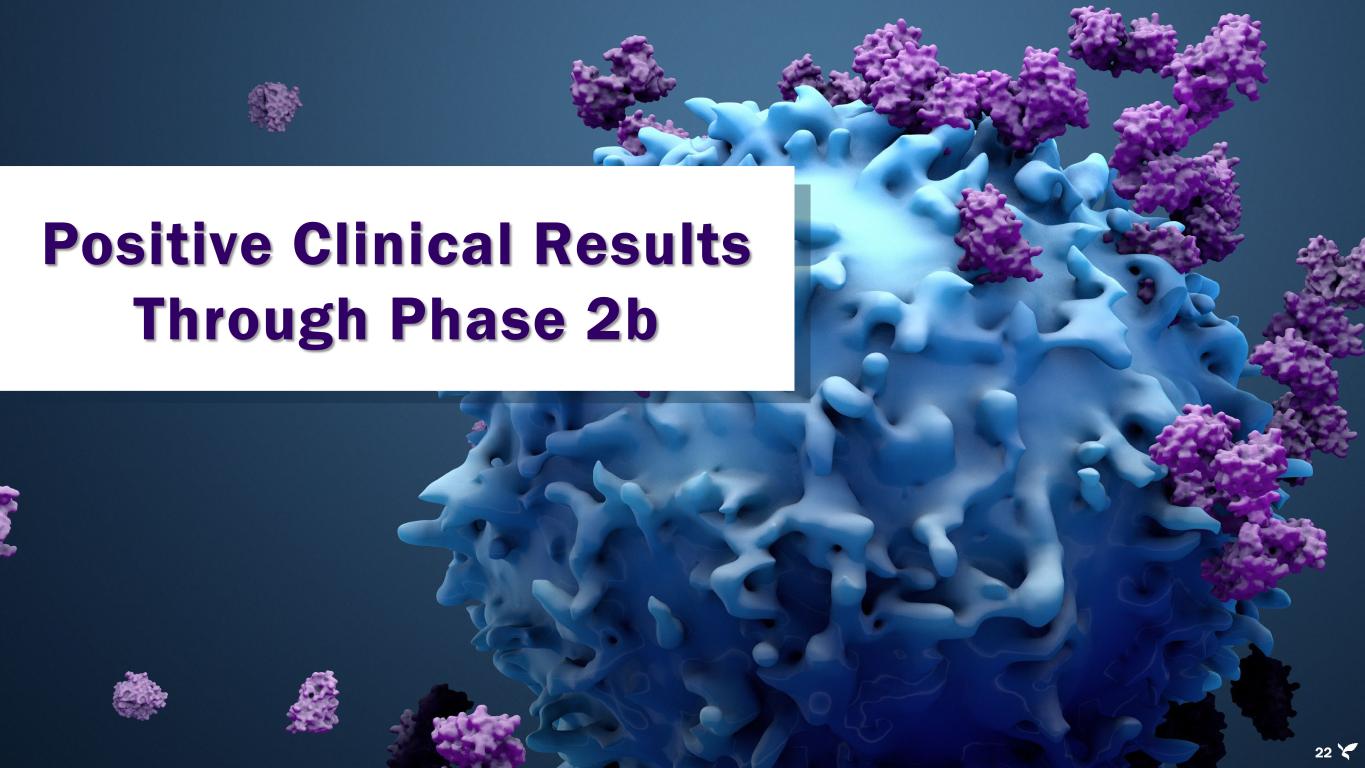
Positive Clinical Results Through Phase 2b 22
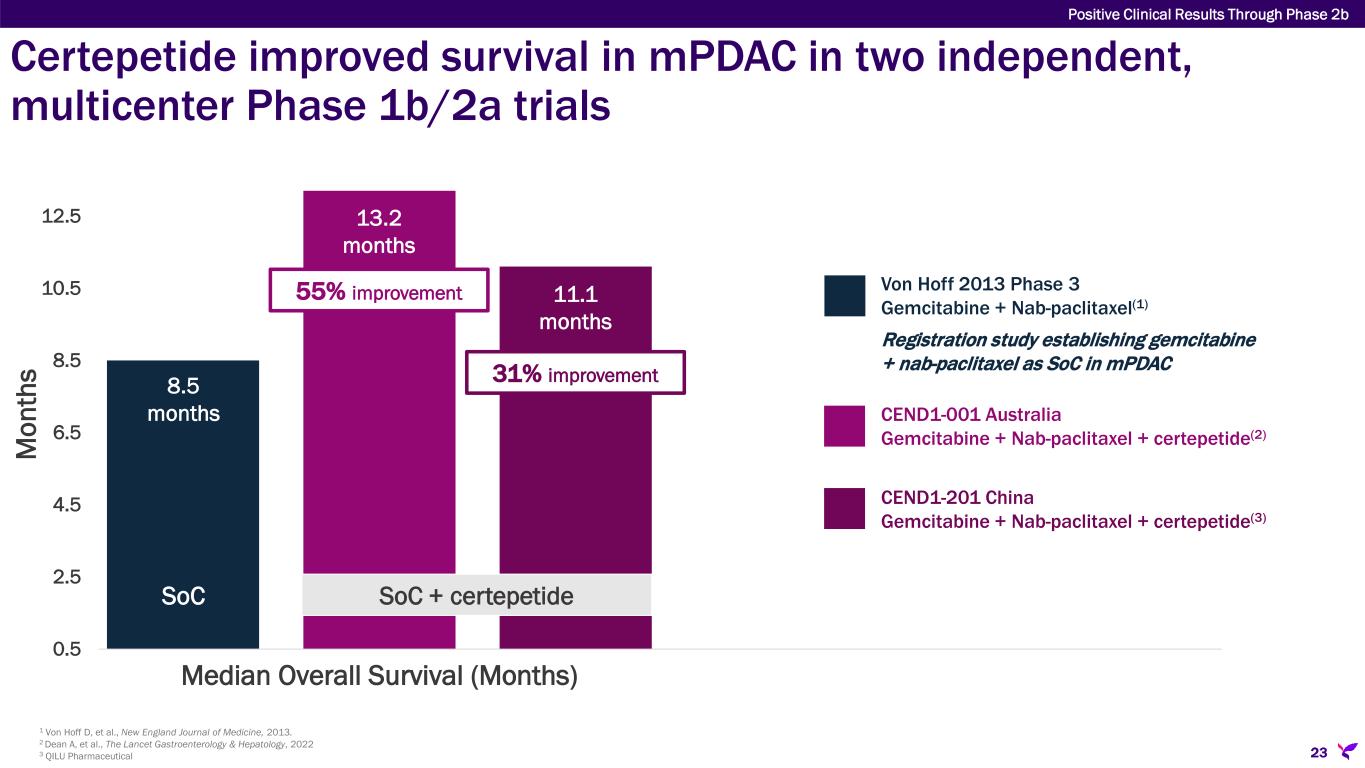
23 Positive Clinical Results Through Phase 2b Certepetide improved survival in mPDAC in two independent, multicenter Phase 1b/2a trials 1 Von Hoff D, et al., New England Journal of Medicine, 2013. 2 Dean A, et al., The Lancet Gastroenterology & Hepatology, 2022 3 QILU Pharmaceutical 0.5 2.5 4.5 6.5 8.5 10.5 12.5 Median Overall Survival (Months) M on th s 13.2 months 8.5 months 11.1 months 55% improvement SoC + certepetide 31% improvement SoC CEND1-201 China Gemcitabine + Nab-paclitaxel + certepetide(3) Von Hoff 2013 Phase 3 Gemcitabine + Nab-paclitaxel(1) Registration study establishing gemcitabine + nab-paclitaxel as SoC in mPDAC CEND1-001 Australia Gemcitabine + Nab-paclitaxel + certepetide(2)
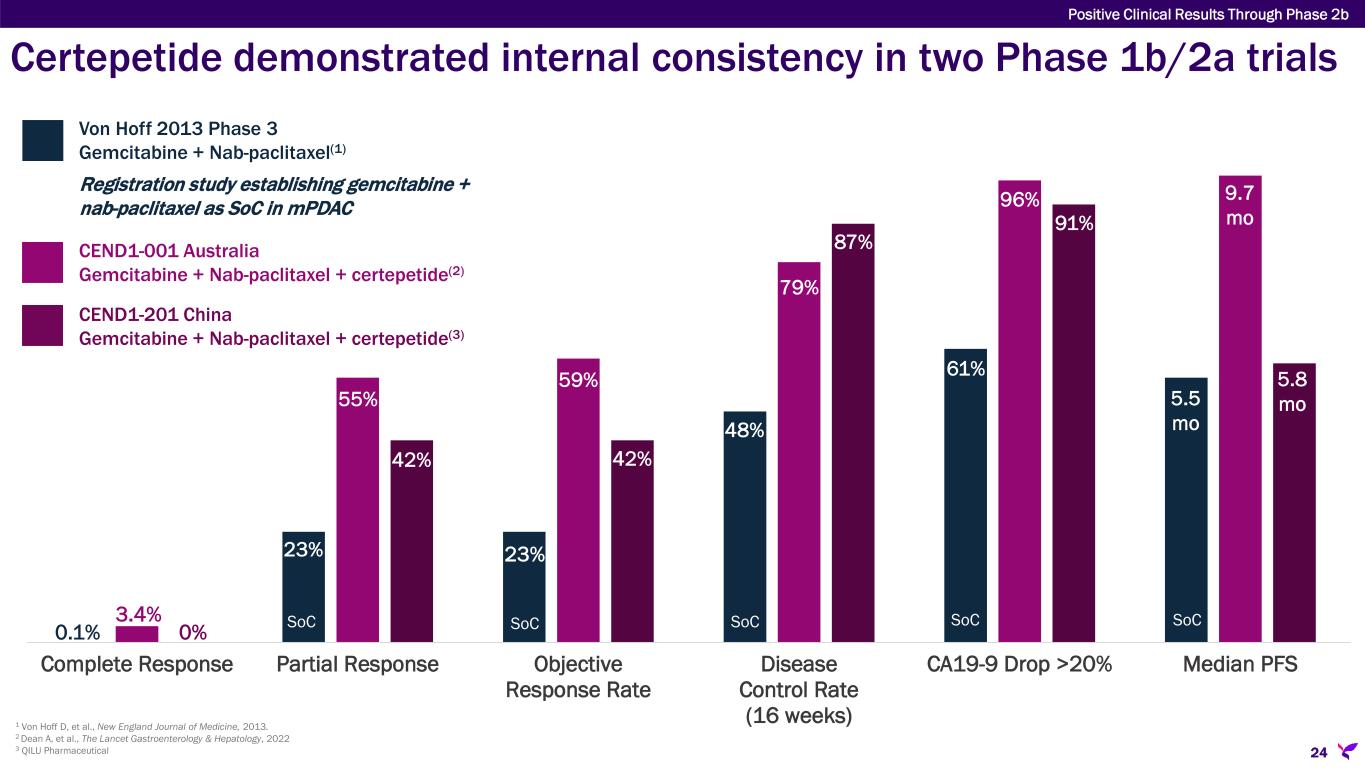
Certepetide demonstrated internal consistency in two Phase 1b/2a trials 1 Von Hoff D, et al., New England Journal of Medicine, 2013. 2 Dean A, et al., The Lancet Gastroenterology & Hepatology, 2022 3 QILU Pharmaceutical 24 Complete Response Partial Response Objective Response Rate Disease Control Rate (16 weeks) CA19-9 Drop >20% Median PFS 23% 59% 23% 3.4% 0.1% 55% 79% 96% 0% 42% 48% 61% 87% 91% SoC SoC SoC SoCSoC 5.5 mo 9.7 mo 5.8 mo 42% CEND1-201 China Gemcitabine + Nab-paclitaxel + certepetide(3) Von Hoff 2013 Phase 3 Gemcitabine + Nab-paclitaxel(1) Registration study establishing gemcitabine + nab-paclitaxel as SoC in mPDAC CEND1-001 Australia Gemcitabine + Nab-paclitaxel + certepetide(2) Positive Clinical Results Through Phase 2b
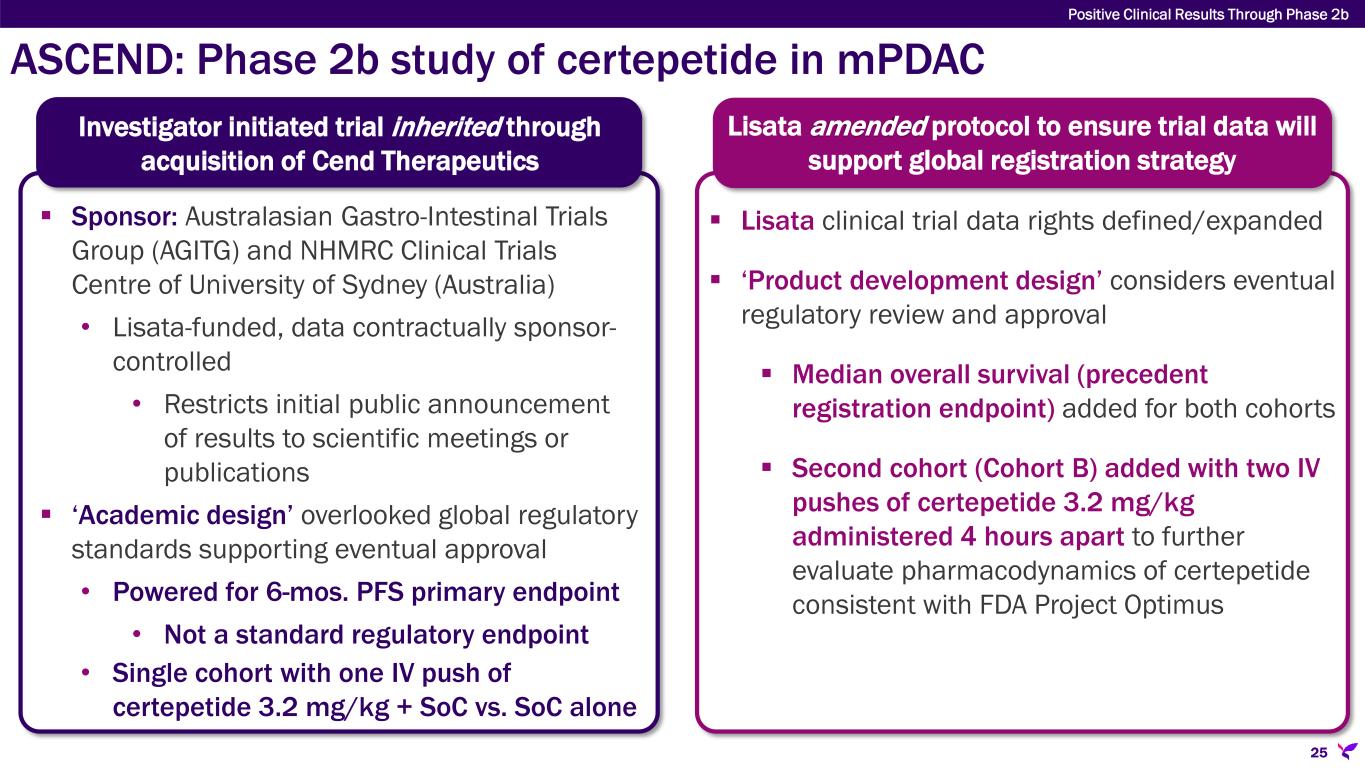
ASCEND: Phase 2b study of certepetide in mPDAC Sponsor: Australasian Gastro-Intestinal Trials Group (AGITG) and NHMRC Clinical Trials Centre of University of Sydney (Australia) • Lisata-funded, data contractually sponsor- controlled • Restricts initial public announcement of results to scientific meetings or publications ‘Academic design’ overlooked global regulatory standards supporting eventual approval • Powered for 6-mos. PFS primary endpoint • Not a standard regulatory endpoint • Single cohort with one IV push of certepetide 3.2 mg/kg + SoC vs. SoC alone Investigator initiated trial inherited through acquisition of Cend Therapeutics Lisata amended protocol to ensure trial data will support global registration strategy Lisata clinical trial data rights defined/expanded ‘Product development design’ considers eventual regulatory review and approval Median overall survival (precedent registration endpoint) added for both cohorts Second cohort (Cohort B) added with two IV pushes of certepetide 3.2 mg/kg administered 4 hours apart to further evaluate pharmacodynamics of certepetide consistent with FDA Project Optimus 25 Positive Clinical Results Through Phase 2b
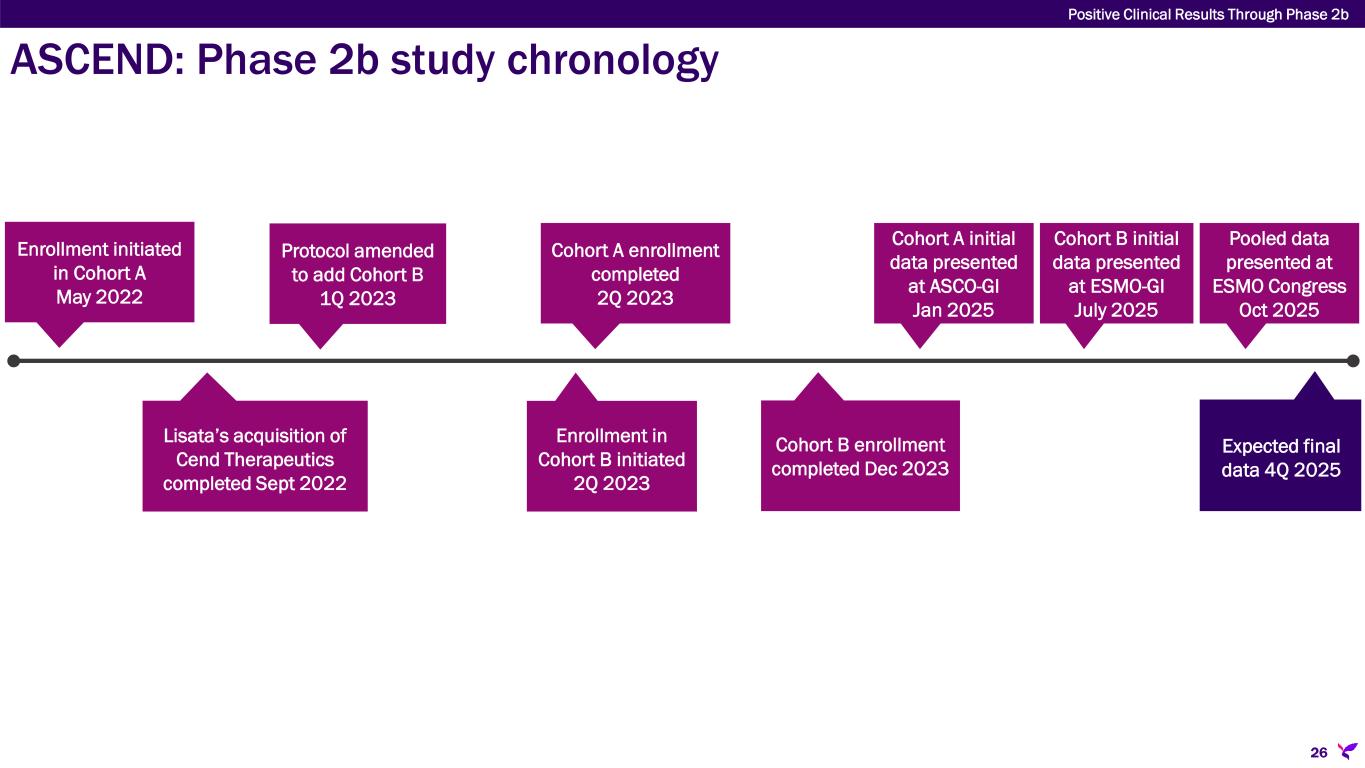
ASCEND: Phase 2b study chronology 26 Positive Clinical Results Through Phase 2b Enrollment initiated in Cohort A May 2022 Lisata’s acquisition of Cend Therapeutics completed Sept 2022 Protocol amended to add Cohort B 1Q 2023 Enrollment in Cohort B initiated 2Q 2023 Cohort A enrollment completed 2Q 2023 Expected final data 4Q 2025 Cohort B enrollment completed Dec 2023 Cohort A initial data presented at ASCO-GI Jan 2025 Cohort B initial data presented at ESMO-GI July 2025 Pooled data presented at ESMO Congress Oct 2025
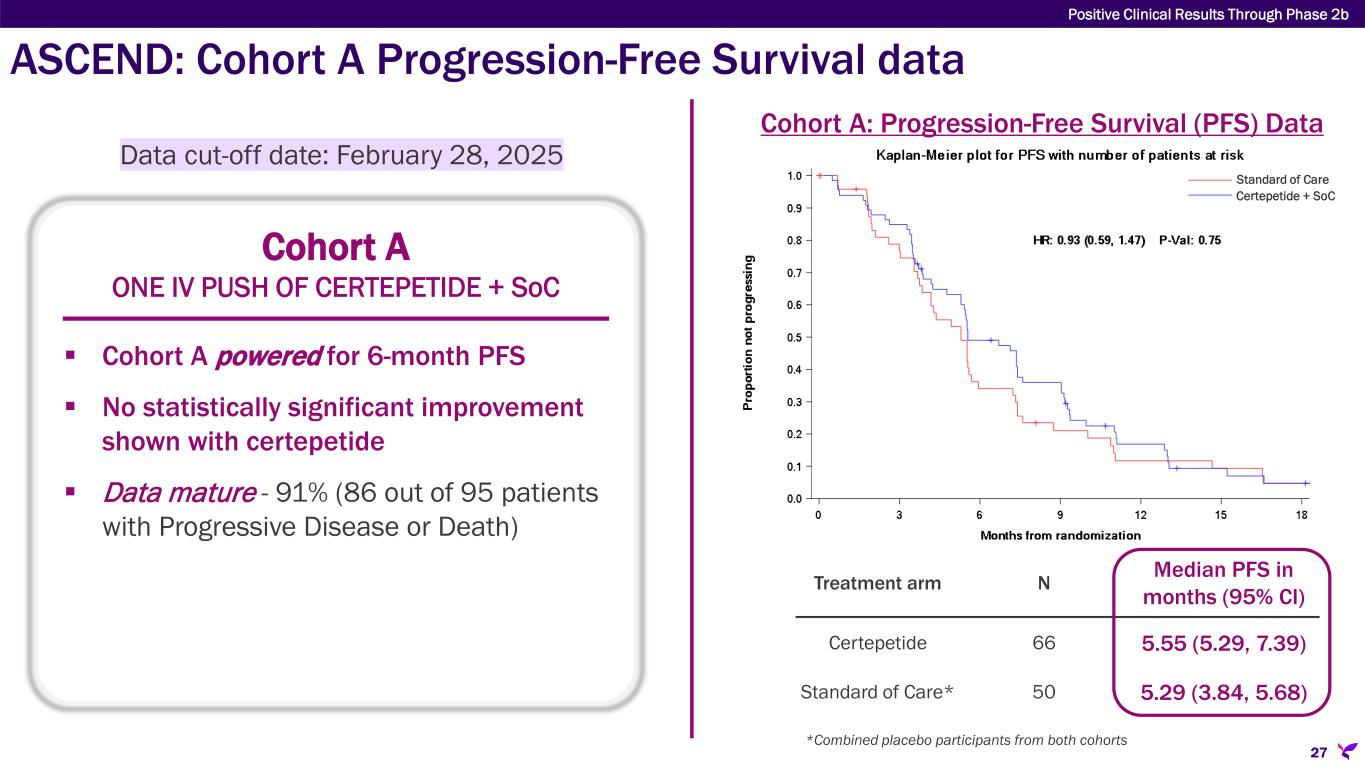
ASCEND: Cohort A Progression-Free Survival data Cohort A ONE IV PUSH OF CERTEPETIDE + SoC Cohort A powered for 6-month PFS No statistically significant improvement shown with certepetide Data mature - 91% (86 out of 95 patients with Progressive Disease or Death) Cohort A: Progression-Free Survival (PFS) Data Treatment arm N Median PFS in months (95% CI) Certepetide 66 5.55 (5.29, 7.39) Standard of Care* 50 5.29 (3.84, 5.68) 27 Data cut-off date: February 28, 2025 Positive Clinical Results Through Phase 2b *Combined placebo participants from both cohorts Certepetide + SoC Standard of Care

ASCEND: Cohort A Overall Survival data Cohort A ONE IV PUSH OF CERTEPETIDE + SoC Cohort A not powered for OS Data mature - 76% (72 deaths out of 95) mOS numerically favors certepetide (12.68 vs. 9.23 months); separation occurs at 7 months similar to NAPOLI-3 Cohort A ORR* data favors certepetide Certepetide – 4 complete responses Placebo – 0 complete responses Cohort A: Overall Survival (OS) Data Treatment arm Participants Median OS in months (95% CI) Certepetide 66 12.68 (10.18, 16.30) Standard of Care* 50 9.23 (7.33, 13.50) *ORR: Objective Response Rate Positive Clinical Results Through Phase 2b 28 Data cut-off date: February 28, 2025 *Combined placebo participants from both cohorts Certepetide + SoC Standard of Care
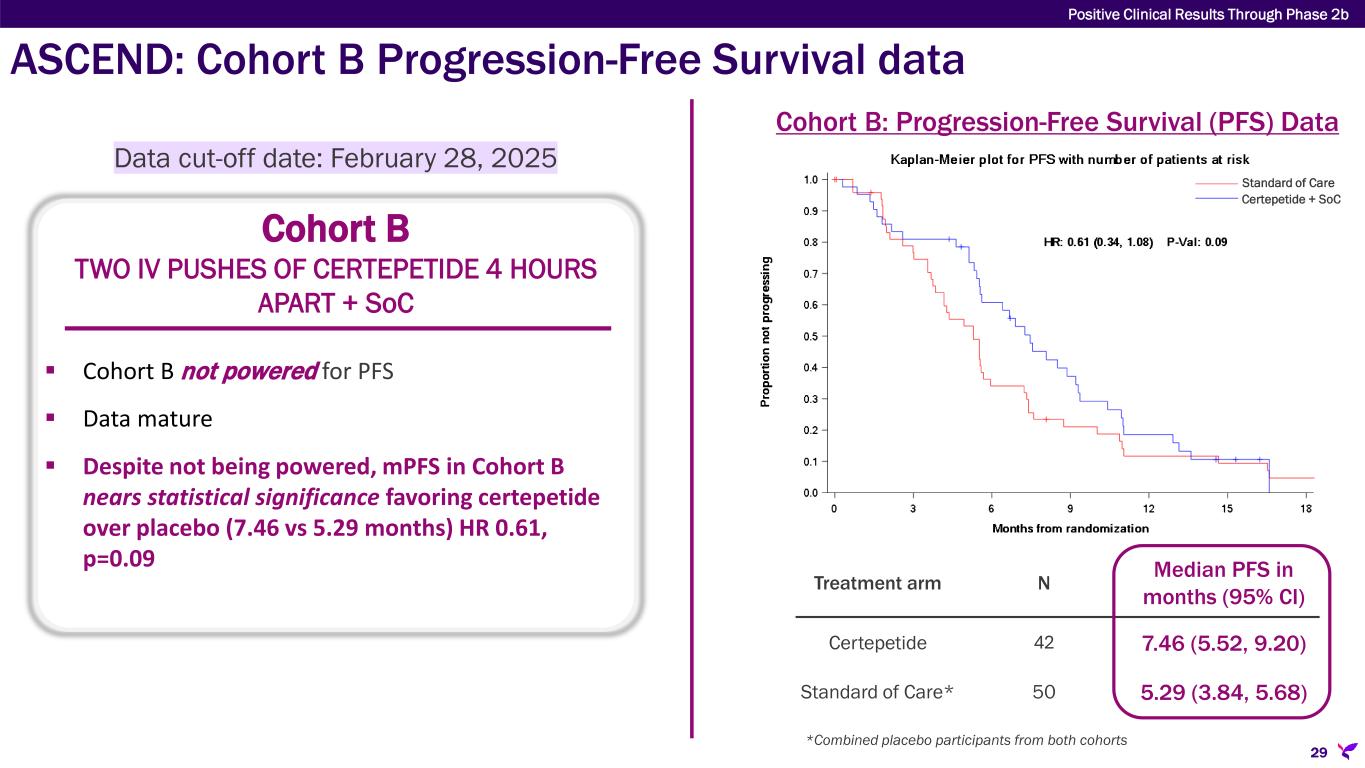
ASCEND: Cohort B Progression-Free Survival data Cohort B TWO IV PUSHES OF CERTEPETIDE 4 HOURS APART + SoC Cohort B: Progression-Free Survival (PFS) Data Treatment arm N Median PFS in months (95% CI) Certepetide 42 7.46 (5.52, 9.20) Standard of Care* 50 5.29 (3.84, 5.68) Cohort B not powered for PFS Data mature Despite not being powered, mPFS in Cohort B nears statistical significance favoring certepetide over placebo (7.46 vs 5.29 months) HR 0.61, p=0.09 Positive Clinical Results Through Phase 2b 29 Data cut-off date: February 28, 2025 *Combined placebo participants from both cohorts Certepetide + SoC Standard of Care

ASCEND: Cohort B Overall Survival data Cohort B TWO IV PUSHES OF CERTEPETIDE 4 HOURS APART + SoC Cohort B not powered for OS Data mature - 71% (45 deaths out of 63) mOS favors certepetide (10.32 vs. 9.23 months) Separation occurs at 7 months similar to NAPOLI-3 NALIRIFOX Phase 3 study data Cohort B ORR favors certepetide (see next slide) (CR + PR) 45% vs 19% certepetide vs placebo; 1 CR certepetide, 0 CR placebo group Cohort B: Overall Survival (OS) Data Treatment arm Participants Median OS in months (95% CI) Certepetide 42 10.32 (8.87, 13.14) Standard of Care* 50 9.23 (7.33, 13.50) Positive Clinical Results Through Phase 2b 30 Data cut-off date: February 28, 2025 *Combined placebo participants from both cohorts Certepetide + SoC Standard of Care
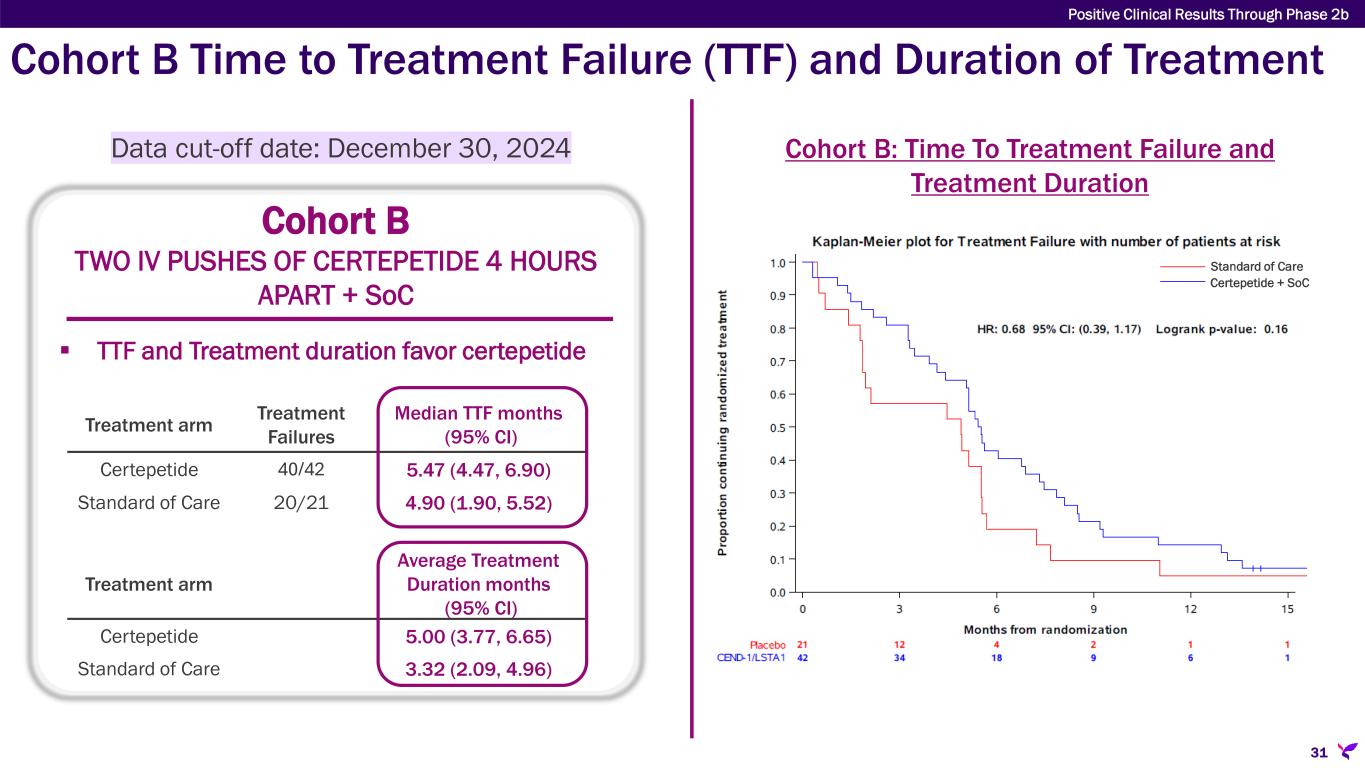
Cohort B Time to Treatment Failure (TTF) and Duration of Treatment Cohort B TWO IV PUSHES OF CERTEPETIDE 4 HOURS APART + SoC Cohort B: Time To Treatment Failure and Treatment Duration Treatment arm Treatment Failures Median TTF months (95% CI) Certepetide 40/42 5.47 (4.47, 6.90) Standard of Care 20/21 4.90 (1.90, 5.52) Data cut-off date: December 30, 2024 Treatment arm Average Treatment Duration months (95% CI) Certepetide 5.00 (3.77, 6.65) Standard of Care 3.32 (2.09, 4.96) TTF and Treatment duration favor certepetide Positive Clinical Results Through Phase 2b 31 Certepetide + SoC Standard of Care
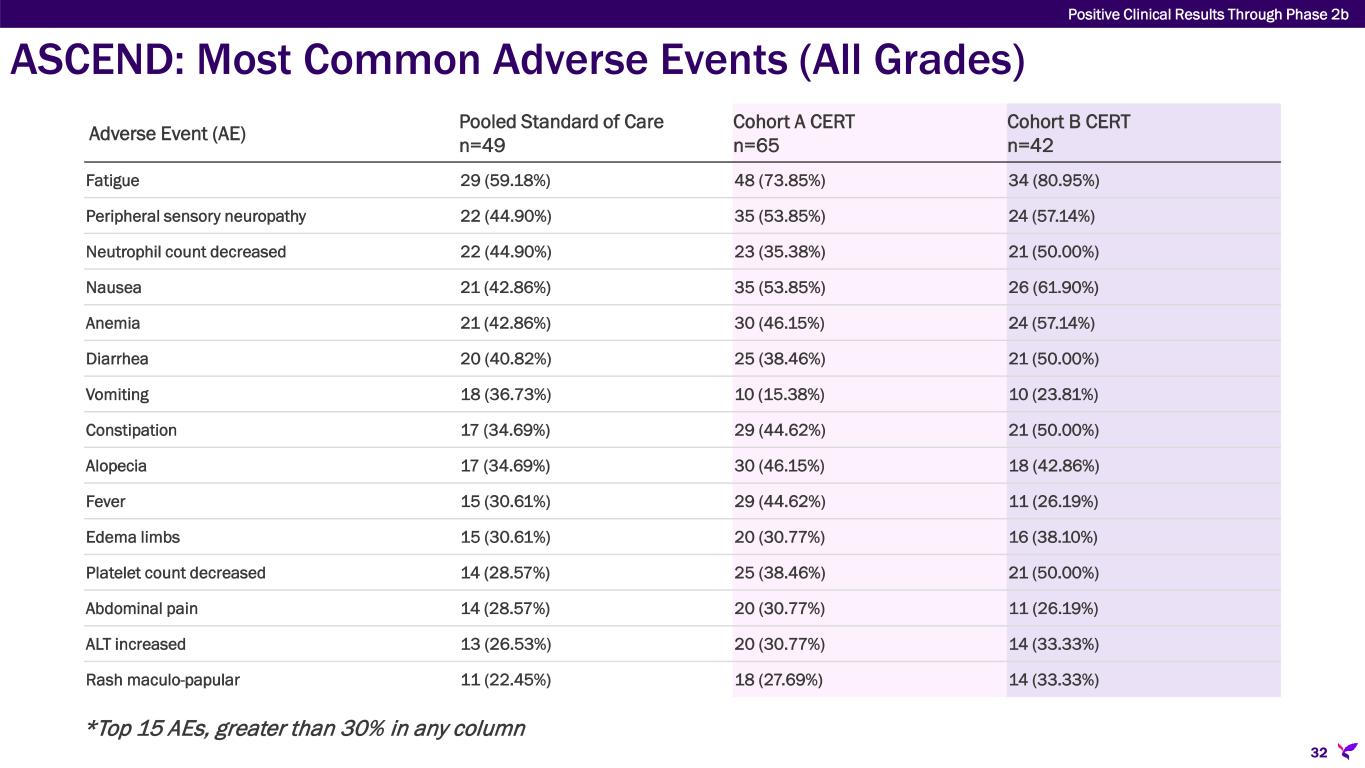
ASCEND: Most Common Adverse Events (All Grades) Positive Clinical Results Through Phase 2b 32 Adverse Event (AE) Pooled Standard of Care n=49 Cohort A CERT n=65 Cohort B CERT n=42 Fatigue 29 (59.18%) 48 (73.85%) 34 (80.95%) Peripheral sensory neuropathy 22 (44.90%) 35 (53.85%) 24 (57.14%) Neutrophil count decreased 22 (44.90%) 23 (35.38%) 21 (50.00%) Nausea 21 (42.86%) 35 (53.85%) 26 (61.90%) Anemia 21 (42.86%) 30 (46.15%) 24 (57.14%) Diarrhea 20 (40.82%) 25 (38.46%) 21 (50.00%) Vomiting 18 (36.73%) 10 (15.38%) 10 (23.81%) Constipation 17 (34.69%) 29 (44.62%) 21 (50.00%) Alopecia 17 (34.69%) 30 (46.15%) 18 (42.86%) Fever 15 (30.61%) 29 (44.62%) 11 (26.19%) Edema limbs 15 (30.61%) 20 (30.77%) 16 (38.10%) Platelet count decreased 14 (28.57%) 25 (38.46%) 21 (50.00%) Abdominal pain 14 (28.57%) 20 (30.77%) 11 (26.19%) ALT increased 13 (26.53%) 20 (30.77%) 14 (33.33%) Rash maculo-papular 11 (22.45%) 18 (27.69%) 14 (33.33%) *Top 15 AEs, greater than 30% in any column
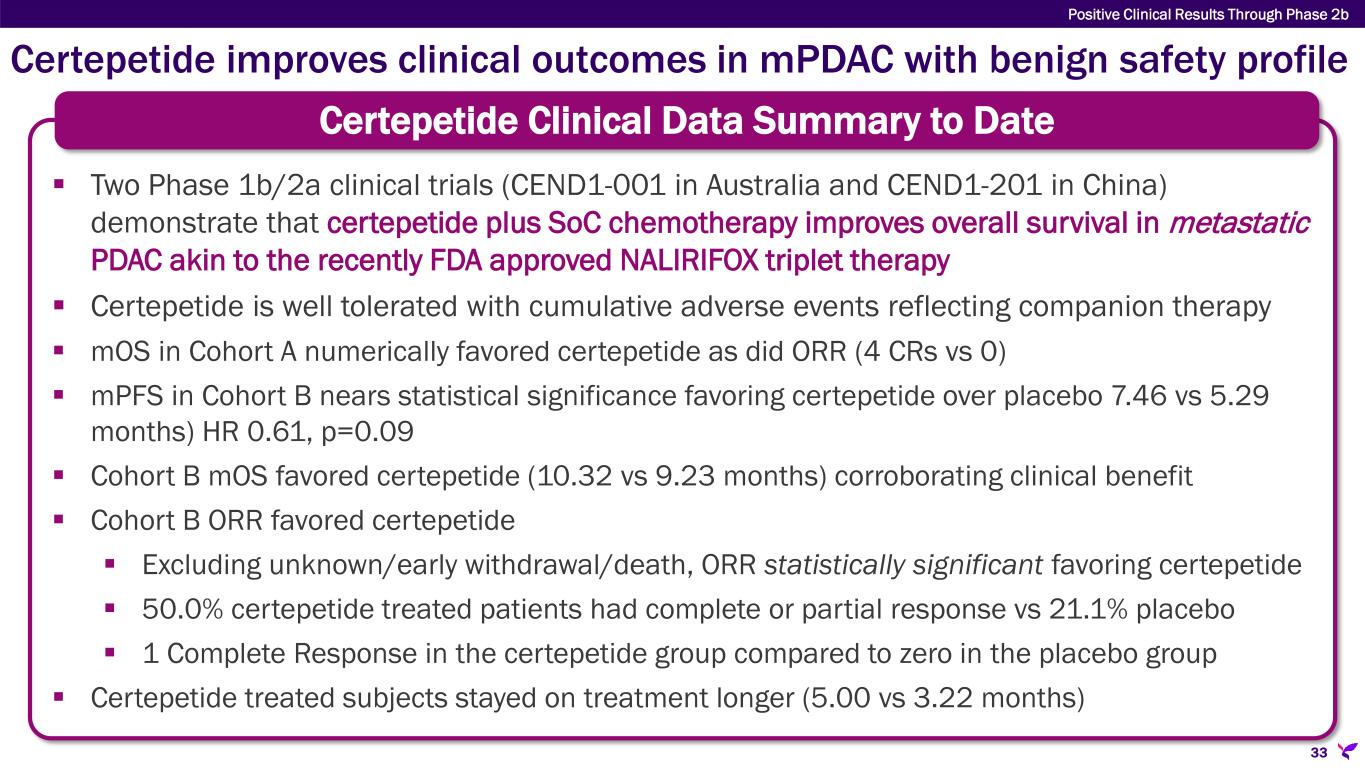
Certepetide improves clinical outcomes in mPDAC with benign safety profile Certepetide Clinical Data Summary to Date 33 Positive Clinical Results Through Phase 2b Two Phase 1b/2a clinical trials (CEND1-001 in Australia and CEND1-201 in China) demonstrate that certepetide plus SoC chemotherapy improves overall survival in metastatic PDAC akin to the recently FDA approved NALIRIFOX triplet therapy Certepetide is well tolerated with cumulative adverse events reflecting companion therapy mOS in Cohort A numerically favored certepetide as did ORR (4 CRs vs 0) mPFS in Cohort B nears statistical significance favoring certepetide over placebo 7.46 vs 5.29 months) HR 0.61, p=0.09 Cohort B mOS favored certepetide (10.32 vs 9.23 months) corroborating clinical benefit Cohort B ORR favored certepetide Excluding unknown/early withdrawal/death, ORR statistically significant favoring certepetide 50.0% certepetide treated patients had complete or partial response vs 21.1% placebo 1 Complete Response in the certepetide group compared to zero in the placebo group Certepetide treated subjects stayed on treatment longer (5.00 vs 3.22 months)
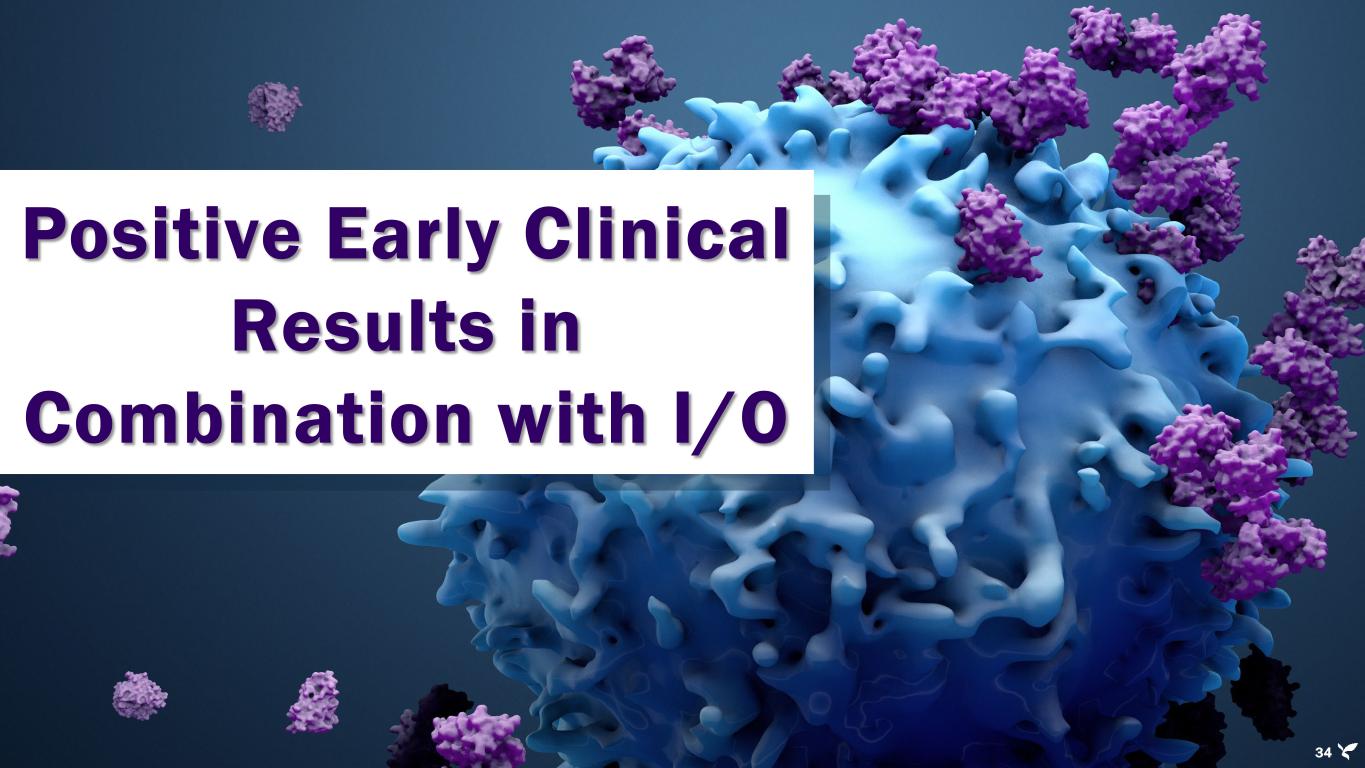
34 Positive Early Clinical Results in Combination with I/O
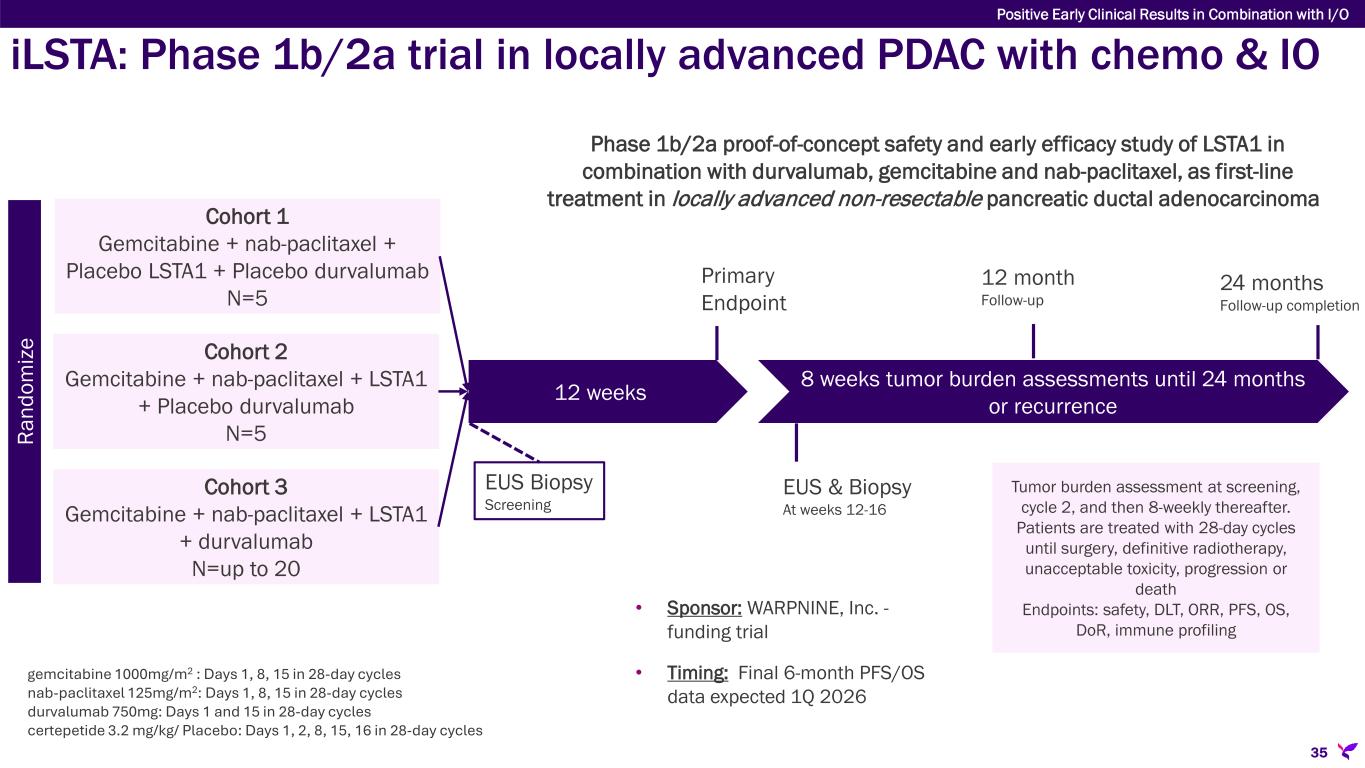
Cohort 2 Gemcitabine + nab-paclitaxel + LSTA1 + Placebo durvalumab N=5 Cohort 1 Gemcitabine + nab-paclitaxel + Placebo LSTA1 + Placebo durvalumab N=5 Cohort 3 Gemcitabine + nab-paclitaxel + LSTA1 + durvalumab N=up to 20 12 weeks 8 weeks tumor burden assessments until 24 months or recurrence 12 month Follow-up Primary Endpoint 24 months Follow-up completion EUS Biopsy Screening EUS & Biopsy At weeks 12-16 Tumor burden assessment at screening, cycle 2, and then 8-weekly thereafter. Patients are treated with 28-day cycles until surgery, definitive radiotherapy, unacceptable toxicity, progression or death Endpoints: safety, DLT, ORR, PFS, OS, DoR, immune profiling Ra nd om iz e Phase 1b/2a proof-of-concept safety and early efficacy study of LSTA1 in combination with durvalumab, gemcitabine and nab-paclitaxel, as first-line treatment in locally advanced non-resectable pancreatic ductal adenocarcinoma • Sponsor: WARPNINE, Inc. - funding trial • Timing: Final 6-month PFS/OS data expected 1Q 2026 35 iLSTA: Phase 1b/2a trial in locally advanced PDAC with chemo & IO gemcitabine 1000mg/m2 : Days 1, 8, 15 in 28-day cycles nab-paclitaxel 125mg/m2: Days 1, 8, 15 in 28-day cycles durvalumab 750mg: Days 1 and 15 in 28-day cycles certepetide 3.2 mg/kg/ Placebo: Days 1, 2, 8, 15, 16 in 28-day cycles Positive Early Clinical Results in Combination with I/O
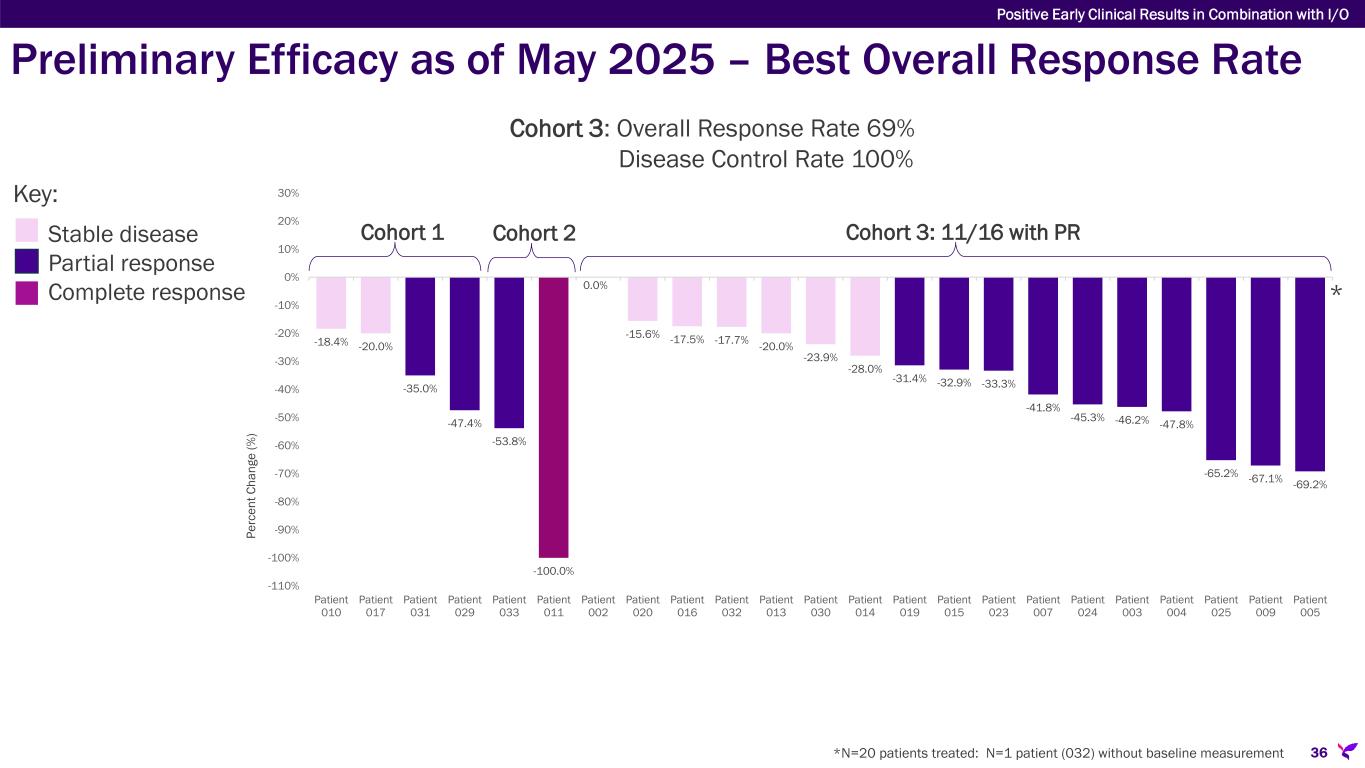
-18.4% -20.0% -35.0% -47.4% -53.8% -100.0% 0.0% -15.6% -17.5% -17.7% -20.0% -23.9% -28.0% -31.4% -32.9% -33.3% -41.8% -45.3% -46.2% -47.8% -65.2% -67.1% -69.2% -110% -100% -90% -80% -70% -60% -50% -40% -30% -20% -10% 0% 10% 20% 30% Patient 010 Patient 017 Patient 031 Patient 029 Patient 033 Patient 011 Patient 002 Patient 020 Patient 016 Patient 032 Patient 013 Patient 030 Patient 014 Patient 019 Patient 015 Patient 023 Patient 007 Patient 024 Patient 003 Patient 004 Patient 025 Patient 009 Patient 005 Preliminary Efficacy as of May 2025 – Best Overall Response Rate *N=20 patients treated: N=1 patient (032) without baseline measurement Cohort 3: 11/16 with PR Key: Stable disease Partial response Complete response Cohort 1 Cohort 2 * Cohort 3: Overall Response Rate 69% Disease Control Rate 100% Pe rc en t C ha ng e (% ) Positive Early Clinical Results in Combination with I/O 36
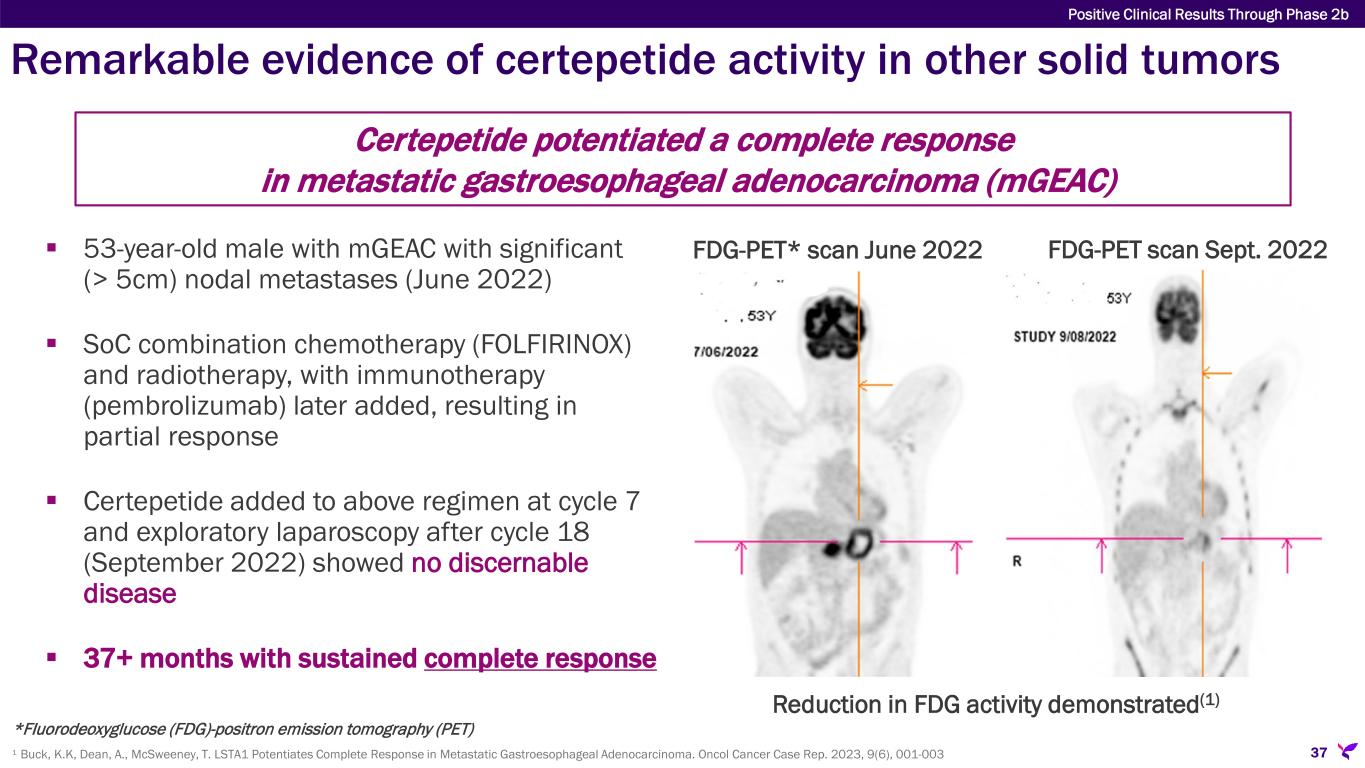
Remarkable evidence of certepetide activity in other solid tumors Certepetide potentiated a complete response in metastatic gastroesophageal adenocarcinoma (mGEAC) FDG-PET* scan June 2022 FDG-PET scan Sept. 2022 Reduction in FDG activity demonstrated(1) 53-year-old male with mGEAC with significant (> 5cm) nodal metastases (June 2022) SoC combination chemotherapy (FOLFIRINOX) and radiotherapy, with immunotherapy (pembrolizumab) later added, resulting in partial response Certepetide added to above regimen at cycle 7 and exploratory laparoscopy after cycle 18 (September 2022) showed no discernable disease 37+ months with sustained complete response 371 Buck, K.K, Dean, A., McSweeney, T. LSTA1 Potentiates Complete Response in Metastatic Gastroesophageal Adenocarcinoma. Oncol Cancer Case Rep. 2023, 9(6), 001-003 *Fluorodeoxyglucose (FDG)-positron emission tomography (PET) Positive Clinical Results Through Phase 2b
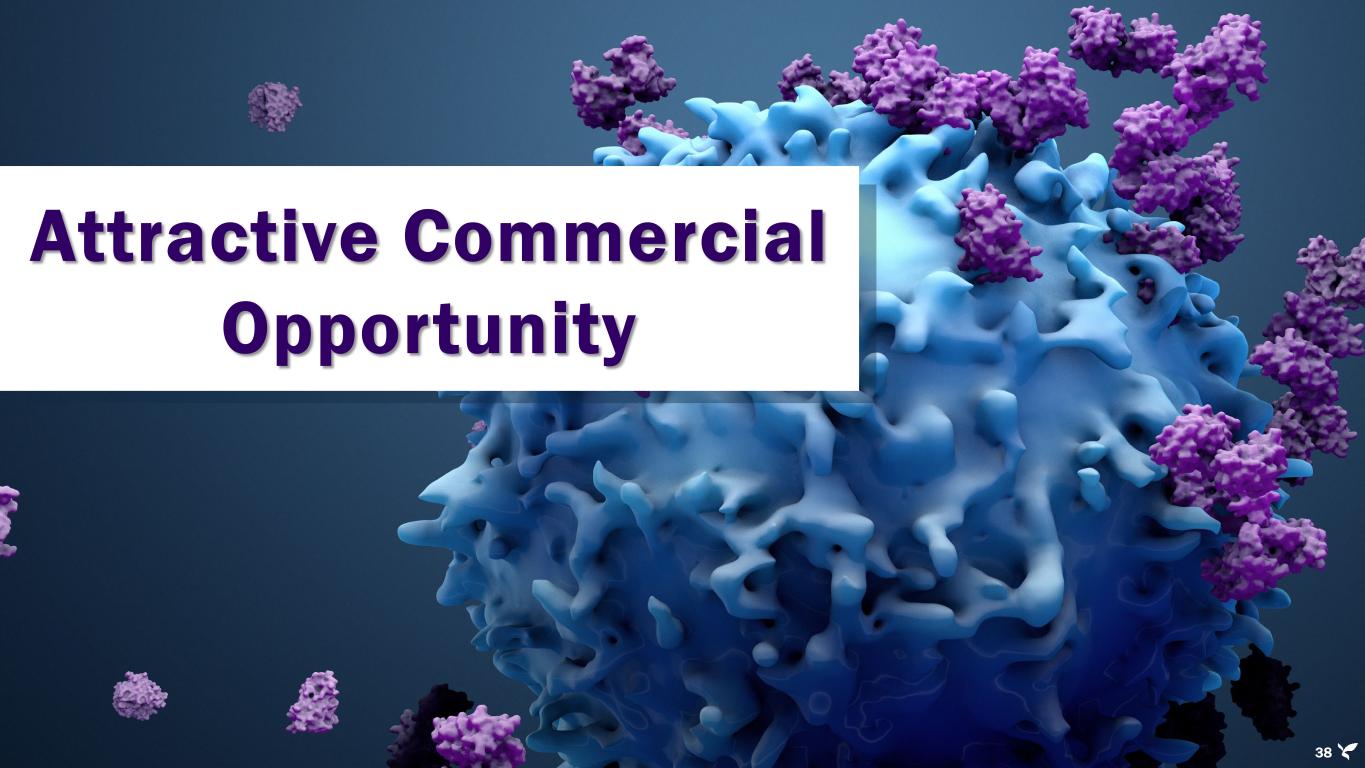
Attractive Commercial Opportunity 38
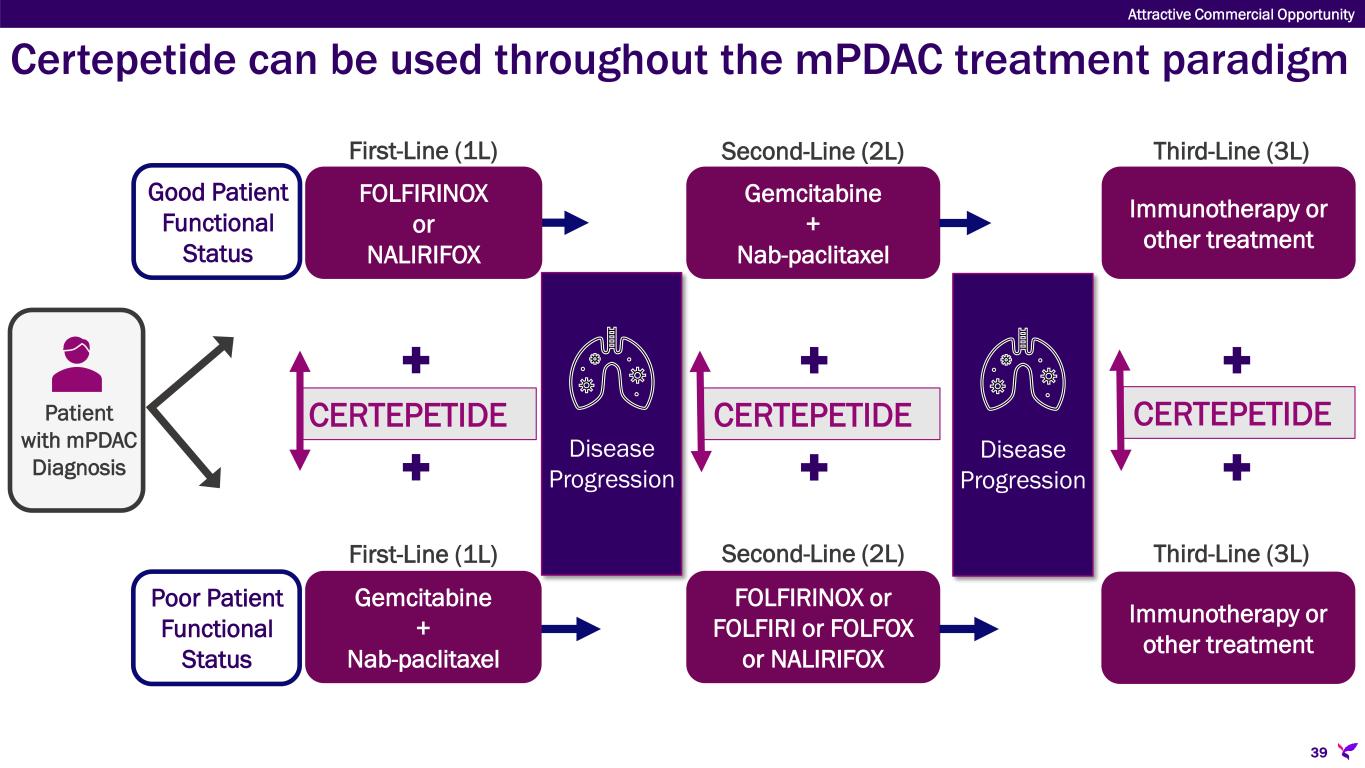
Patient with mPDAC Diagnosis Poor Patient Functional Status Good Patient Functional Status Gemcitabine + Nab-paclitaxel Gemcitabine + Nab-paclitaxel First-Line (1L) First-Line (1L) Disease Progression FOLFIRINOX or NALIRIFOX FOLFIRINOX or FOLFIRI or FOLFOX or NALIRIFOX Second-Line (2L) Second-Line (2L) Immunotherapy or other treatment CERTEPETIDE CERTEPETIDE Immunotherapy or other treatment CERTEPETIDE Third-Line (3L) Third-Line (3L) Certepetide can be used throughout the mPDAC treatment paradigm Attractive Commercial Opportunity Disease Progression 39
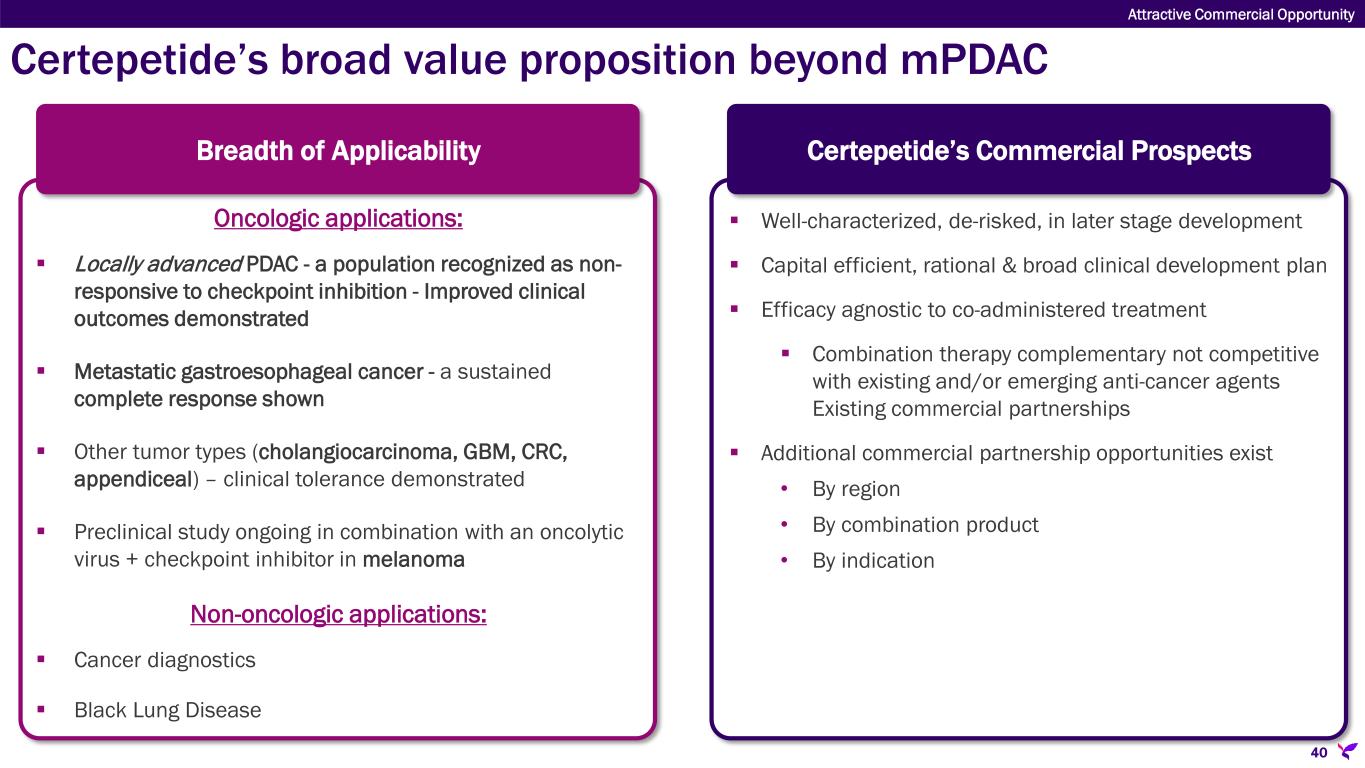
Certepetide’s broad value proposition beyond mPDAC Breadth of Applicability Certepetide’s Commercial Prospects Oncologic applications: Locally advanced PDAC - a population recognized as non- responsive to checkpoint inhibition - Improved clinical outcomes demonstrated Metastatic gastroesophageal cancer - a sustained complete response shown Other tumor types (cholangiocarcinoma, GBM, CRC, appendiceal) – clinical tolerance demonstrated Preclinical study ongoing in combination with an oncolytic virus + checkpoint inhibitor in melanoma Non-oncologic applications: Cancer diagnostics Black Lung Disease Well-characterized, de-risked, in later stage development Capital efficient, rational & broad clinical development plan Efficacy agnostic to co-administered treatment Combination therapy complementary not competitive with existing and/or emerging anti-cancer agents Existing commercial partnerships Additional commercial partnership opportunities exist • By region • By combination product • By indication 40 Attractive Commercial Opportunity
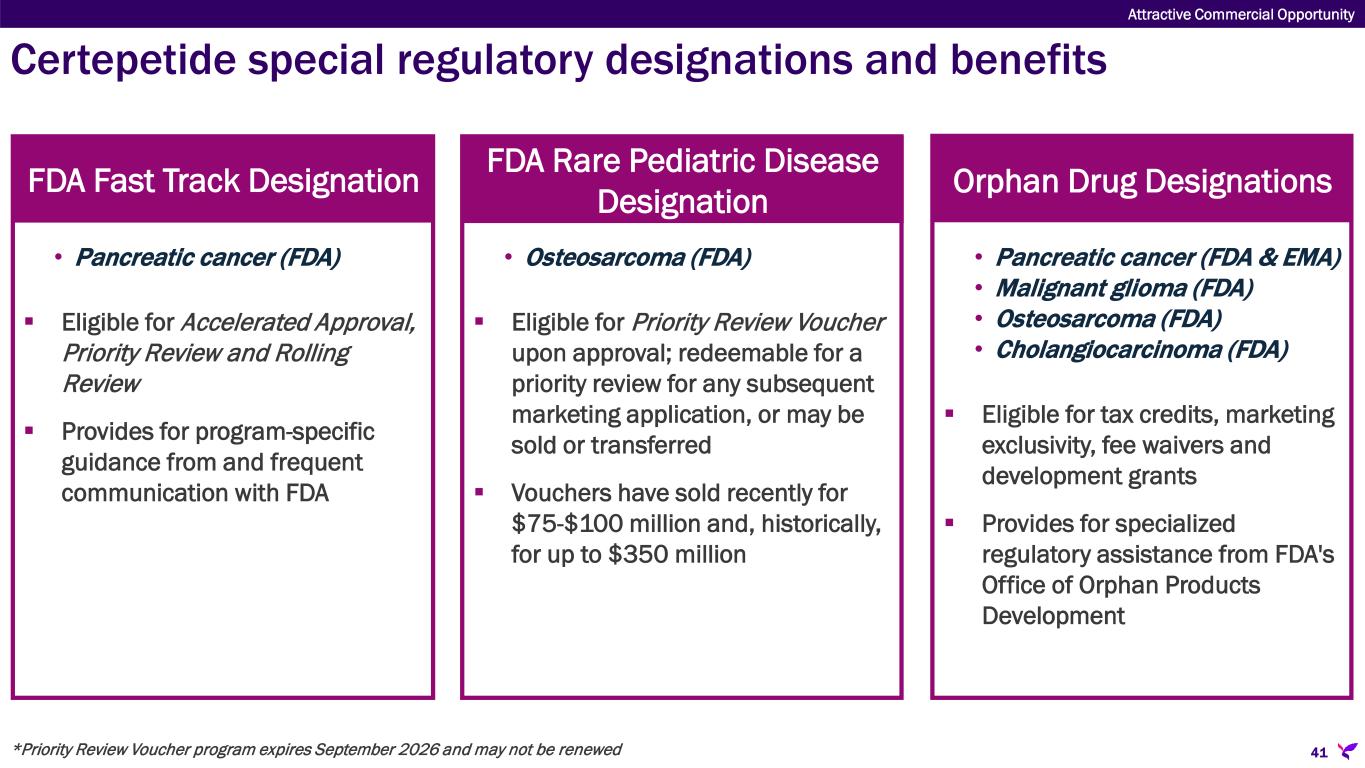
Certepetide special regulatory designations and benefits 41 FDA Fast Track Designation • Pancreatic cancer (FDA) Eligible for Accelerated Approval, Priority Review and Rolling Review Provides for program-specific guidance from and frequent communication with FDA Orphan Drug Designations • Pancreatic cancer (FDA & EMA) • Malignant glioma (FDA) • Osteosarcoma (FDA) • Cholangiocarcinoma (FDA) Eligible for tax credits, marketing exclusivity, fee waivers and development grants Provides for specialized regulatory assistance from FDA's Office of Orphan Products Development FDA Rare Pediatric Disease Designation • Osteosarcoma (FDA) Eligible for Priority Review Voucher upon approval; redeemable for a priority review for any subsequent marketing application, or may be sold or transferred Vouchers have sold recently for $75-$100 million and, historically, for up to $350 million *Priority Review Voucher program expires September 2026 and may not be renewed Attractive Commercial Opportunity
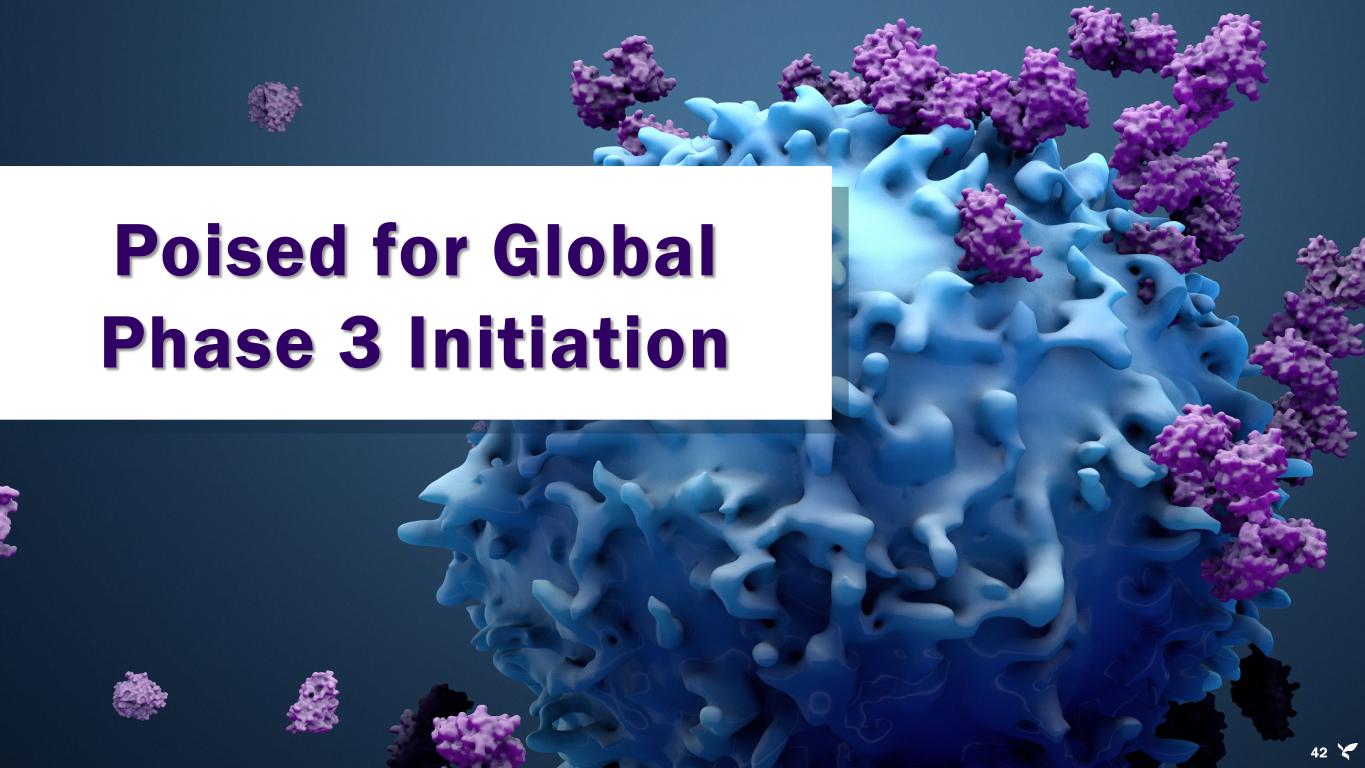
Poised for Global Phase 3 Initiation 42
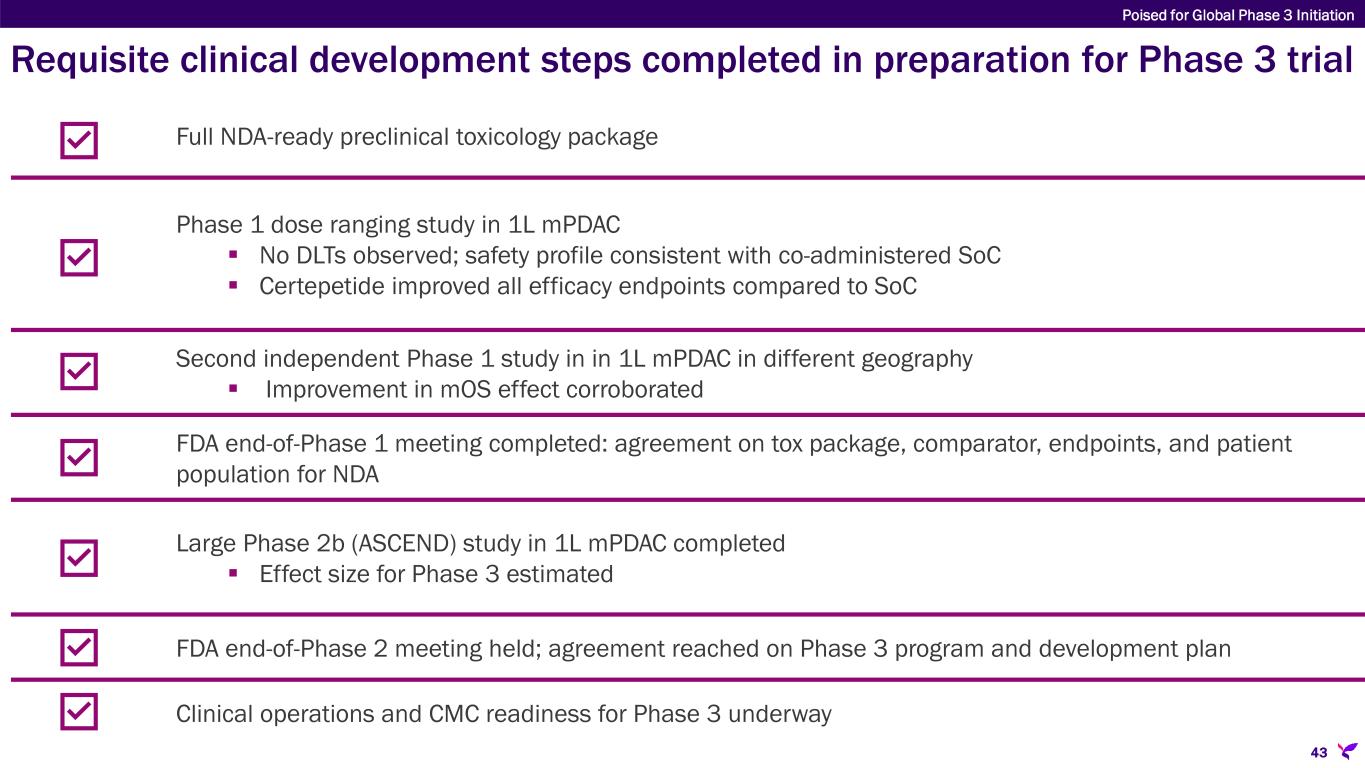
Requisite clinical development steps completed in preparation for Phase 3 trial Full NDA-ready preclinical toxicology package Phase 1 dose ranging study in 1L mPDAC No DLTs observed; safety profile consistent with co-administered SoC Certepetide improved all efficacy endpoints compared to SoC Second independent Phase 1 study in in 1L mPDAC in different geography Improvement in mOS effect corroborated FDA end-of-Phase 1 meeting completed: agreement on tox package, comparator, endpoints, and patient population for NDA Large Phase 2b (ASCEND) study in 1L mPDAC completed Effect size for Phase 3 estimated FDA end-of-Phase 2 meeting held; agreement reached on Phase 3 program and development plan Clinical operations and CMC readiness for Phase 3 underway Poised for Global Phase 3 Initiation 43

mPDAC Phase 3 study design agreed with FDA Global Phase 3, open-label, randomized clinical trial evaluating the efficacy and safety of certepetide in combination with standard of care (gemcitabine and nab-paclitaxel) vs. standard of care alone in patients with 1L mPDAC N=657 patients (+/- 50 depending on event rate) Primary endpoint: Overall Survival 90% Power, HR of 0.75 18 months accrual (assuming 0.2 patients/site/month), 16 months observation period 183 clinical sites in ~15 countries Open-label study acceptance precedent with global health authorities (e.g., NAPOLI-3) End-of-Phase 2 FDA meeting held May 21, 2025 – FDA agreement with study key elements FDA amenable to addition of multiple dosing arms (e.g., continuous infusion) 44 Poised for Global Phase 3 Initiation

45 Certepetide Development Portfolio
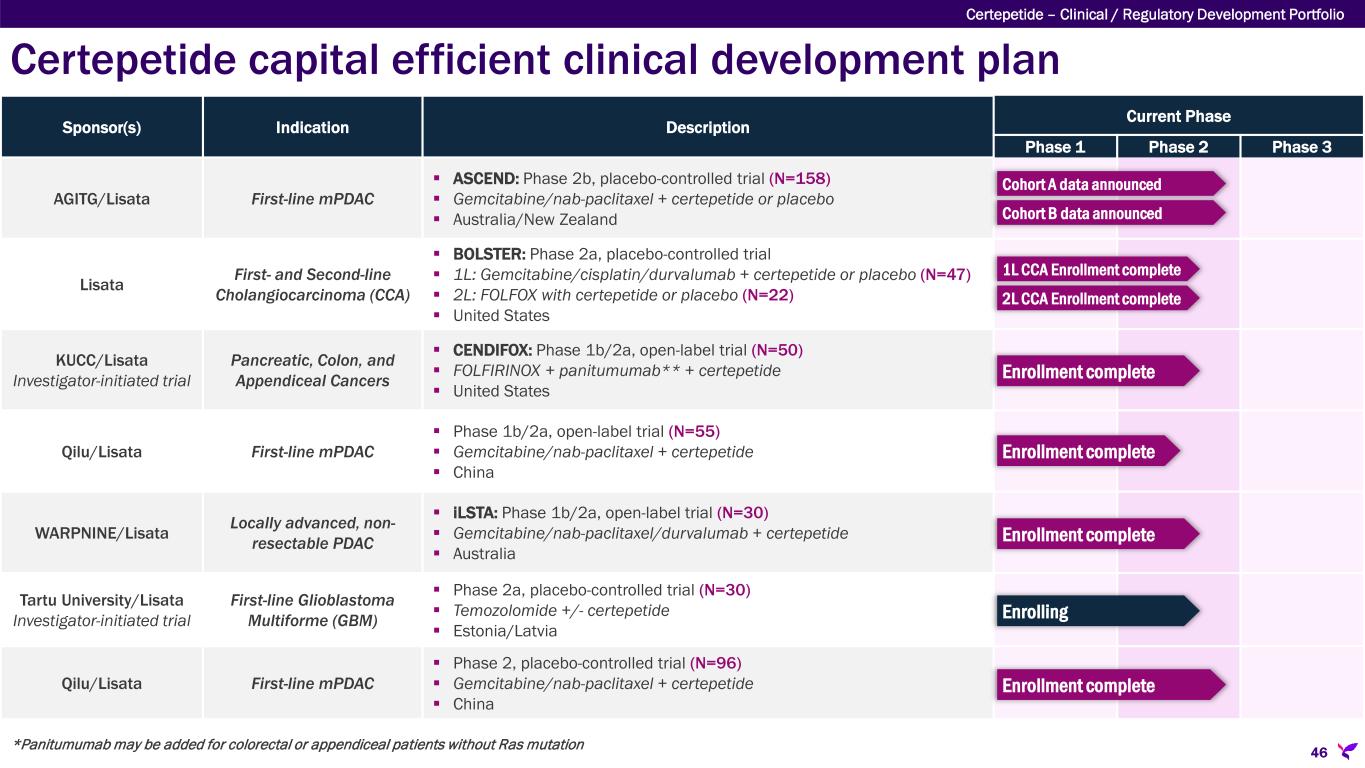
Certepetide capital efficient clinical development plan Certepetide – Clinical / Regulatory Development Portfolio 46 Sponsor(s) Indication Description Current Phase Phase 1 Phase 2 Phase 3 AGITG/Lisata First-line mPDAC ASCEND: Phase 2b, placebo-controlled trial (N=158) Gemcitabine/nab-paclitaxel + certepetide or placebo Australia/New Zealand Lisata First- and Second-line Cholangiocarcinoma (CCA) BOLSTER: Phase 2a, placebo-controlled trial 1L: Gemcitabine/cisplatin/durvalumab + certepetide or placebo (N=47) 2L: FOLFOX with certepetide or placebo (N=22) United States KUCC/Lisata Investigator-initiated trial Pancreatic, Colon, and Appendiceal Cancers CENDIFOX: Phase 1b/2a, open-label trial (N=50) FOLFIRINOX + panitumumab** + certepetide United States Qilu/Lisata First-line mPDAC Phase 1b/2a, open-label trial (N=55) Gemcitabine/nab-paclitaxel + certepetide China WARPNINE/Lisata Locally advanced, non- resectable PDAC iLSTA: Phase 1b/2a, open-label trial (N=30) Gemcitabine/nab-paclitaxel/durvalumab + certepetide Australia Tartu University/Lisata Investigator-initiated trial First-line Glioblastoma Multiforme (GBM) Phase 2a, placebo-controlled trial (N=30) Temozolomide +/- certepetide Estonia/Latvia Qilu/Lisata First-line mPDAC Phase 2, placebo-controlled trial (N=96) Gemcitabine/nab-paclitaxel + certepetide China Enrollment complete Enrollment complete Enrollment complete *Panitumumab may be added for colorectal or appendiceal patients without Ras mutation Enrolling Enrollment complete 1L CCA Enrollment complete 2L CCA Enrollment complete Cohort A data announced Cohort B data announced
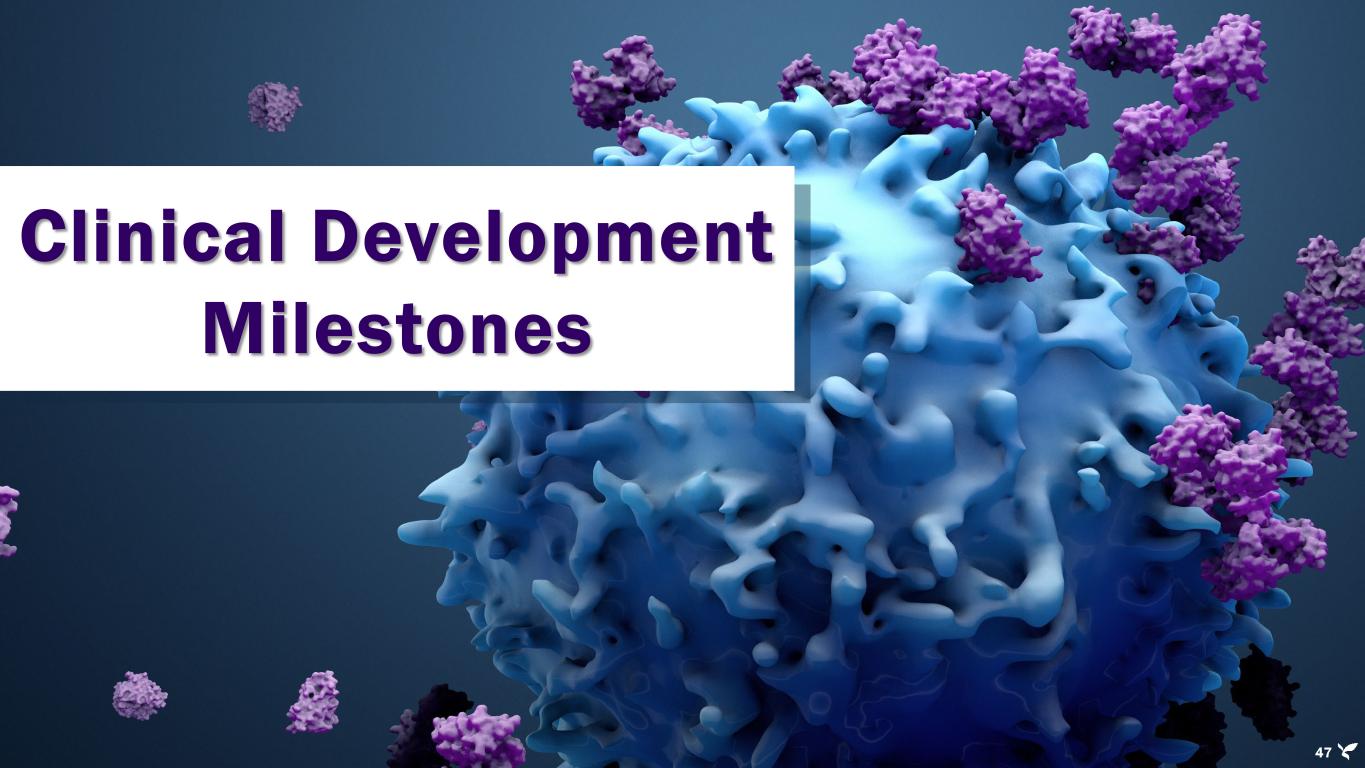
Clinical Development Milestones 47

A wealth of key certepetide clinical milestones Clinical Development Milestones 48 1Q 2024 2Q 2024 3Q 2024 4Q 2024 1Q 2025 2Q 2025 3Q 2025 4Q 2025 1Q 2026 2Q 2026 ASCEND [AUS, NZ] First-line mPDAC BOLSTER [USA] First- and second-line CCA CENDIFOX [USA] Pancreatic, Colon and Appendiceal Cancers iLSTA [AUS] Locally advanced, non-resectable PDAC Phase 2a [EST, LATV, LTU] First-line GBM Qilu: Phase 2 [CHN] First-line mPDAC Catalent ADC Program Difficult-to-treat diseases *Several of these studies are investigator-initiated trials. Lisata has limited control and thus, timelines and expectations may be subject to change. PFS: Progression-free Survival OS: Overall Survival ORR: Objective Response Rate EOP2: End-of-Phase 2 First patient in Last patient in Interim analysis Data Final data Milestone achievedSafety run-in analysis Cohort A data Final Cohort A & B PFS/OS data FDA EOP2 meeting Cohort B data 1L CCA LPI Achieved 6 months early 2L CCA FPI 2L CCA LPI 1L OS data 2L OS data target: mid-2026 PDAC cohort Colon and Appendiceal cohorts Preliminary data for Colon and Appendiceal cohorts LPI Final 6-month PFS/OS data Safety run-in analysis LPI Enrollment complete LPI ORR data Preclinical data
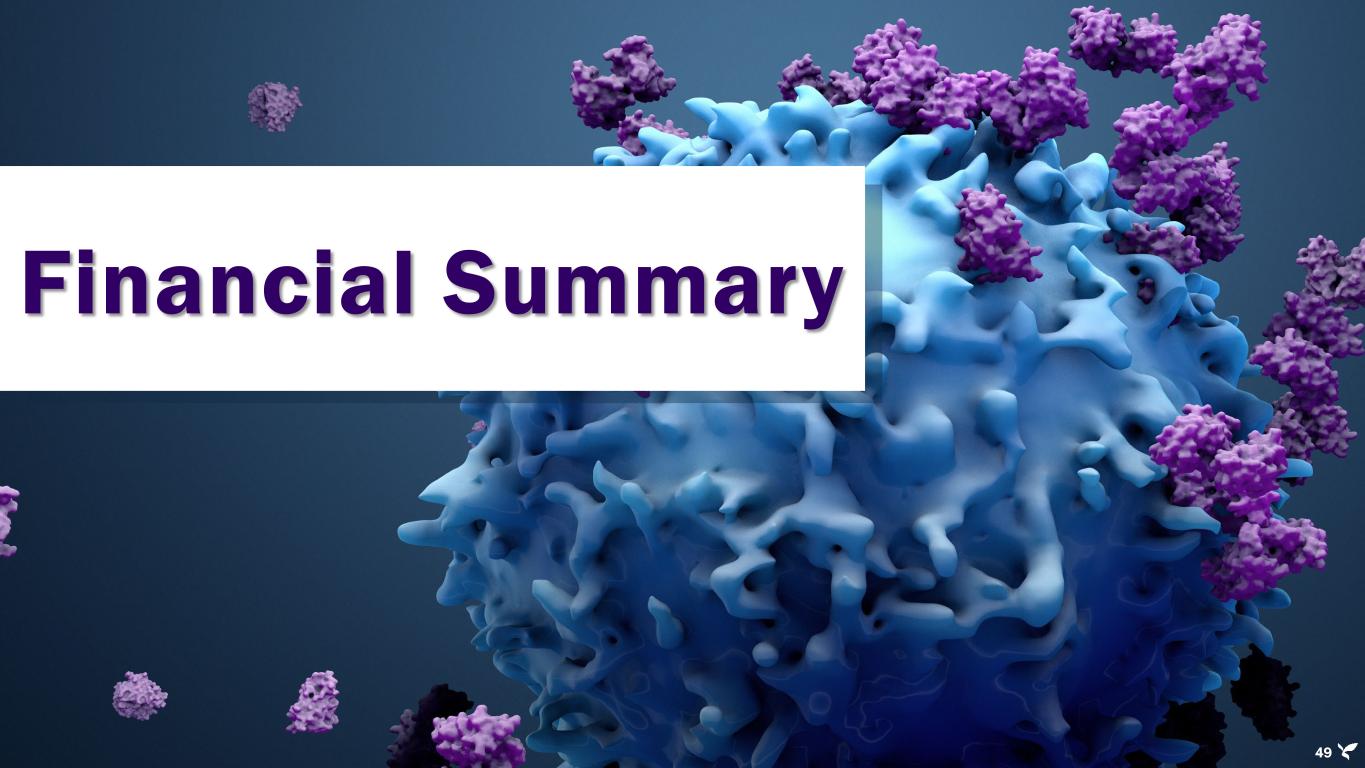
49 Financial Summary
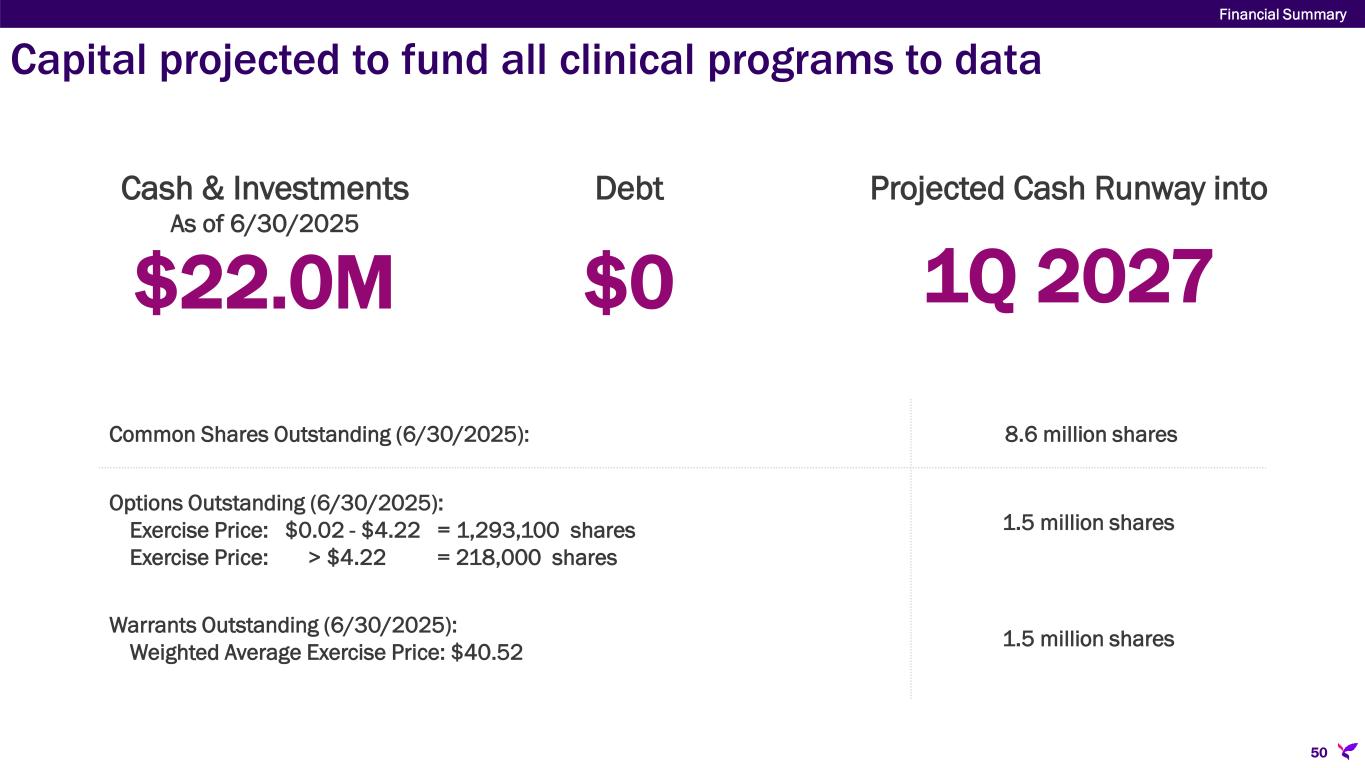
Capital projected to fund all clinical programs to data Financial Summary 50 $22.0M Cash & Investments As of 6/30/2025 $0 Debt 1Q 2027 Projected Cash Runway into Common Shares Outstanding (6/30/2025): 8.6 million shares Options Outstanding (6/30/2025): Exercise Price: $0.02 - $4.22 = 1,293,100 shares Exercise Price: > $4.22 = 218,000 shares 1.5 million shares Warrants Outstanding (6/30/2025): Weighted Average Exercise Price: $40.52 1.5 million shares

* As of 6/30/2025; includes investments Key factors supporting investment in Lisata Therapeutics 51 Strong Investment Rationale PEOPLE Seasoned management with successful international drug development experience and expertise INTELLECTUAL PROPERTY Proprietary field- leading technology with global IP protection extending beyond 2040 MILESTONES Multiple product and business milestones projected over the next 12 months CAPITAL $22.0 million cash*- no debt; Funds to support advancement of current clinical programs PARTNERING Platform technology validated by existing partnerships with potential for many others

© L i s a t a T h e r a p e u t i c s , I n c . 2 0 2 5 . A l l r i g h t s r e s e r v e d . Investor Relations Contact: John D. Menditto VP, IR & Corporate Communications Tel: (908) 842-0084 | Email: jmenditto@lisata.com Nasdaq: LSTA | www.lisata.com Targeted Therapy Delivered
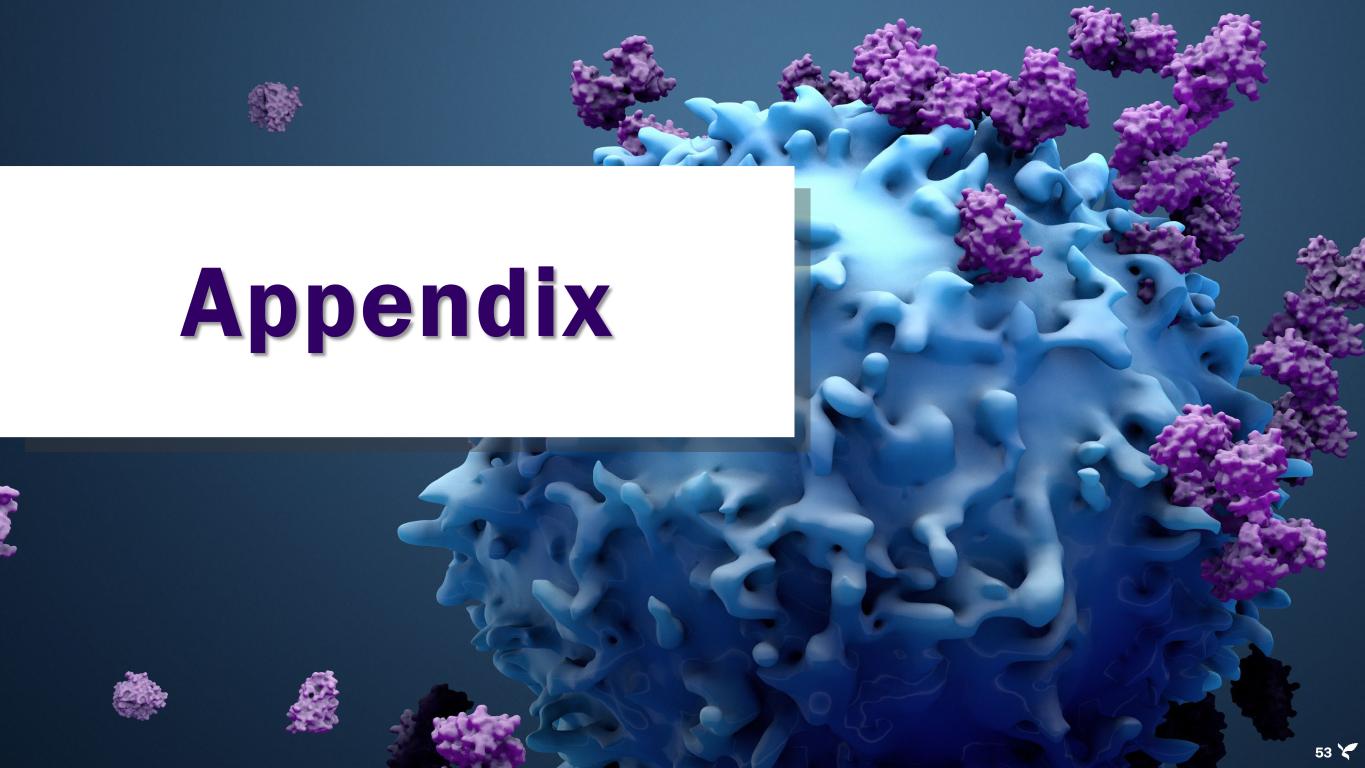
Appendix 53
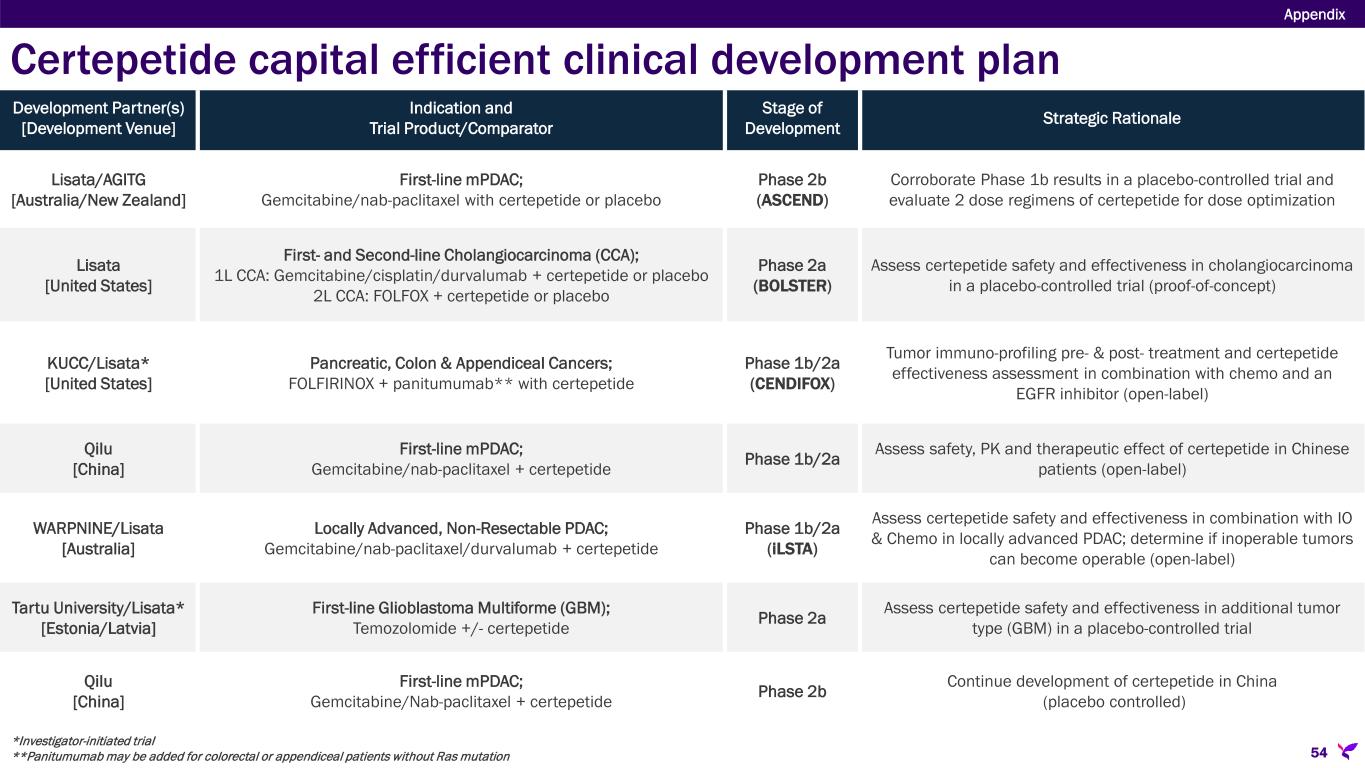
Appendix Certepetide capital efficient clinical development plan Development Partner(s) [Development Venue] Indication and Trial Product/Comparator Stage of Development Strategic Rationale Lisata/AGITG [Australia/New Zealand] First-line mPDAC; Gemcitabine/nab-paclitaxel with certepetide or placebo Phase 2b (ASCEND) Corroborate Phase 1b results in a placebo-controlled trial and evaluate 2 dose regimens of certepetide for dose optimization Lisata [United States] First- and Second-line Cholangiocarcinoma (CCA); 1L CCA: Gemcitabine/cisplatin/durvalumab + certepetide or placebo 2L CCA: FOLFOX + certepetide or placebo Phase 2a (BOLSTER) Assess certepetide safety and effectiveness in cholangiocarcinoma in a placebo-controlled trial (proof-of-concept) KUCC/Lisata* [United States] Pancreatic, Colon & Appendiceal Cancers; FOLFIRINOX + panitumumab** with certepetide Phase 1b/2a (CENDIFOX) Tumor immuno-profiling pre- & post- treatment and certepetide effectiveness assessment in combination with chemo and an EGFR inhibitor (open-label) Qilu [China] First-line mPDAC; Gemcitabine/nab-paclitaxel + certepetide Phase 1b/2a Assess safety, PK and therapeutic effect of certepetide in Chinese patients (open-label) WARPNINE/Lisata [Australia] Locally Advanced, Non-Resectable PDAC; Gemcitabine/nab-paclitaxel/durvalumab + certepetide Phase 1b/2a (iLSTA) Assess certepetide safety and effectiveness in combination with IO & Chemo in locally advanced PDAC; determine if inoperable tumors can become operable (open-label) Tartu University/Lisata* [Estonia/Latvia] First-line Glioblastoma Multiforme (GBM); Temozolomide +/- certepetide Phase 2a Assess certepetide safety and effectiveness in additional tumor type (GBM) in a placebo-controlled trial Qilu [China] First-line mPDAC; Gemcitabine/Nab-paclitaxel + certepetide Phase 2b Continue development of certepetide in China (placebo controlled) *Investigator-initiated trial **Panitumumab may be added for colorectal or appendiceal patients without Ras mutation 54
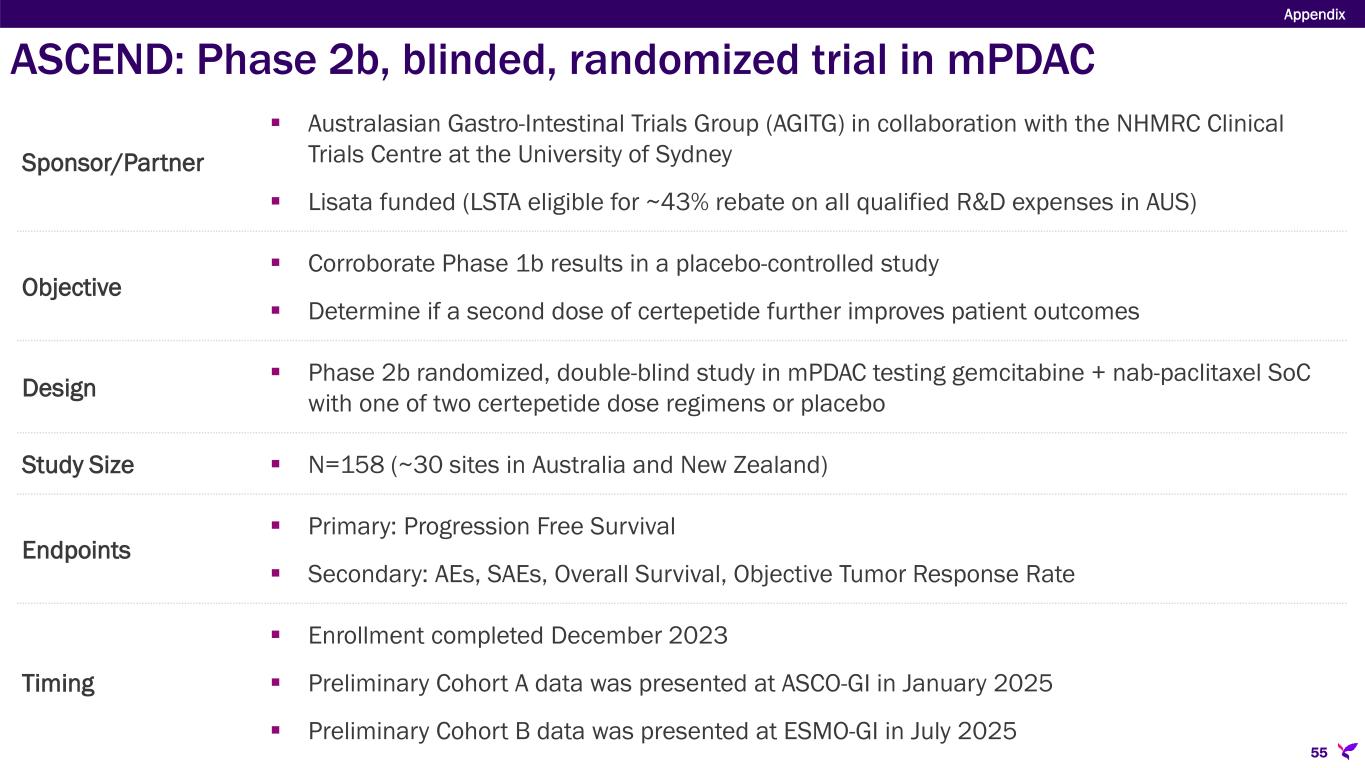
ASCEND: Phase 2b, blinded, randomized trial in mPDAC 55 Appendix Sponsor/Partner Australasian Gastro-Intestinal Trials Group (AGITG) in collaboration with the NHMRC Clinical Trials Centre at the University of Sydney Lisata funded (LSTA eligible for ~43% rebate on all qualified R&D expenses in AUS) Objective Corroborate Phase 1b results in a placebo-controlled study Determine if a second dose of certepetide further improves patient outcomes Design Phase 2b randomized, double-blind study in mPDAC testing gemcitabine + nab-paclitaxel SoC with one of two certepetide dose regimens or placebo Study Size N=158 (~30 sites in Australia and New Zealand) Endpoints Primary: Progression Free Survival Secondary: AEs, SAEs, Overall Survival, Objective Tumor Response Rate Timing Enrollment completed December 2023 Preliminary Cohort A data was presented at ASCO-GI in January 2025 Preliminary Cohort B data was presented at ESMO-GI in July 2025
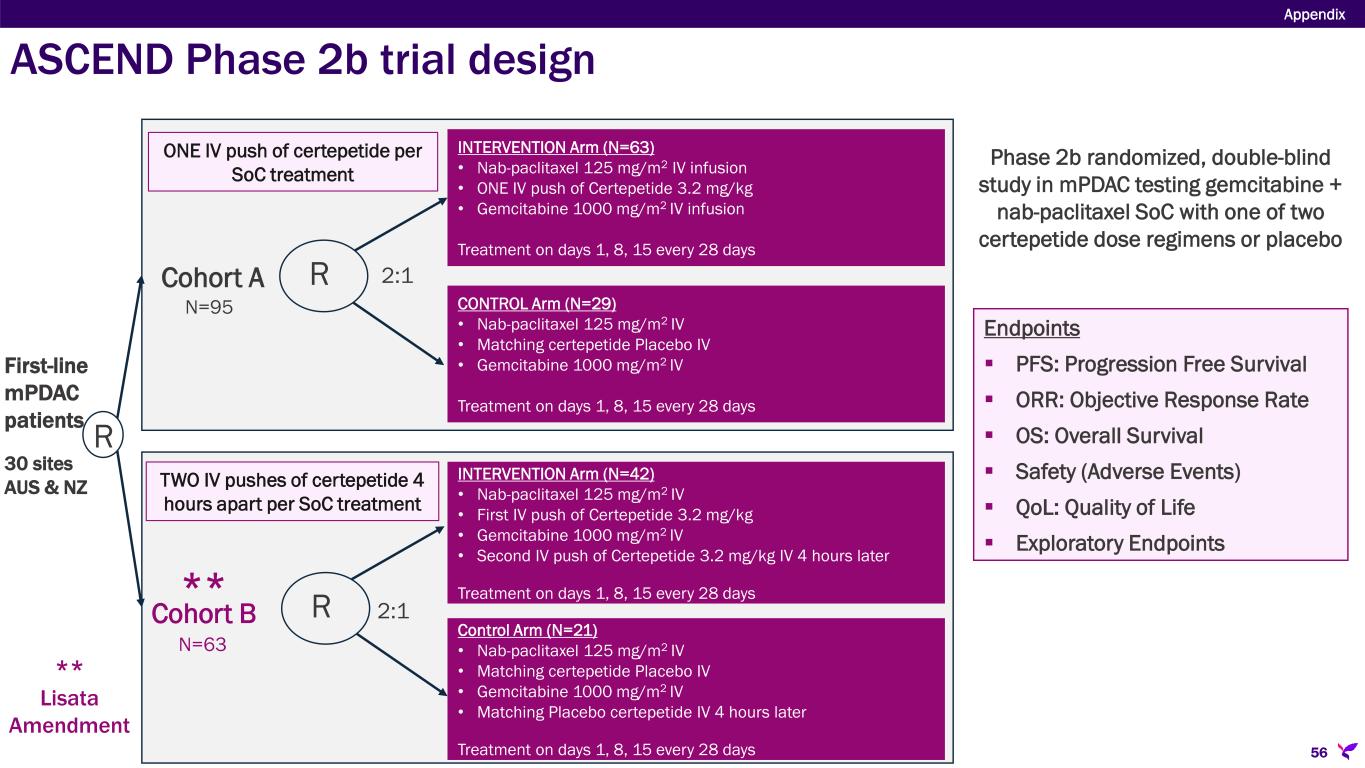
R INTERVENTION Arm (N=63) • Nab-paclitaxel 125 mg/m2 IV infusion • ONE IV push of Certepetide 3.2 mg/kg • Gemcitabine 1000 mg/m2 IV infusion Treatment on days 1, 8, 15 every 28 days CONTROL Arm (N=29) • Nab-paclitaxel 125 mg/m2 IV • Matching certepetide Placebo IV • Gemcitabine 1000 mg/m2 IV Treatment on days 1, 8, 15 every 28 days INTERVENTION Arm (N=42) • Nab-paclitaxel 125 mg/m2 IV • First IV push of Certepetide 3.2 mg/kg • Gemcitabine 1000 mg/m2 IV • Second IV push of Certepetide 3.2 mg/kg IV 4 hours later Treatment on days 1, 8, 15 every 28 days Control Arm (N=21) • Nab-paclitaxel 125 mg/m2 IV • Matching certepetide Placebo IV • Gemcitabine 1000 mg/m2 IV • Matching Placebo certepetide IV 4 hours later Treatment on days 1, 8, 15 every 28 days R R Cohort A Cohort B 2:1 2:1 ONE IV push of certepetide per SoC treatment TWO IV pushes of certepetide 4 hours apart per SoC treatment Endpoints PFS: Progression Free Survival ORR: Objective Response Rate OS: Overall Survival Safety (Adverse Events) QoL: Quality of Life Exploratory Endpoints 56 N=95 N=63 First-line mPDAC patients 30 sites AUS & NZ ** Lisata Amendment ** Appendix ASCEND Phase 2b trial design Phase 2b randomized, double-blind study in mPDAC testing gemcitabine + nab-paclitaxel SoC with one of two certepetide dose regimens or placebo

Sponsor/Partner Qilu Pharmaceutical (funds all development in China) Objective Evaluate safety, pharmacokinetics and preliminary efficacy of certepetide added to SoC in Chinese patients with mPDAC Design Phase 1b/2a open-label study in advanced mPDAC patients of Chinese ethnicity testing SoC chemotherapy (gemcitabine + Qilu-produced nab-paclitaxel) in combination with certepetide Study Size N=55 (~15 sites) Endpoints Primary: AEs, SAEs, Objective Response Rate, Duration of Response, Disease Control Rate, Overall Survival, and Progression Free Survival Secondary: Pharmacokinetic parameters Timing Preliminary data was presented at the 2023 ASCO Annual Meeting Appendix 57 Phase 1b/2a open-label trial in mPDAC in China (CEND1-201)
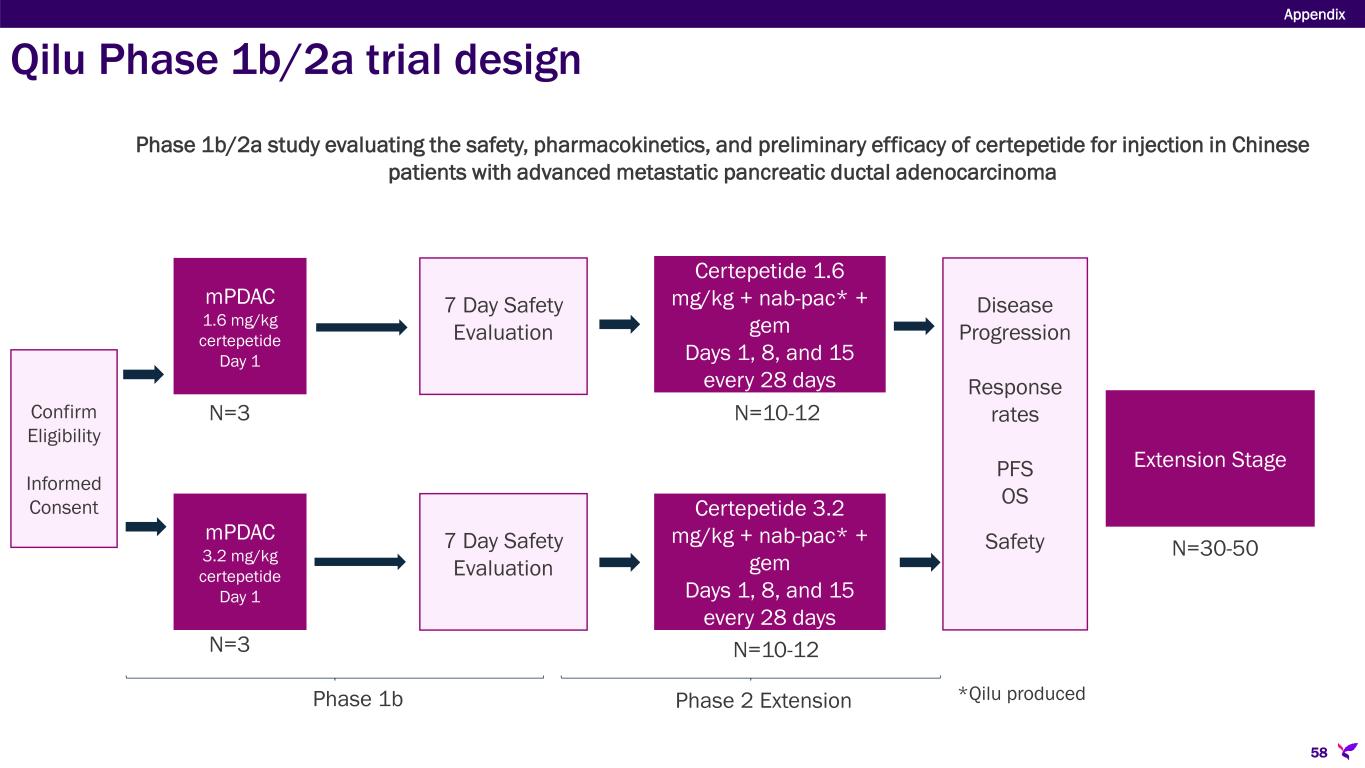
7 Day Safety Evaluation Certepetide 1.6 mg/kg + nab-pac* + gem Days 1, 8, and 15 every 28 days Confirm Eligibility Informed Consent Extension Stage mPDAC 1.6 mg/kg certepetide Day 1 Phase 1b/2a study evaluating the safety, pharmacokinetics, and preliminary efficacy of certepetide for injection in Chinese patients with advanced metastatic pancreatic ductal adenocarcinoma mPDAC 3.2 mg/kg certepetide Day 1 7 Day Safety Evaluation Certepetide 3.2 mg/kg + nab-pac* + gem Days 1, 8, and 15 every 28 days Phase 1b N=3 N=3 Phase 2 Extension N=10-12 N=10-12 N=30-50 Disease Progression Response rates PFS OS Safety *Qilu produced Qilu Phase 1b/2a trial design Appendix 58
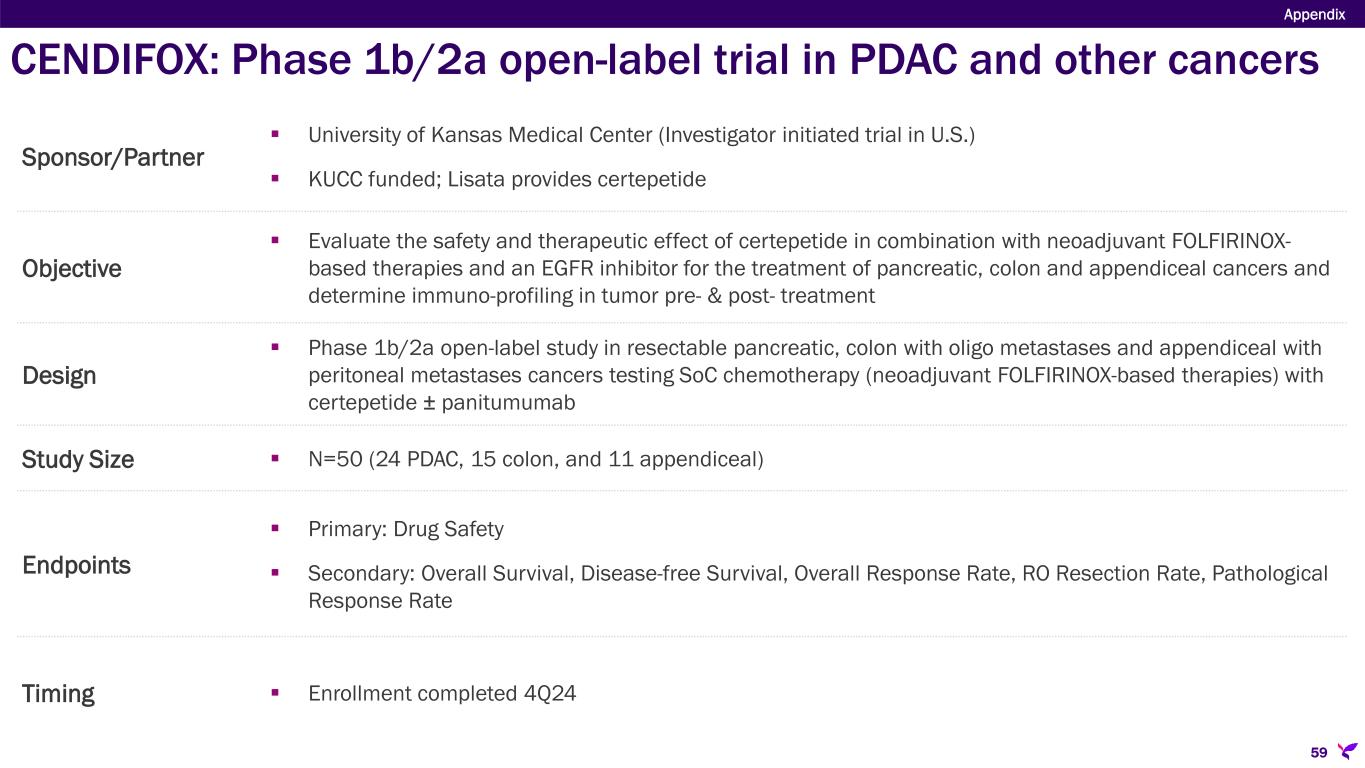
Sponsor/Partner University of Kansas Medical Center (Investigator initiated trial in U.S.) KUCC funded; Lisata provides certepetide Objective Evaluate the safety and therapeutic effect of certepetide in combination with neoadjuvant FOLFIRINOX- based therapies and an EGFR inhibitor for the treatment of pancreatic, colon and appendiceal cancers and determine immuno-profiling in tumor pre- & post- treatment Design Phase 1b/2a open-label study in resectable pancreatic, colon with oligo metastases and appendiceal with peritoneal metastases cancers testing SoC chemotherapy (neoadjuvant FOLFIRINOX-based therapies) with certepetide ± panitumumab Study Size N=50 (24 PDAC, 15 colon, and 11 appendiceal) Endpoints Primary: Drug Safety Secondary: Overall Survival, Disease-free Survival, Overall Response Rate, RO Resection Rate, Pathological Response Rate Timing Enrollment completed 4Q24 CENDIFOX: Phase 1b/2a open-label trial in PDAC and other cancers Appendix 59
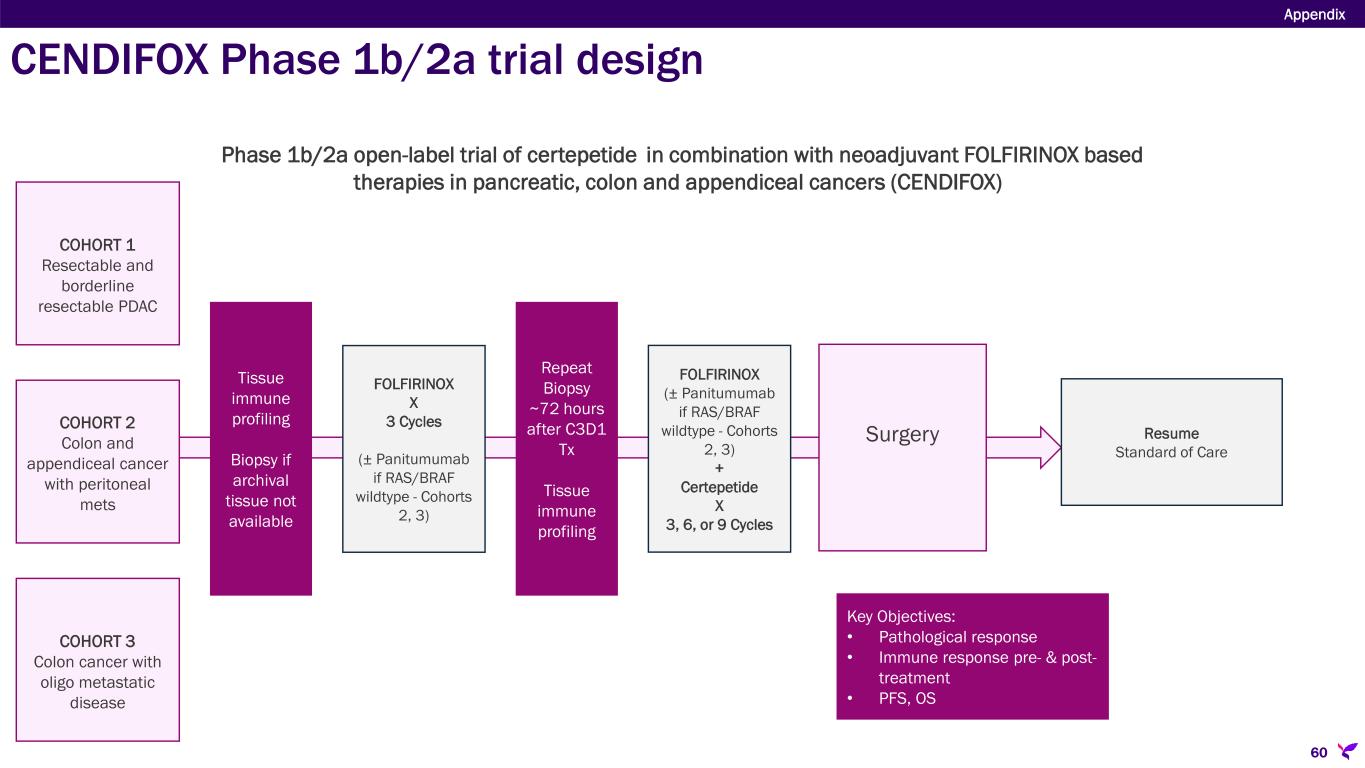
Surgery COHORT 1 Resectable and borderline resectable PDAC Key Objectives: • Pathological response • Immune response pre- & post- treatment • PFS, OS FOLFIRINOX X 3 Cycles (± Panitumumab if RAS/BRAF wildtype - Cohorts 2, 3) Tissue immune profiling Biopsy if archival tissue not available COHORT 2 Colon and appendiceal cancer with peritoneal mets COHORT 3 Colon cancer with oligo metastatic disease Repeat Biopsy ~72 hours after C3D1 Tx Tissue immune profiling FOLFIRINOX (± Panitumumab if RAS/BRAF wildtype - Cohorts 2, 3) + Certepetide X 3, 6, or 9 Cycles Resume Standard of Care Phase 1b/2a open-label trial of certepetide in combination with neoadjuvant FOLFIRINOX based therapies in pancreatic, colon and appendiceal cancers (CENDIFOX) CENDIFOX Phase 1b/2a trial design Appendix 60

Sponsor/Partner Lisata (U.S.) Objective Evaluate the preliminary efficacy, safety and tolerability of certepetide in combination with standards of care in subjects with first- and second-line cholangiocarcinoma Design Phase 2 randomized, double-blind, placebo-controlled, proof-of-concept trial in first- and second-line cholangiocarcinoma testing corresponding SoC with certepetide or placebo Study Size N=69 (1L: N=47, 2L: N=22) 1:1 SoC + certepetide or SoC + placebo Endpoints Primary: OS Secondary: Safety, ORR, PFS Timing Enrollment completed for 1L and 2L CCA BOLSTER: Phase 2 blinded, randomized trial in cholangiocarcinoma Appendix 61

Dosed on Days 1, 8 every 21 days X 8 cycles Disease Progression Response rates Safety Confirm Eligibility Informed Consent Survival Analysis Certepetide + cisplatin/gemcitabine/durvalumab 72-hour run-in without SoC 1st line Cholangiocarcinoma (CCA) Placebo + cisplatin/gemcitabine/durvalumab R Phase 2a, double-blind, placebo-controlled, multi-center, randomized study evaluating certepetide when added to standard of care (SoC) versus standard of care alone in subjects with first- and second-line cholangiocarcinoma BOLSTER Phase 2a trial design Appendix 62 Dosed every 14 days Disease Progression Response rates Safety Confirm Eligibility Informed Consent Survival Analysis Certepetide + FOLFOX 72-hour run-in without SoC 2nd line Cholangiocarcinoma (CCA) Placebo + FOLFOX R
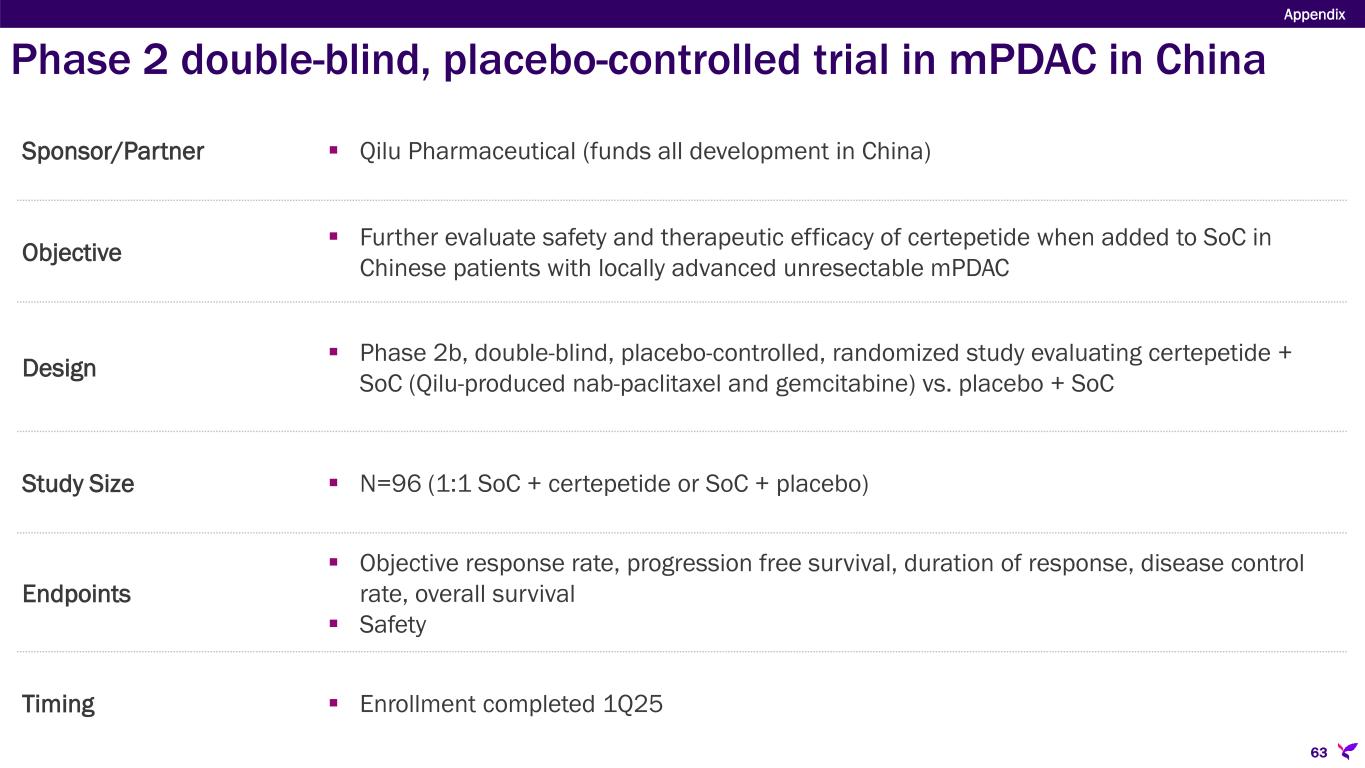
Sponsor/Partner Qilu Pharmaceutical (funds all development in China) Objective Further evaluate safety and therapeutic efficacy of certepetide when added to SoC in Chinese patients with locally advanced unresectable mPDAC Design Phase 2b, double-blind, placebo-controlled, randomized study evaluating certepetide + SoC (Qilu-produced nab-paclitaxel and gemcitabine) vs. placebo + SoC Study Size N=96 (1:1 SoC + certepetide or SoC + placebo) Endpoints Objective response rate, progression free survival, duration of response, disease control rate, overall survival Safety Timing Enrollment completed 1Q25 Appendix 63 Phase 2 double-blind, placebo-controlled trial in mPDAC in China
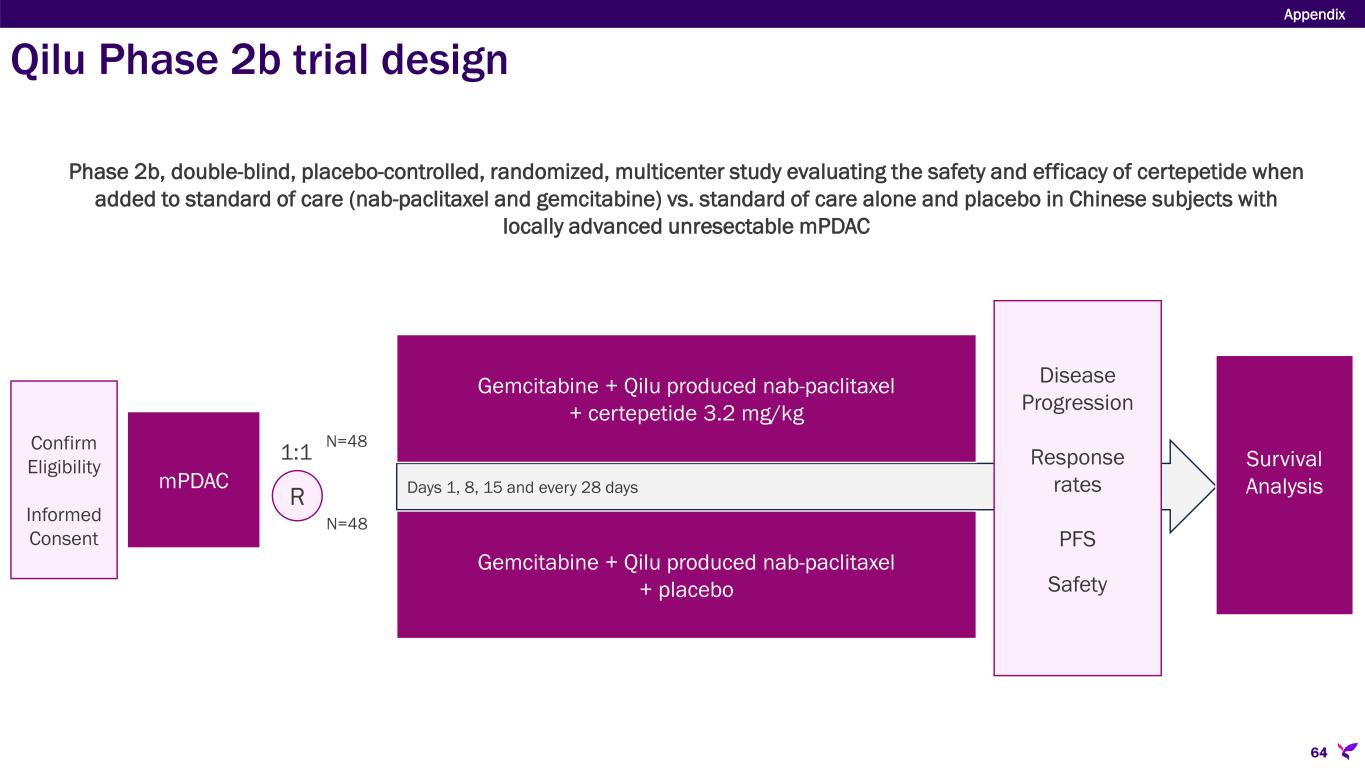
Days 1, 8, 15 and every 28 days Disease Progression Response rates PFS Safety Gemcitabine + Qilu produced nab-paclitaxel + certepetide 3.2 mg/kg Confirm Eligibility Informed Consent 1:1 Survival AnalysismPDAC R Gemcitabine + Qilu produced nab-paclitaxel + placebo N=48 N=48 Phase 2b, double-blind, placebo-controlled, randomized, multicenter study evaluating the safety and efficacy of certepetide when added to standard of care (nab-paclitaxel and gemcitabine) vs. standard of care alone and placebo in Chinese subjects with locally advanced unresectable mPDAC Appendix 64 Qilu Phase 2b trial design
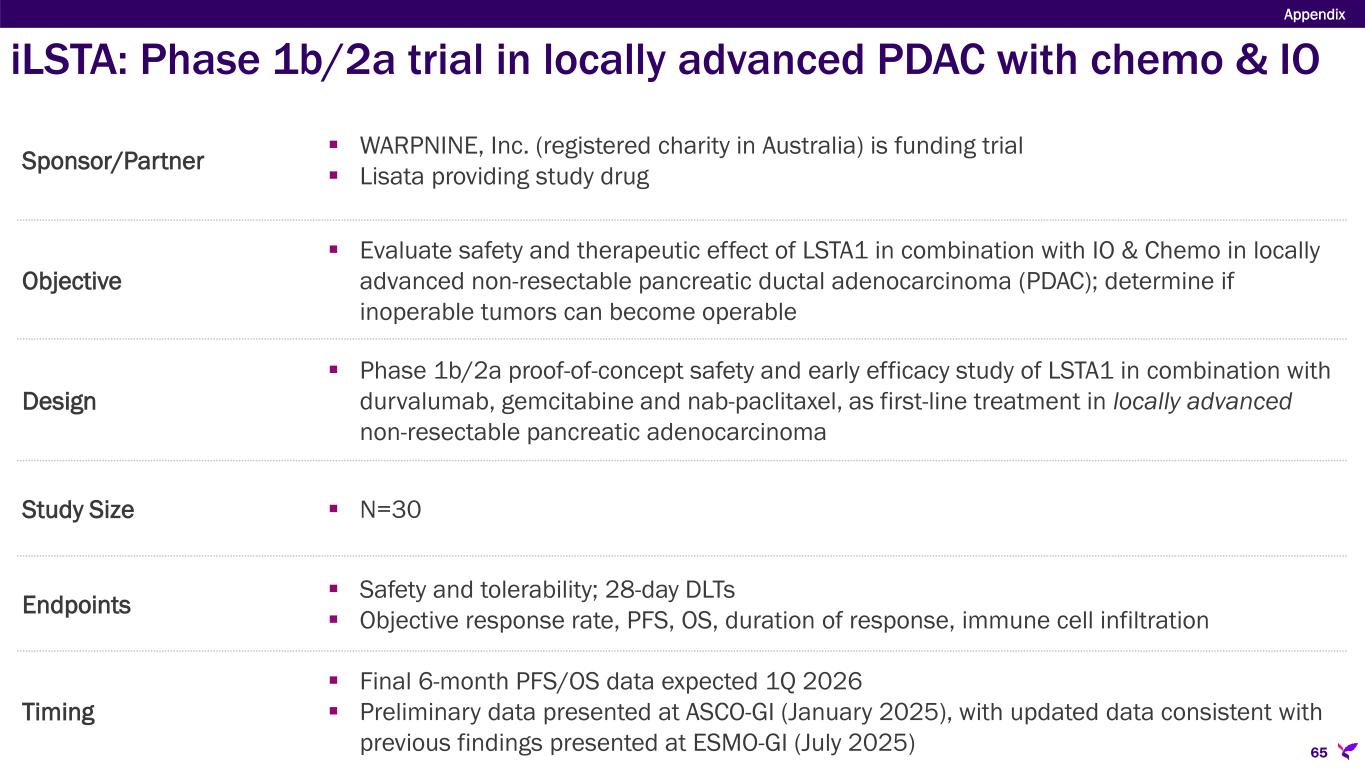
Sponsor/Partner WARPNINE, Inc. (registered charity in Australia) is funding trial Lisata providing study drug Objective Evaluate safety and therapeutic effect of LSTA1 in combination with IO & Chemo in locally advanced non-resectable pancreatic ductal adenocarcinoma (PDAC); determine if inoperable tumors can become operable Design Phase 1b/2a proof-of-concept safety and early efficacy study of LSTA1 in combination with durvalumab, gemcitabine and nab-paclitaxel, as first-line treatment in locally advanced non-resectable pancreatic adenocarcinoma Study Size N=30 Endpoints Safety and tolerability; 28-day DLTs Objective response rate, PFS, OS, duration of response, immune cell infiltration Timing Final 6-month PFS/OS data expected 1Q 2026 Preliminary data presented at ASCO-GI (January 2025), with updated data consistent with previous findings presented at ESMO-GI (July 2025) Appendix 65 iLSTA: Phase 1b/2a trial in locally advanced PDAC with chemo & IO

Cohort 2 Gemcitabine + nab-paclitaxel + LSTA1 + Placebo durvalumab N=5 Cohort 1 Gemcitabine + nab-paclitaxel + Placebo LSTA1 + Placebo durvalumab N=5 Cohort 3 Gemcitabine + nab-paclitaxel + LSTA1 + durvalumab N=up to 20 12 weeks 8 weeks tumor burden assessments until 24 months or recurrence 12 month Follow-up Primary Endpoint 24 months Follow-up completion EUS Biopsy Screening EUS & Biopsy At weeks 12-16 Tumor burden assessment at screening, cycle 2, and then 8-weekly thereafter. Patients are treated with 28-day cycles until surgery, definitive radiotherapy, unacceptable toxicity, progression or death Endpoints: safety, DLT, ORR, PFS, OS, DoR, immune profiling Ra nd om iz e Phase 1b/2a proof-of-concept safety and early efficacy study of LSTA1 in combination with durvalumab, gemcitabine and nab-paclitaxel, as first-line treatment in locally advanced non-resectable pancreatic ductal adenocarcinoma 66 iLSTA Phase 1b/2a trial design gemcitabine 1000mg/m2 : Days 1, 8, 15 in 28-day cycles nab-paclitaxel 125mg/m2: Days 1, 8, 15 in 28-day cycles durvalumab 750mg: Days 1 and 15 in 28-day cycles certepetide 3.2 mg/kg/ Placebo: Days 1, 2, 8, 15, 16 in 28-day cycles Appendix
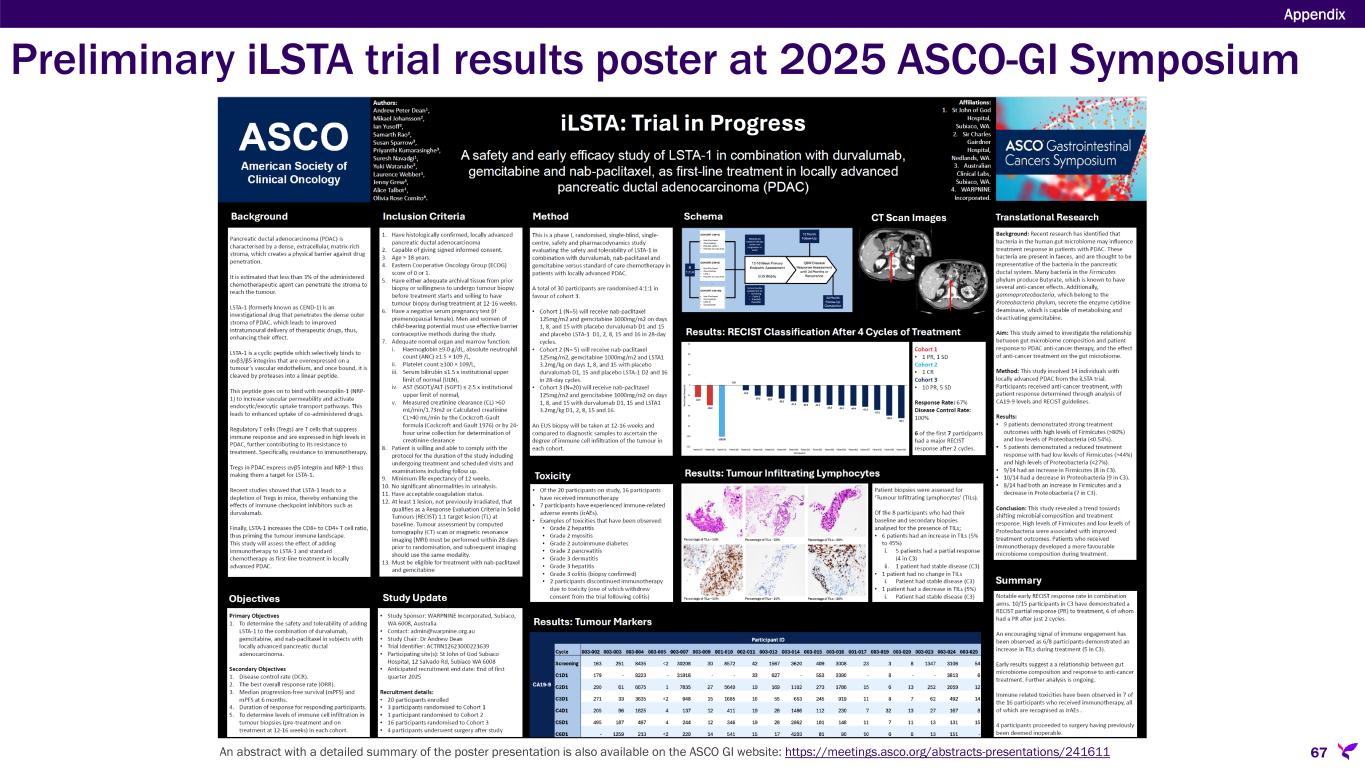
Preliminary iLSTA trial results poster at 2025 ASCO-GI Symposium Appendix 67An abstract with a detailed summary of the poster presentation is also available on the ASCO GI website: https://meetings.asco.org/abstracts-presentations/241611
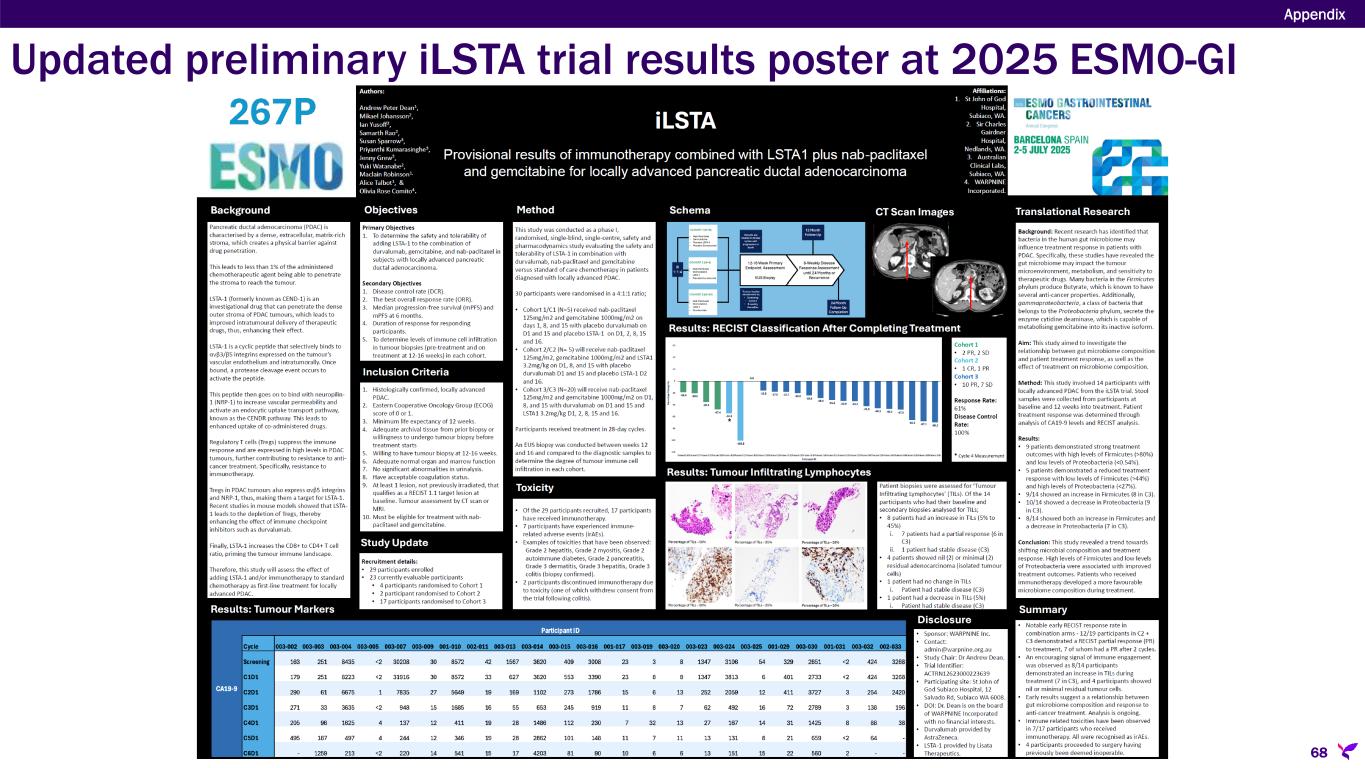
Updated preliminary iLSTA trial results poster at 2025 ESMO-GI 68 Appendix
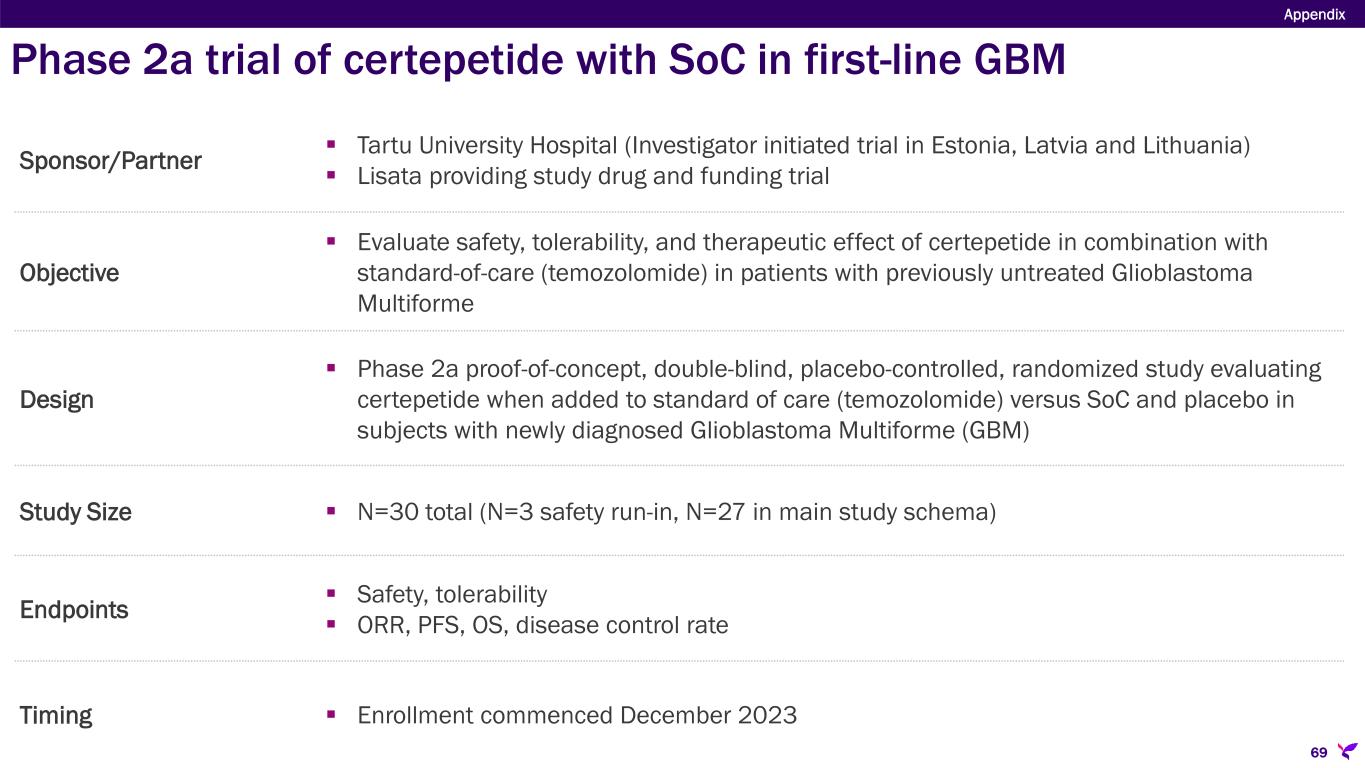
Sponsor/Partner Tartu University Hospital (Investigator initiated trial in Estonia, Latvia and Lithuania) Lisata providing study drug and funding trial Objective Evaluate safety, tolerability, and therapeutic effect of certepetide in combination with standard-of-care (temozolomide) in patients with previously untreated Glioblastoma Multiforme Design Phase 2a proof-of-concept, double-blind, placebo-controlled, randomized study evaluating certepetide when added to standard of care (temozolomide) versus SoC and placebo in subjects with newly diagnosed Glioblastoma Multiforme (GBM) Study Size N=30 total (N=3 safety run-in, N=27 in main study schema) Endpoints Safety, tolerability ORR, PFS, OS, disease control rate Timing Enrollment commenced December 2023 Appendix 69 Phase 2a trial of certepetide with SoC in first-line GBM

Days 1, 2, 3, 4, 5 and every 28 days for 6 cycles Disease Progression Response rates Safety Temodar® + certepetideConfirm Eligibility Informed Consent 2:1 Survival Analysis 72-hour Run-in without SoC Newly Diagnosed GBM R Temodar® + certepetide matching placebo N=18 N=9 Phase 2a proof-of-concept double-blind, placebo-controlled, randomized, proof-of-concept study evaluating certepetide when added to standard of care (temozolomide) versus temozolomide and matching certepetide placebo in subjects with newly diagnosed GBM Appendix 70 GBM Phase 2a trial design Main Study Schema Safety Lead-in Schema Confirm Eligibility Informed Consent Newly Diagnosed GBM 3-Day Run-in N=3 TMZ + certepetide Safety AnalysisCertepetide on Days 1, 2 which is repeated after 28 days for 2 cycles * TMZ + certepetide Days 1, 2, 3, 4, 5 and every 28 days for 4 remaining cycles • TMZ will be administered on Days 1, 2, 3, 4, and 5 of each cycle Disease Progression Response rates Safety Survival Analysis